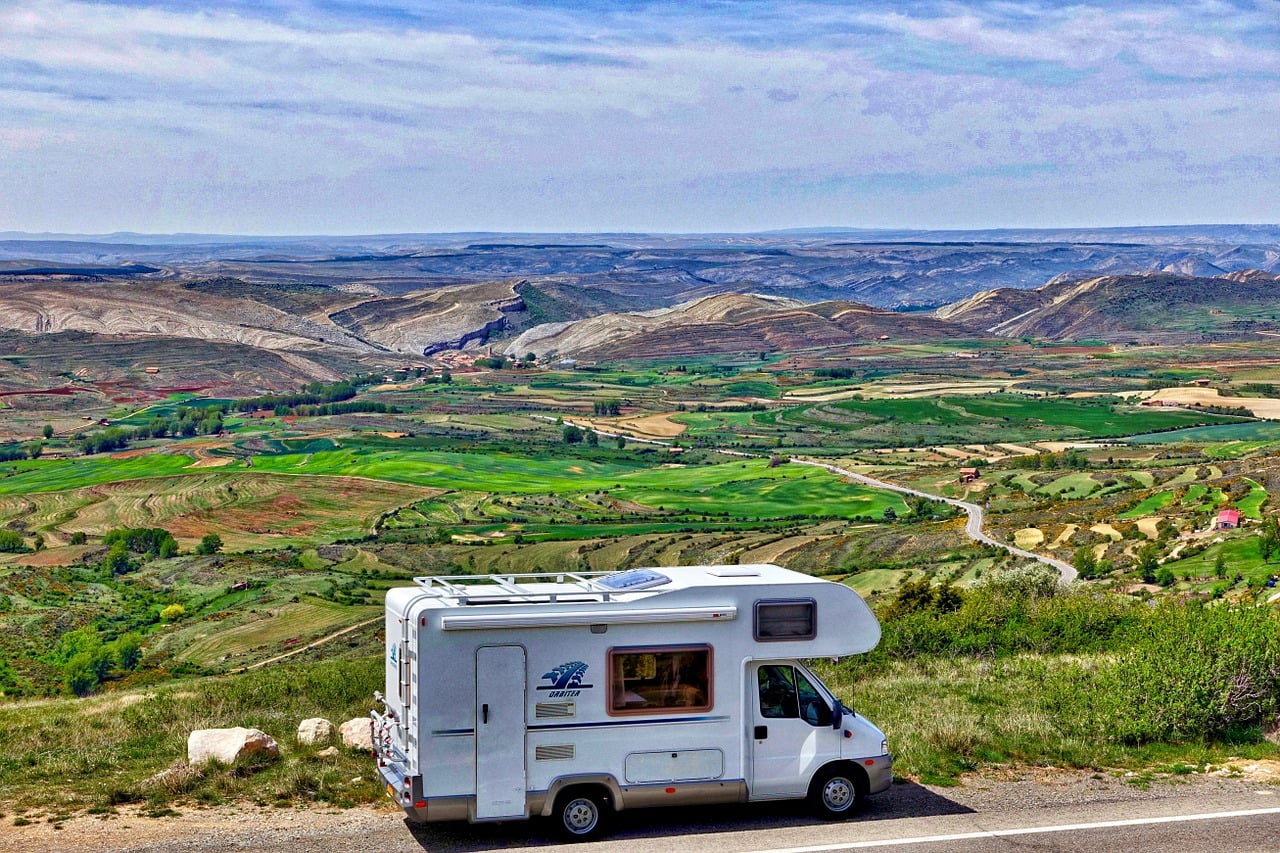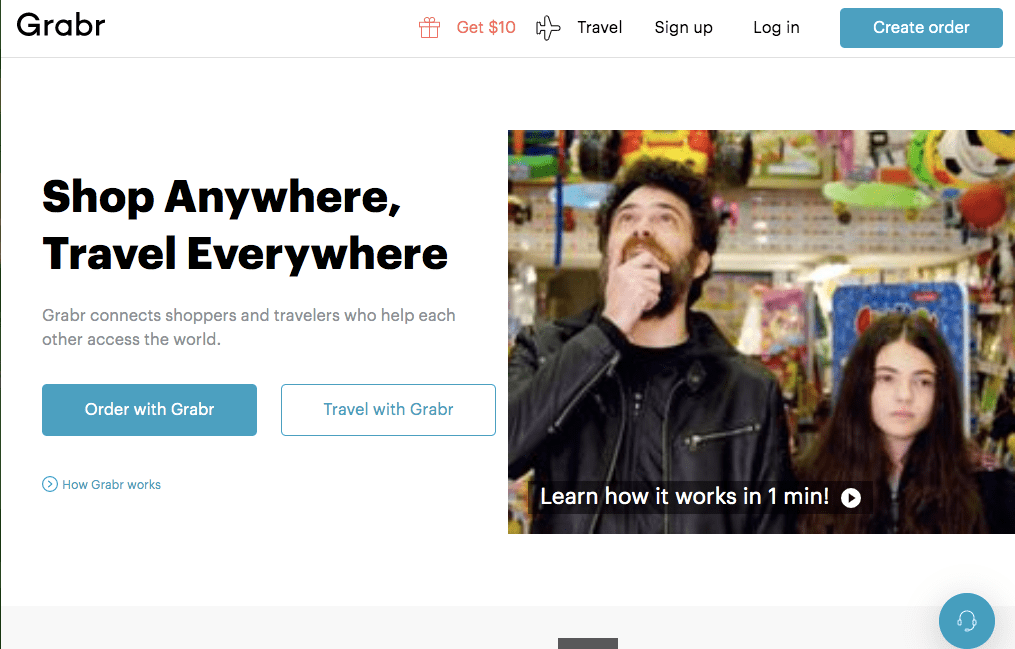The 61 Best Travel Jobs (+ Other Ways) To Make Money While You Travel
Prima facie, the expression “travel jobs” might appear to be an oxymoron.
How can travel, a leisure activity that traditionally has provided respite for people from their stressful and mundane jobs, have anything to do with work?
For most people, travel and work are two separate spheres of existence that don’t mix. Work is work and travel is play, a leisure pursuit. But the term “travel jobs” seems to suggest that these two aspects of our existence are reconcilable.
What if it were possible to blend work and play together so that they are not mutually exclusive parts of our lives, but become one and the same?
Most of you reading this probably have a full-time or part-time job that requires you to live and work in a single location for the better part of the year.
You try your best to save some of your earnings, and you might squeeze in a few brief domestic or international leisure trips during time off at weekends or during longer holiday periods when you’re granted several weeks or months of playtime.
Now, this arrangement can definitely work for a lot of people and there’s nothing wrong with it all, but for those who would rather shift their life balance more towards travel and leisure, who would rather work to live than live to work, there is a better way.
What if it were possible to travel and explore the world continuously while making a living at the same time?
Even working and living as an expat in a foreign country would put you in a much better position for discovering that part of the world than being stuck at home and being thousands of miles away from the places you’ve always dreamed of visiting.
As an expat living abroad, you’d probably be just a short bus or train ride away from all kinds of incredible places that you could travel to during your time off work.
Well, the positive news is that it certainly is very achievable for most people to work and earn money while travelling around the world, and this is largely thanks to the availability of travel jobs – jobs where having a fixed geographic location is optional or where travel is actually obligatory due to the nature of the job.
There are literally dozens of these travel jobs and other income-generating methods that allow people to combine their insatiable wanderlust with their requirement to earn a living.
There have always been travel job opportunities, but the recent rise of the remote working phenomenon and the increasing availability of online job opportunities have widened the range of possibilities even further, making it possible to work from anywhere in the world that a stable and reasonably fast Internet connection can be secured.
In this article, we’re going to explore the phenomenon of combining travel or living abroad with earning a sustainable income.
We’ll be covering all the best travel jobs, both online and offline, as well as dozens of other creative ways to generate an income on the road.
1. Why have a travel job?
3. The 61 Best Travel Jobs & Other Ways To Make Money While Travelling
4.15 Fulfilled By Amazon (FBA) seller
4.17 Professional online gambler
5.0 Part 2: Jobs that require travel
5.5 Sailboat or yacht crewmember
5.8 Freelance travel photographer
5.10 Import & sell foreign goods
6.0 Part 3: Jobs that allow you to travel
7.0 Part 3: Backpacker travel jobs
7.1 Harvesting and fruit picking jobs
7.5 Busker (or other street performer)
7.10 Extra in a movie or music video
8.0 Part 4: Volunteering & unpaid travel jobs
Travel job categories
Travel income opportunities can be grouped into five main categories.
Online travel jobs
Online jobs are jobs that involve working on a computer and interacting with the Internet. Think jobs like copywriter, virtual assistant, online English tutor or travel blogger.
Online jobs epitomize the digital nomad lifestyle, where the idea is to work from your laptop using free Wi-Fi (at airports, restaurants, cafés, hotels etc.) or a cellular Internet connection while travelling around the world.
As the holder of an online job, you might work as freelancer that decides your own hours and works on a project basis, or you might be a remote worker for a company that has less flexibility in terms of how many hours you need to work each week, but is still location independent.
Online jobs often grant travellers the greatest degree of location independence, but spending hours hunched over a laptop on some days admittedly isn’t for everyone.
Backpacker jobs
These are short-term, casual jobs that are often picked up during a trip by young backpackers who are running out of money, but want to extend their journey for several months.
Common backpacker jobs include fruit picking, farm work, bartending and hostel work. They are mostly unskilled and often quite physical jobs that don’t require any educational qualifications or prior experience to get hired.
Many of these jobs will pay under the table too, making them the only option for cash-strapped travellers who only possess a tourist visa that doesn’t permit them to legally undertake any paid employment during their stay.
Jobs that require travel
There are certain jobs, like those of the flight attendant or cruise ship worker, where travel is an inescapable part of the job itself.
If you’re working on board a cruise ship or as a flight attendant, for example, you are going to inevitably be travelling and seeing new parts of the world while you’re performing your duties.
There are other jobs, such as that of the travel agent, that require regular trips abroad as part of the job or in order to be able to do the job properly.
#4 - Jobs that allow you to travel
There are a lot of jobs that don’t necessarily involve travel and may not require it at all, but that can be easily adapted to work for those wanting to lead a nomadic lifestyle.
Seasonal jobs, for example, are very conducive to a nomadic lifestyle because they involve a brief in-season of very intensive labour where you can earn a lot of money in a short period of time, followed by a long slack season, during which time you'll be able to travel with all the money you saved.
Jobs where you can get hired on a short-term basis, or that can be done in a freelancing capacity where you source your own clients in the destination you're visiting, also work well for those seeking a nomadic lifestyle.
We could also include expat jobs like teaching English abroad in this category. While many expat jobs might require one to remain rooted in a particular locality, they put travellers in locations that can be used as a springboard to easily travel and explore new countries.
Many instructor jobs (scuba diving, surfing, skiing) fall into this category, as do other jobs like massage therapist, chef and DJ.
The 61 Best Travel Jobs & Other Ways To Earn Money While Travelling in 2021
You can edit text on your website by double clicking on a text box on your website. Alternatively, when you select a text box a settings menu will appear. your website by double clicking on a text box on your website. Alternatively, when you select a text box
Part 1: Online travel jobs
You can edit text on your website by double clicking on a text box on your website. Alternatively, when you select a text box a settings menu will appear. your website by double clicking on a text box on your website. Alternatively, when you select a text box
#1 - Travel Blogger
Travel blogging just makes a lot of sense as a way to earn money while travelling.
After all, you're taking loads of beautiful photographs and garnering tons of interesting new experiences to write about each day, so it seems to make the most sense to blog about travelling when you're travelling and not something else.'
Travel blogging, however, is very competitive nowadays but the rewards are immense for those who persevere long enough and work smart enough to reach the top of the pyramid.
It has been said that 95% of blogs and are abandoned and fall into dereliction soon after being created, probably because most people start blogging with expectations of overnight riches and then get disillusioned when their blog is still generating a negligible amount of revenue after having invested several months of hard graft into it.
But many of those who persevere through the initial struggle of getting the business off the ground and stick around for the long haul go on to turn their blog into an income-generating machine that pulls in more than six figures annually.
Travel blogs generate income in a variety of ways, but the one key element for a travel blog (or any blog for that matter) to be able to make money is traffic.
Here are some of the most common ways that travel blogs generate income:
Sponsored tours and press trips
Private tour companies, tourism boards, hotels and resorts are often willing to sponsor a travel blogger’s entire trip (accommodation, meals, transportation, activities, guides etc.) in exchange for coverage of their brand/hotel/destination on the blog. Some trips may also include monetary compensation, although most do not.
As part of the deal, the blogger might be asked to write x number of articles about the trip and may have to sign a written agreement promising to deliver the content within a certain timeframe.
Sponsored trips can be either solo trips or may involve a large group of bloggers all travelling together on a press trip.
It’s usually only popular travel bloggers who receive sponsored press trip invitations, but upcoming bloggers can also pitch brands or the PR agencies representing the brands rather than passively waiting around to be invited.
If you do land a sponsored trip, it’s important that it aligns with your readership and is tailored to your audience, otherwise it’s better to decline.
Ambassadorship
A brand ambassadorship is when a travel blogger establishes a more long-term relationship with a brand where he/she becomes an ambassador for that brand. The blogger will promote the brand in various ways; by writing articles to promote the brand, placing the brand’s ads in their sidebar, posting about the brand on social media etc.
Affiliate links
Travel bloggers help many brands and companies to make more sales by writing articles in which they recommend and link to products and services that they use or endorse.
Companies provide travel bloggers with special affiliate tracking links to place on their blog to ensure that the blogger gets credited and rewarded if one of their readers buys a product or service from the company after reading about it on the blog.
If a reader clicks a special affiliate tracking link while reading one of the blogger’s articles and subsequently purchases one of the company’s products or services within a certain timeframe (typically 30-60 days) after clicking the link, the travel blogger receives a commission from the company for referring the reader.
Many blogs also post referral links through which their readers can sign up for accommodation-booking platforms like Airbnb. When a reader signs up through one of these referral link, the blogger will earn credits that can be redeemed for free or discounted room nights when they travel.
Large travel blogs can have affiliate relationships with dozens or even hundreds of different companies, and although most commissions are relatively small, the cumulative earnings from dozens of different advertisers each month can be pretty significant.
Display advertising
Travel bloggers can join ad networks like Google AdSense and MediaVine to have advertisements displayed on the pages of their website.
The ads will usually be for products and services relevant to travel so that they’ll get more clicks from readers of the blog. More clicks translate into more earnings for the blogger if a PPC (pay per click) model is being used by the ad network.
Some ad networks are pay per view (PPV) however, which means that publishers get paid based on how many times advertisements are viewed on their website, regardless of whether anybody clicks on them or not.
The more traffic the travel blog receives, the more impressions and clicks the ads displayed on the website will receive, and the more income the blog will be able to generate each month from display advertising.
The amount earned also depends hugely on which ad network the blog is using; MediaVine for example, pays a lot more than Google Adsense, although in order to join your blog must have at least 25,000 monthly sessions.
Sponsored posts
Travel blogs that receive a reasonable volume of traffic are contacted regularly by brands and companies who would like to have a piece of content they’ve written published on the travel blog in order to promote their own product, service, website or another piece of web content that they’ve produced.
The company will almost always include a link to the product/service/website/piece of content in the article they’ve written.
In other cases, the brand or company will ask the travel blogger to write the piece of promotional content, or the blogger will insist that he writes the article to ensure that the voice on the blog remains consistent.
In any case of publishing pre-written promotional content that benefits someone else, the travel blogger can charge a fee, but in the case where the blogger also has to produce the promotional content, it’s possible to charge the advertiser extra due to the additional time and effort it takes.
Text link placements
Travel bloggers frequently get contacted by website owners or SEO companies that want to place a link pointing to their own website or to one of their client’s websites within a piece of existing content on the travel blog.
The company or webmaster will often specify a particular article and a particular location in the article where they would like the desired link to be placed. They will usually be looking for a contextual link, or a piece of clickable text within the main body of written content of the web page.
Depending on how authoritative the travel blog is and how much high-quality traffic it receives, bloggers can charge a minimum admin fee of $50 for a link placement and some will charge upwards of $300. Not bad for a few minutes work.
However, placing links in exchange for money is against the Google terms of service and bloggers might face a Google penalty and see a crash in their rankings if they overexploit this source of income and get caught.
Not to mention the fact that some of these websites asking for links can be a bit shady and they might have nothing to do with the travel industry.
Consulting
Travel bloggers who become popular will have people contacting them looking for advice in planning trips to their dream destinations.
Bloggers will usually answer one or two questions for free, but if someone is looking for detailed information and wants the blogger to basically plan their entire trip and create an itinerary for them, the blogger can charge a consulting fee for their expertise.
#2 - Freelance Writer

Growing a blog to the point where it starts to generate enough income to make a living can take years, but if you’re reasonably talented with a pen (or a keyboard) you can start earning almost right away by working as a freelance writer.
When you’re travelling, it might make the most sense to write about your everyday observations and interactions with foreign cultures or to create practical travel guides for the destinations you’ve visited, since your travels will be providing a lot of fodder and inspiration for your pen.
Freelance travel writers can get paid to write articles for travel blogs, travel websites, travel magazines, news sites, business magazines, local and regional print media, and more.
You don’t need a degree in journalism or any other kind of educational qualification to get featured in publications; all that's required is an engaging writing style and an interesting topic to write about or a riveting personal story to share.
Many travel-related websites have a paucity of content but plenty of money to pay skilled writers to populate their sites with compelling content that they hope will bring them more traffic and readers. Rates vary widely but most sites pay somewhere between $50 to $100 for a 1,000-word article, and they’ll often pay extra if you can supplement your piece with high-quality original photos.
If you have a blog that you’re trying to promote by writing content for other people's websites, you may be able to link back to your own blog from your articles and still get paid, although some websites will only pay for articles that are non-promotional.
Some websites also run regular competitions for travel writers, where the person with the winning submission can receive a prize of $1,000 or more, although you could certainly squander a great deal of your time and effort participating in these types of contests if your writing isn’t absolutely top rung.
Of course, you don’t necessarily have to write about travel just because you’re travelling; you can write about virtually anything that you have some degree of expertise or experience in.
There are many ways to go about finding work as a freelance writer.
You can start by searching online for a list of websites, blogs and online magazines in your field of expertise that are paying writers for content. If you want to write about travel, this article provides a substantial list of travel-related websites that will pay for high-quality content.
You could then start contacting those sites and pitching them with topic ideas that you think would perform well on their site, or you can ask them if there’s any particular topic they would like you to write about.
You might not feel qualified to write about every topic they suggest, so it’s good to also have your own topic suggestions.
Webmasters will also usually want to see a sample or two of your writing to make sure that you’re not going to publish drivel on their site. The more articles you get published on different websites, the more social proof you'll have and the easier it will be to get your work published on more prestigious websites.
Another way to find work as a freelance writer is to go onto freelancing platforms like Upwork and Textbroker.
You can bid for projects on these sites and as you build your reputation and portfolio, new clients will eventually start coming to you without you having to go look for them. See this page for a list of the best freelancing platforms for finding legitimate writing gigs.
How much you can earn as a freelance writer depends on what you’re writing about, which websites you’re writing for, how good you are at writing and other factors. If you can secure a steady supply of work, you can definitely earn upwards of $3,000 a month as a freelance writer.
However, getting a steady supply of work can be a problem for many freelance writers. If you want to earn a stable income, it’s better to find one website or magazine that needs you to write multiple articles for them each month; that way you aren’t constantly pitching to different websites and wasting most of your time finding gigs when you could be writing and earning money for each new word written.
Additional resources:
List of magazines and websites that pay freelance travel writers
#3 - Affiliate marketing

Affiliate marketing is a type of marketing where brands pay their “affiliates” commissions for sales that the latter helped them to generate by referring buyers to the brands’ products and services.
Affiliate marketing is most associated with online marketing, but it can also be used by brands to promote products and services in an offline context. However, here we’ll we focusing on affiliate marketing as a way to earn money online.
With online affiliate marketing, the brand (known as the advertiser) will usually provide the affiliate partner (known as the publisher) with a special tracking link that directs anyone who clicks on it to the brand’s website, at which point the person may go on to purchase a product or service from the brand.
The affiliate will publish this special tracking link in various contexts on the Internet where those products and services might be of relevance or value to people.
The affiliate might place the link on a special landing page (a special one-page website) that they've created to talk about the product or service, or they might post it on social media platforms like Facebook and Instagram, or in online forums like Reddit and Quora.
The tracking link will have a unique identifier for the affiliate embedded within the URL in order to ensure that the affiliate gets credited for any sales he helps to generate.
Tracking links work by placing a tracking cookie within the shopper’s web browser, so that even if the shopper waits a few weeks or even a couple of months to purchase the product or service after clicking the link, the affiliate will still be credited with the sale. These cookies typically have an expiry period of 30 days, but some can last for 90 days or longer.
The commission paid to the affiliate can be a fixed amount for a certain action, like $30 for a new customer registration, or it might be percentage-based, like 15% of the total sale amount.
As we discussed above, travel bloggers are often affiliates of many brands and companies whose products and services they personally uses or espouse.
However, while it may be easier to be accepted as an affiliate partner by some brands if you have your own website, you don’t necessarily have to run your own blog or website to be an affiliate marketer.
All you need to do is find products, services and offers that you want to promote and have an effective way of promoting them, which means having a source of traffic that’s going to be interested in buying whatever it is that you’re promoting.
This traffic could come through a business page on Facebook, through an Instagram account with thousands of followers, through Pinterest groups, through paid Google or Facebook ads, through leaving links in comments below YouTube videos, and so on.
Once you have found a product or service to promote and a source of traffic that’s a good fit for it, the next step is to try to become an affiliate partner of the brands and companies that sell the product or service that you wish to promote.
To become an affiliate partner of a brand, you would normally sign up for their affiliate program, which can often be done through a page on the company’s website.
Other times, you will have to email the company in order to join their program or apply for their affiliate program through what’s known as an affiliate network, which is a website that aggregates hundreds or thousands of different affiliate programs from different brands and acts as an intermediary between publishers (that’s you) and advertisers.
Companies can often be choosy about who they’ll allow to join their affiliate program, as they don’t want to partner with publishers who are going to misrepresent their products and services or who aren’t going to be able to refer them a worthwhile amount of new leads.
An application to join an affiliate program can often take days or even weeks to be approved, but once you’re accepted, you can immediately start promoting the products and services that you’re interested in.
The more traffic and in particular, the more targeted traffic (the right kind of people) you can drive to your affiliate links, the more money you can make as an affiliate marketer.
It’s really a numbers game, where more targeted traffic results in more clicks (of the affiliate links) and more clicks result in more sales, which result in more commissions.
A certain percentage of people - known as the CTR or click-through rate - who view your advertisement (this is known as an “impression”) will click your affiliate tracking link and out of those clickers, a certain percentage (known as the click conversion rate) will buy the product or service, either on the spot or at some point before the tracking cookie expires.
The sky is really the limit when it comes to how much you can earn with affiliate marketing, as there are hundreds of products and services to promote out there, and millions of people wanting to buy them.
It all depends on how much high-quality traffic you can drive to your advertisement, how good you are at promoting the product or service, is and how good the brand is at converting people that come to its website to check out its products and services.
There are affiliate marketers making more than seven figures, although it will take a lot of time and hard work to build up to a number like that.
The income from affiliate marketing is more passive than many other types of income too (although a lot of work needs to be invested initially), as once you’ve got the affiliate links in place and traffic is flowing to them, the commissions will start to roll in even while you sleep.
The nice thing is that unlike the seller, you won’t have to deal with taking payments, packaging and shipping the product, refunds and returns, after sales support and so on.
#4 - Social media influencer

Starting your own website doesn’t sound so appealing?
Many travellers have built sizeable audiences on social media platforms like Facebook and Instagram, and have found various ways to monetize their popularity without owning a website or having any other platform of their own to sell products on.
If you grow a large following on Instagram, for example, advertisers will be willing to pay you to place a link to their products and services in your bio.
Holders of smaller Instagram accounts wanting to gain more followers will be willing to pay you for “shoutouts”, which is where you mention another person's Instagram account in one of your Instagram posts and encourage your followers to check it out and follow it.
Instagrammers can also make money from sponsored posts in which they explicitly promote a brand’s product or service. Brands will often a free sample of their product to influencers so that they can show it to their followers in photos, short videos or Instagram stories.
Account holders can place affiliate links in their bio (only one link is permitted) and accounts with more than 10,000 followers can also use the “swipe up” feature to direct viewers of their Instagram stories to an affiliate link.
Popular Instagrammers will often sometimes license their photos or clips from their videos to companies or individuals for a fee, whether the entity wants to use the content for their website, their social media accounts or for a personal project.
Facebook users with a large fan base can also monetize the content they post on the platform in a variety of ways, such as in-stream ads (ads running before, during or after videos), fan subscriptions (for those followers that want access to exclusive or bonus content), sponsored posts, subscription groups and affiliate links.
YouTube is another popular that some people have made a lot of money from. Videos can be monetized by running ads on them, which typically earn the channel owner around $0.50 to $1 for every 1,000 views. The number can go higher than this however, depending on the target audience and their location.
If that doesn’t seem like much money, it might be because YouTube itself takes a large cut (almost half) of the ad revenue. Unless a video goes viral or is being released to a huge fan base that has been built up over several years, it’s unlikely to garner enough views to generate a substantial amount of revenue.
Luckily, there are plenty of other ways to monetize a YouTube channel before one has built up a large subscriber base.
Sometimes big companies will want to use some of the clips from a creator’s videos in one of their own videos and they’ll pay money for it. Matador Network once paid me to use up to 45 seconds of clips from my Cherrapunji video in a short video that they shared on their Facebook and Instagram pages.
Also, if you create a viral YouTube video, there’s a good chance you’ll be contacted by a big viral video company like Unilad, Jukin Media or Viral Hog offering to get your video licensed to big TV and media outlets like BBC, Fox News, Channel 4, ITV, MTV, NBC, Daily Mail and so on.
These companies have the major connections and if they can manage to get clips from your viral video licensed to a major media outlet, there’s the potential for you to make several thousand dollars. Often, they’ll be looking for a 60/40 or a 70/30 revenue split, where you get the larger share.
Creators can also produce sponsored videos that promote brands, or they can place affiliate links to products and services that they review in their videos in the video descriptions.
Fans of YouTube channels can also support their favourite creators on a crowdfunding platform called Patreon.
When fans become patrons of a channel on Patreon, they might pay a recurring monthly fee or alternatively a “per creation” fee (popular for creators that post infrequently), and in exchange for their contribution they can receive perks like early viewing of new content, access to exclusive content, ad-free viewing, greater ability to influence upcoming content, and so on.
Creators can create multiple membership tiers, such that patrons that pay more receive more perks. They can also just offer the same perks to all their supporters and let each one pay whatever they want or whatever they can afford. For more on how Patreon works, check out this article.
#5 - Online English teacher

Instead of teaching English to students within the four walls of a classroom in the traditional way, you could teach it online through your laptop’s webcam, thereby enabling you to teach from anywhere in the world that you have a fast and stable Internet connection.
There’s already massive and still growing demand (especially from China, but also South Korea, Japan, Taiwan, Vietnam and other countries) in the world for online tuition in the English language. In fact, as of 2021, there are approximately 2 billion people learning English online.
A host of online teaching companies like VIPKid, Cambly, EF Education First, Magic Ears and GoGo Kid have sprung up in recent years to meet the demand for online tuition. Many of these companies are based in China or other Asian countries, although EF Education First is based in the USA.
If you’re interested in teaching English online, these companies will connect you to students in different countries around the world. You just have to get onboarded by the company first, which usually involves submitting an application and having an interview.
Many online English teaching companies have their own teaching platform with all the required software integrations to communicate and interact with students, which means that you probably won’t have to download any new apps or programs. Companies that don’t use their own platform often use Skype.
Class length varies from company to company but the typical length is 25-30 minutes. Some companies will require you to work a specified number of hours per week, while others allow you to set your own schedule.
The companies usually plan out all the lessons themselves, so your job is merely to deliver them. They’ll also usually take care of the correcting of tests and homework, dealing with disgruntled parents and the other responsibilities that a teacher in a real physical classroom would normally have.
With many companies you’re going to find yourself working with Chinese kids in the 4-12 age range, although some platforms do deal with older students, students from countries other than China, and some take students from all over the world.
With some companies you’ll work one-on-one with students, while in others you’ll work with small groups that are typically no larger than 4 members.
The standard requirements to teach English online are that you must be a native English speaker (or at least a highly fluent non-native English speaker) from the UK, Canada or the US (sometimes nationals from other countries where English is natively spoken are accepted too) and teachers must also have a computer with a microphone, webcam and a fast and stable Internet connection, as well as a quiet, interruption-free environment from which they can teach lessons.
A fast and stable Internet connection is very important, as teachers can be financially penalized for cancellation of a class by some companies if their Internet connection drops for even a few minutes.
The most sought-after personal qualities in online English teachers are passion and enthusiasm for the job, as an excited teacher will usually achieve better learning outcomes among his/her students if all other things are equal.
TEFL certificates and/or a bachelor’s degree (or current enrollment in one) are required by some companies but not all. However, getting a TEFL certificate will better prepare you for the demands of the job and will mean that you won’t have to jump head first into the deep end.
If you don’t have a TEFL certificate and you don’t want to go through the hassle of getting one, then look into companies like Cambly, Skimatalk and Preply, which don’t require one at all.
EF Education First does require a TEFL certificate but only a 40-hour one, which is much easier to obtain than the standard 120-hour certificate. It can be obtained on mytefl.com.
With a few exceptions, you can teach English online from anywhere in the world as long as you meet all the requirements. There are certain companies (i.e. Qkids) that require you to actually be physically present in your native country to work for them, but this is the exception rather than the rule.
You might be wondering if you need to be able to speak Chinese if, for example, you’re teaching English to Chinese kids. The answer is “no”.
This is because the students will be already competent enough at English to be taught the language entirely in an English medium, and schools actually want their students to be completely immersed in the English language by having them taught by a person that can’t speak a word of the students’ native language.
If you’re looking for something a bit more informal where all you’re expected to do is help Chinese students practice their English conversational skills and where the barriers to entry are relatively low, Cambly would be your best bet, although they only pay $10.20 an hour and there are no guaranteed hours.
Still, one my American cousins funded his Thailand trip a couple of years ago by casually chatting to Chinese students for a couple of hours each day through Cambly, and he said he was earning more by doing that than what his girlfriend was earning by teaching English in a physical classroom at a local Thai school.
The typical pay for an online English teacher ranges from $10 to $25 an hour, although some companies pay per minute rather than per hour.
You can also earn extra bonuses from some companies if you work during holiday periods like Christmas, as well as generous referral bonuses (e.g. $100) for getting other teachers to join the platforms.
Those with TEFL certificates and/or a bachelor’s degree can work with the more finicky companies like GoGoKid, Magic Ears and VIPKID that often pay more towards the higher end of the scale ($20+/hour).
Sadly however, most of the best-paying companies only accept teachers that are from Canada, the USA or the UK.
#6 - Web developer

Underlying the aesthetically pleasing, user-friendly interface of the Internet that we interact with on a daily basis is a maelstrom of convoluted coding language without which the web as we know it simply couldn’t exist.
Web developers are the people that understand how to use the various coding languages to literally build the Internet. They are the reason that websites can exist in the first place and can function correctly (most of the time), which is something many of us take for granted.
Web developers normally build and maintain websites, applications and software programs for web designers, companies and individual end users.
They work closely with web designers in much the same way that architects work closely with engineers and construction workers.
Web designers first come up with the design or the vision for how a website should look and feel, and web developers then bring that design to life and turn it into a real, functioning website or application.
In addition to building functional websites and applications, web developers are also regularly needed to identify and fix bugs that prevent systems from functioning optimally.
They can work either as an employee for a web development agency or as independent contractors (freelancers), where they can advertise their services and bid for projects on freelancing platforms like Upwork.
The freelance approach offers more freedom and flexibility but requires a lot of work at the outset to build up a loyal client base that will ensure consistent income from repeat business.
Those web developers working for employers will most likely be working remotely for some if not all of the time, so travelling should be very possible as an employed web developer.
If you were thinking about becoming a web developer, now is definitely a good time to get started, as demand for this skill is growing much faster than the average for all occupations.
The coronavirus panic has also accelerated the trend of growing reliance on the Internet and dissociation from the physical, non-digital world, which means more work for web developers.
To become a web developer, you need to first decide what niche you’d like to work in, as that will determine the path you take with respect to what programming languages you’ll concentrate your efforts on learning.
There are three main types of web developers, namely frontend or client-side developers, backend or server-side developers and full-stack developers.
Frontend developers build the interface that users see and interact with when they visit a website. They deal with the “face” of the website, which includes the colourful buttons, scroll bars, fonts, links, images, the layout of the content on the web pages, the site’s responsiveness across different devices, and so on.
Backend developers work with the brain of a website, which powers it from behind the scenes. The backend or brain of the website has to communicate with the frontend to keep everything operating smoothly.
It deals with the storage, organization and distribution of the website data, which it sends to the frontend when the user makes a request for the information. Think about what happens when you click a button, submit a form or post a picture to a social media platform like Facebook; it’s the backend that determines what happens when you perform these actions.
The third type of web developer, the full-stack developer is competent in both frontend and backend development. They are all-rounders and usually have many years of experience working within the industry in a variety of roles.
Another type of developer is the mobile app developer, who specializes in developing Android or iOS mobile apps. iOS app developers have to be fluent in a language called Swift, while Android app developers use Java.
You don’t need any formal qualifications or background in tech to become a web developer. You can learn everything from scratch.
Regardless of what kind of developer you want to become, it’s customary to begin by learning the fundamentals of HTML (a markup language) and CSS (a style sheet language), which both operate in a web browser and are therefore considered frontend languages.
HTML governs the basic layout and features of a web page, while CSS makes everything look pretty.
After learning the fundamentals, those wanting to become frontend developers will normally move onto learning some Javascript, which is a frontend programming/scripting language that allows for the implementation of more complex dynamic effects on web pages, like dropdown menus and carousel sliders.
Those wanting to go into backend development will start learning programming languages like PHP, Ruby and Python. SQL is another very important language to learn for backend development, as it’s the language used to manipulate most database engines (i.e. MySQL).
When it comes to the basics of coding, you can learn everything for free on the Internet, although there are also paid courses offered by companies like Team Treehouse(they offer a 7 day free trial for new students) that might save you time by integrating all the information you need into one coherent package.
Once you’ve mastered the fundamentals of coding, it’s best to start building websites so that you can begin applying your knowledge to solving real-world problems.
Trying to learn all the theory before putting any of it into practice is a surefire way to get demotivated, whereas solving practical problems will accelerate your learning and build your confidence quickly.
If you get stuck, there are online communities like Stack Overflow and subreddits like /r/WebDev and /r/JavaScript where you can ask questions. Google is also helpful.
Some of the tools that you’ll need to started writing code are a text editor like Atom or Sublime, a web browser (i.e. Chrome or Firefox) and Git, which is a version control system (VCS) or software program that works locally on your computer and allows you to store and manage your code.
Git takes a snapshot of all your files every time you save a project and stores a reference to that snapshot. This means that you can reverse changes you make to your code and work on multiple projects at the same time using this tool.
Github is another popular tool that basically serves as an online database for web developers to upload their Git projects to the cloud and also to share them with other developers, thereby enabling teams of developers to work together on projects. It also comes with more powerful features and functionality than Git, although these come at a cost.
So, how much can you earn as a web developer? Well, that depends on a number of factors, including what type of clients you work for and where they’re based. One of the most significant factors is what type of a developer you are.
Backend developers generally command higher pay than frontend developers because they bear more responsibility (a serious mistake in the coding of the backend could cause the entire website to go offline or get hijacked by cybercriminals).
Full-stack developers earn more still, since they’re highly experienced and competent across the full spectrum of web development.
Employers can avoid having to hire two developers (a frontend and a backend developer) for the same job by hiring a full-stack developer that can act in either capacity.
According to the U.S Bureau of Labour Statistics, the average pay for a web developer in 2019 was $73,760 a year, or $35.46 an hour.
Web development is a lucrative profession due to the fact that the demand for talented web developers outstrips the supply. In fact, in 2020 there was said to be a shortfall of 1 million computer programmers in American alone.
This may be because programming is a highly technical and specialized subject that most people consider to be boring, nerdy, unappealing or too difficult to learn, and the pay isn’t yet high enough to entice people into pursuing a career that they wouldn’t find intrinsically motivating.
Further reading:
#7 - Copywriter

Another highly in-demand online job is that of copywriting.
Copywriters are the people that write the sales copy or text for advertisements, whether they be in the form of banner ads, newspaper ads, magazine ads, brochures, promotional emails, social media posts, company slogans, Internet sales pages and so on. Unlike salespeople who usually communicate verbally, copywriters convince people to take action through the written word.
Copywriters need to be good at writing (obviously), require high attention to detail and must be creative in order to be able to persuade skeptical people to buy a product or service.
An educational qualification is not strictly required for this job, but those with an undergraduate degree in English, communications, journalism or some other relevant field will have an advantage when it comes to getting hired.
As a copywriter, it’s possible to work either as a freelancer or as an employee for an advertising agency, although the majority (about 65%) of copywriters are freelancers.
In either case, it’s important to build up a portfolio (known as a “book” in the advertising world) to showcase the advertisements you’ve worked on to date.
To become a copywriter, the first step is to decide the niche you want to work in. There are dozens of possible fields to specialize in, such as beauty & cosmetics, online retail, finance, real estate, fashion, technology, health & fitness, business, relationships, personal development and tons more.
The next step is to familiarize yourself with the most common types of products and services being sold in your niche.
The better you understand the products and service that are being sold and how they solve the problems of the people they’re targeting, the better you’ll be at writing advertisements that promote those products and services.
You need to develop a deep understanding of the psyches of the buyers in your niche in order to be a great copywriter. You should know exactly what’s troubling them and how it’s causing them so much frustration and pain.
You should also know precisely what are the buyer’s doubts and fears about the product or service you’re promoting and why they’re afraid that it won’t work for them.
The better you can convince someone that you truly know how they feel and understand why they’re suffering, the more they’ll start to believe that you’re the person who knows exactly what will help solve their problem.
You can start writing sales copy for some of the products and services in your niche before you even have clients to write for, in order to build your portfolio.
Once you're ready to start hunting for clients, you can start pitching your services to various websites in your niche, bidding for projects on freelancing platforms, attending networking events, reaching out to magazines and other print publications and advertising your services in relevant groups on Facebook and LinkedIn.
The amount that you can earn as a copywriter will depend on whether you work as a freelancer or as an employee, your skill and experience level (and how well developed your portfolio is), the niche you’re writing in and other factors.
Many people say that finance is the most profitable copywriting niche to be in, but it’s best to stick to the niche that you’re most familiar with and passionate about.
According to the U.S. Bureau of Labour Statistics, the median salary for a copywriter in 2019 was $63,200 per year or $30.39 an hour. Copywriters that are highly experienced can earn well north of $100,000.
#8 - Proofreader/editor

Brands, magazines, authors and bloggers pump out articles, documents and books on a daily basis, but they don’t always have the time, expertise or desire to double check what they’ve written for errors in factual accuracy, syntax, spelling, grammar, punctuation, formatting and so on.
Proofreaders are the people that scan all of this content, identify the issues and make edits to ensure a polished final draft before publishing.
They need to have excellent attention to detail and superlative written language skills to be able to spot mistakes and correct them properly. They need to able to edit and make changes while preserving the writer’s voice and ensuring consistency.
There are no specific educational qualifications required to become a proofreader, but it is an advantage to have a bachelor’s degree in English, journalism or some other relevant academic field.
As with copywriting, proofreaders who specialize in a particular niche can position themselves as an expert at editing content in that specific field, and may find it easier to get hired.
Proofreaders can either be self-employed where they can choose their own hours and take on specific projects from different clients or they can work as employees for an agency or a book publishing house.
As a freelance proofreader or editor, you will find plenty of projects to bid for on the usual freelancing platforms like Upwork and Freelancer.
You can also reach out to websites in your niche and offer your services as an editor or proofreader. Many website owners and bloggers are extremely busy and will pay a good monthly wage for a proofreader to perform a quality check on all their articles before they go live.
Freelancer proofreaders usually either charge per word/1,000 words or per hour, with the final bill being harder to accurately estimate for the latter method in advance, since you can’t really know exactly how many hours a task is going to take to complete until you tackle it.
The amount that you can earn as a proofreader will depend on whether you work as an independent contractor or as an employee, your skill and experience level, the niche you’re specializing in, the type of clients you’re working with and other factors.
Technical niches like science, medicine and technology tend to pay the highest in proofreading, although it’s best to start out proofreading in a field that you’re already knowledgeable or passionate about.
According to Payscale.com, proofreaders earn an average of $18.25 an hour or $46,396 per year.
#9 - Virtual assistant

Renting office space has always been a costly overhead for companies but up until fairly recently there was no easy way to eliminate this expense.
This all changed over the past couple of decades with advances in communication software (i.e. video conferencing applications), internet speeds and surveillance tools (i.e. keystroke monitoring, camera monitoring and electronic tracking) that allow employers to closely monitor their employees when they’re working from outside the office.
As a result of these technological leaps, business owners are increasingly looking to hire staff that can work remotely in order to cut costs and increase profits.
The coronavirus hysteria has only amplified this trend, with people becoming increasingly wary of face-to-face communication and being in close contact with other colleagues at the workplace.
One online job position that has opened up as a result of this shift towards remote working is that of the virtual assistant.
You can think of a virtual assistant as a secretary that works remotely for a company performing important administrative tasks like reading and replying to e-mails, managing a company’s social media pages, creating content, making phone calls, scheduling appointments and so on.
Virtual assistants may also have more complex or specialized roles like bookkeeping, database entry and graphic design.
As a virtual assistant you can work for multiple companies at the same time as an independent contractor or freelancer, or you can be an employee working in a more long-term capacity for one company.
To kickstart your career as a virtual assistant, all you really need is a laptop, a reasonably speedy Internet connection and the ability to figure things out on the fly.
You don’t need any educational qualifications to get hired as a virtual assistant but some relevant skills or experience is certainly advantageous.
The skills of a virtual assistant don’t need to be all-encompassing, as some companies are just looking to hire virtual assistants for specific tasks like managing an e-commerce store, posting on social media or running a blog.
In general though, virtual assistants need to be tech-savvy, have good communication skills and be proficient at organizing and multi-tasking (these last two are important when you’re working on multiple assignments simultaneously).
If you want to go the freelancing route, it’s a good idea to set up a website of your own to establish an online presence and let potential clients learn more about your skills and what you value you can deliver.
You can find jobs to apply for on the usual freelancing platforms like Flexjobs, Fiverr, Upwork and Freelancer.
People looking to hire VAs will often ask around in Facebook groups too, so join a few groups and keep an eye out for these requests. You could also directly e-mail companies that you think might be looking for a virtual assistant.
According to Payscale.com, the average base hourly rate for a virtual assistant working in the US is $16.08 per hour, or $41,977 per year.
#10 - Translator

Businesses are increasingly trying to reach an international audience and expand into new foreign markets. In order to achieve that, they often need to be able to communicate their message in non-native tongues.
Such companies may require a person to translate or “localize” their website, mobile apps or press releases into another language.
If you are proficient at comprehending and writing in two languages, and you have a laptop and a decent Internet connection, you can work as a freelancing translator on platforms like Upwork, Freelancer, Fiverr and PeoplePerHour from anywhere in the world.
While these platforms are especially good for beginners looking for low-competition projects that they can use to build up their portfolio, there are also more specific platforms like ProZ and Translators Café where the competition is steeper but the pay is better.
It’s also possible to get hired by reaching out directly to the PR managers of multilingual websites and online magazines to ask if they need translators for any upcoming projects. Networking online or through industry conferences is also highly valuable.
It’s also possible to work as a telecommuting translator for a company, which is a good option for novices or those uncomfortable working as independent contractors.
This type of position ensures a guaranteed salary paid directly into your bank account every month, a fixed number of working hours each week, in addition to other potential employee benefits like paid leave, health insurance coverage, a 401k retirement plan, certification and other perks.
What do translators do?
Translators work on translation projects within their chosen niche (i.e. fitness websites, technical manuals etc.) with their chosen language pair, which will be the two languages that they're most proficient in.
As a translator you'll generally only be allowed to translate into a target language if it’s your native language, although you can sometimes translate into a non-native language if you have significant experience in that country and/or a bachelor’s degree. The niche you choose will impact the length of translation projects, as well as potential earnings.
A certification or higher-education degree in translation is not required to work as an online translator (the exception is for some technical translator positions), but will certainly help to boost your odds of getting hired, as well as landing better paying jobs.
If you live in the US and want to get certified, the ATA (American Translator’s Association) is the largest professional association of translators and interpreters, and getting certified with them involves passing a 3-hour examination that assesses comprehension of the source-language text, translation techniques and writing in the target language.
You’ll probably need to do a couple of years of entry-level translation work or get a higher-education degree in translation to be able to pass the exam. This means that certification is generally only for translators who already have some experience under their belt and are well into their careers.
Note that to succeed as a translator, it’s not enough to merely be bilingual; you need to be a proficient writer in both languages and to understand all the nuances and shades of meaning of a language that can often only be acquired through immersing yourself among native speakers.
There are many ways to become proficient in a second language, including studying abroad, hiring a private language tutor, reading foreign newspapers, articles and books, and so on.
Freelance translators generally charge per word (as opposed to per project) and then apply for jobs with their particular per word rate.
How much you can earn as a freelance translator will depend on several factors including your chosen language pair, (and the demand/supply ratio for that pair), your skill and experience level, the platforms you’re working on, the average length of projects in your niche and so on.
The highest paying language pairs are generally English to Chinese, Chinese to English, English to Arabic, English to Japanese and English to Danish. These highest paying pairs can earn up to $0.40 per word, even for non-technical translations. On the opposite side of the coin, there are the lowest paying language pairs like English to Italian and English to Portugese.
Working in a technical translation field like engineering, technology, law and medicine will further increase earnings as a translator, but may require you to translate long technical manuals (a single project can take weeks or even months) and to have a bachelor’s degree or experience in those fields to be able to understand the subject matter.
It’s very possible for experienced freelance translators to earn more than $100,000 a year, but novices can expect to earn much less than that, and will have to work for much less initially in order to build up their portfolio and references.
#11 - Transcriptionist

While a translator translates words from a source text into a target language, a transcriptionist is a person that “transcribes” spoken words of a given language into written text.
Transcriptionists convert the words spoken in live or pre-recorded interviews, lectures, speeches, podcasts, court hearings etc. into text or document format. As a transcriptionist you’ll mainly be watching and listening to the words spoken in video files (i.e. MP4), and audio files (i.e.MP3).
To work as a transcriptionist, you just need to be proficient at one language (i.e. your native language), competent at typing and perhaps most importantly, you need to have a sharp listening ear.
If you have a laptop, you can work as a freelance transcriptionist on freelancing platforms like Upwork or Freelancer, or for transcription companies like Transcribe Me and GoTranscript. (See a longer list here) from virtually anywhere in the world where a decent Internet connection is available.
Transcription companies work with a wide variety of clients and crowdsource transcriptionists to complete transcription work for their clients.
Work with these companies is usually on a first come, first served basis (at least when you’re starting out at the bottom of the ladder), so you won’t always have assignments waiting for you each time you sign in. This means that you may have to sign up with multiple companies to get sufficient work.
Working with multiple transcription companies will also give you the opportunity to figure out which companies you’d like to become more committed to as you start getting more work.
Most of the transcription companies will require that you study their style guide (more on that below) and pass an exam that assesses your understanding of the rules in the guide and your general command of the language (spelling, grammar, punctuation etc.) before you can start transcribing for them. Some companies will allow you to take a practice test like this one before doing the real thing.
In addition to passing a test, some companies will require relevant prior experience and may have a minimum typing speed (WPM) requirement.
While you can get by with just a computer, a pair of headphones is also recommended to create a better listening environment, especially when working with poor quality audio files.
If you’re considering going full-time as a transcriptionist, you’ll probably want to also invest in a transcription foot pedal (most use a USB connector to plug into a computer or transcriber device) to be able to play, pause, rewind and fast forward audio files by tapping different parts of the pedal with your foot.
Having a foot pedal means that you never have to take your fingers off the keyboard to control playback, and can work far more efficiently (which translates into more earnings) as a consequence. Having a foot pedal is also a requirement to work for some companies.
The only other things you’ll need to work as a transcriptionist is word processing software like Microsoft Office and transcription software, which will either be a special application created by the company you’re working for or a free or paid version of Express Scribe.
Time tracking software like Clockify or Toggl is also useful for determining how quickly you’re able to transcribe audio.
There are different niches within the transcription industry, such as general, medical and legal transcriptionist, so you’ll need to determine which one is the best fit for you. Legal and medical transcriptionists generally require specialized training.
A certification is not required to be a transcriptionist but it’s a good idea to get some specialized training to get yourself ahead of the competition.
There are various online courses (like this one) that will teach you the more advanced skills like timestamping transcripts, tracking multiple speakers and working with low-quality audio - skills that you need to gain a competitive edge.
Indeed, transcribing verbal data into text is not as easy or as straightforward as you might imagine at first; it’s not enough to be fast at typing and have good spelling, grammar and punctuation.
For example, it may be difficult to understand certain people’s accents, or there may be times when a person speaks very quietly or mumbles so that you can’t figure out what they said. The audio quality might also be very poor in certain parts of the recording.
Speakers might also mention names of companies or people that you’re unfamiliar with and don’t know how to spell.
What about punctuation?
Should company or drug names be capitalized?
Should you use the British or US spellings for words?
Should you create paragraphs for a long monologue or just have an unbroken wall of text?
Should you create a space every time the speaker changes during an interview?
Should you write what the person said verbatim (word for word), even if their sentences were grammatically incorrect or didn’t make a lot of sense?
What about stutters and stammers, filler words/thinking sounds, crutch words or slang words – should they be included or omitted?
This is where transcription style guides come in; these are documents that outline the rules and specific formatting requirements for converting the verbal data into text.
A style guide might be created by a transcription company, client or by you the transcriptionist to show that you adhere to a consistent format or style in all of your transcriptions.
Transcription jobs can be paid per audio hour, working hour, audio minute, line, word or page, so you should also know how to interpret these diverse pay calculation systems in terms of hourly earnings to be able to determine if a job is going to be worth your while.
How much you can earn as a freelance transcriptionist will depend on your skill level (typing speed, listening ability, accuracy etc.) the quality of the audio in the files you’re transcribing, your niche (the subject matter), what type of company or clients you work for and other factors.
Most transcription companies will pay between $15 - $60 per audio hour, which sounds great until you learn that it will typically take an experienced professional 3-4 hours to transcribe an hour of audio with clear, slow speakers. A novice transcriptionist might take 6 hours for the same.
Hence, it probably won’t be worth your while to transcribe at rates below $50 or $60 per audio hour, but you may have to work for peanuts for a while at the beginning to gain the experience that will allow you to later land better paying jobs or find work as an independent contractor/freelance transcriptionist charging your own (much higher) rates.
Even with transcription companies where the pay for novices is very low, there is the tantalizing possibility to land much better paid assignments as you ascend the ranks. Some jobs, for example, can pay up to $100 per audio hour, which will definitely make it worth your while once you’re a proficient transcriber.
While the average earnings on transcription platforms are often just a few hundred dollars a month, the top earners are often making more than $2,000 a month, and remember that they might be earning on other platforms too.
According to the US Bureau of Labour Statistics, general transcriptionists earn $45,000 a year on average, while legal transcriptionists earn $65,000 a year.
#12 - Videographer/Vlogger

Got a flair for filming and producing videos? There are a number of ways to turn your talent into a source of revenue while travelling the world.
One possibility is through creating travel vlogs, documentaries or short travel films, uploading them to YouTube and then monetizing your YouTube channel.
Once you’ve tallied 4,000 cumulative watch hours and gained at least 1,000 YouTube subscribers, you’ll be able to enable monetization for all of your eligible videos, which means that ads will start to run on them and you’ll be able to earn a share of the revenue (though YouTube does keep a large chunk).
YouTube content creators with a decent fan base can also ask their subscribers to support them financially through Patreon, create sponsored videos for brands or encourage their audience to buy useful products and services through their affiliate links.
Travelling video creators can also earn money by uploading their video clips to micro-stock agencies, or by sending footage or complete films to travel brands or tourism boards that might be interested in using the content to promote products or a destination.
One of my own travel videos caught a lot of media attention in 2018 and a couple of large media companies paid me to use specific clips from it in order to make a video of their own that they wanted to share on their Facebook and Instagram pages.
Competitions are another potential revenue source for video creators; tourism departments for example often run competitions for the best travel film promoting a destination and offer substantial amounts of prize money for the winning submission.
To become a video creator, you need to first learn how to use a camera properly. Although a background in photography certainly helps, videography is a separate skill and there are a lot of different handheld camera techniques to learn that can make your footage look smoother and more cinematic.
If you already own a DSLR or mirrorless camera, you can use the built-in video mode to start capturing video clips in 1080p or higher resolutions.
Keeping the camera strap taut against the back of your neck while you record and move the camera in different directions will help to improve the smoothness and steadiness of your shots if you don’t want to invest in an expensive video stabilization device like a gimbal.
Turning on your camera’s in-body or lens image stabilization will also help to reduce camera shake, as will shooting slow-motion shots.
It’s often easier to get smoother shots when you’re on wheels (i.e. bicycle, motorcycle, skateboard, rollerblades, car, train) but a lot of the time you’ll be on your feet, so what you can do is take steps with your knees slightly bent in a partial squat to reduce the severity of the jarring that results each time your foot impacts the ground.
Once you’ve shot enough clips to create a piece of content, you’ll need to have a laptop and a video editing program like Adobe Premiere Pro or Final Cut Pro to start stitching all the individual clips together until you’ve made a watchable video.
These applications will also let you make adjustments to the individual clips, like trimming away the fat the beginning and end, boosting the saturation and contrast, correcting the white balance, increasing or decreasing the loudness of the accompanying audio, adding a soundtrack to your video and so on.
Once you get pretty good at making videos, just keep making and uploading new videos to YouTube and promoting them to brands and tourism boards. It will take some time but eventually you should start to get some traction.
Consistency is the key to success in any endeavor and it’s really important to keep improving your skills and learning new techniques to push your creativity to new heights because film is an art and there’s no limit to the potential for improving your videos.
There’s no typical income for a travelling video creator, as the amount you earn will depend on how good your videos are, how many different revenue streams you have, as well as how much work you’ve put into growing each one.
There’s definitely the potential to earn more than $20,000 a month as an accomplished travelling video creator, although you’re going to be slowly building up to that from nothing.
#13 - Telecommuter (remote worker)

Due to advances over the years in Internet speeds, online communication software and employee-surveillance technology, employers are increasingly starting to embrace the idea of allowing their employees to work from outside the office, especially as they begin to twig that their workers tend to be more productive when their leash is extended.
Telecommuting is a win-win situation for everyone; employers get to reduce overheads and rental costs for office space, while employees don’t have to slap on a ridiculous suit and tie before they’ve even fully registered that they’re awake, choke down their breakfast, drug themselves with caffeine and squander hours in maddening traffic jams while commuting to work every day in a car that eats up half their salary to run.
Instead, they often get to work in their pyjamas and have a more flexible schedule in a far more comfortable and familiar environment where food is usually just a short traipse to the fridge away.
There are now a sizeable number of jobs that can be done remotely, outside of a traditional office setting.
Nursing, teaching, tutoring, bookkeeping, administrative work, speech therapy, medical coding, software development, customer service, accounting and many other types of jobs can be done remotely in the high-tech modern age.
If you’re lucky enough to have a job that be done remotely, you can ask your employer if he or she would allow you to work from outside the office if he or she hasn’t already informed you that you have this option.
Of course, you’ll need to have good Internet connection to be able to work remotely while you travel, but this is becoming increasingly achievable with even the most underdeveloped countries now mostly having workable 4G and broadband speeds in the major towns and cities.
The great thing is that you won’t have to learn any major new skills to telecommute, except perhaps self-discipline to set time aside to get the work done, as you won’t have a boss or supervisor breathing down your neck at all times like you would in an office (though you might still be monitored by keystroke monitoring, camera monitoring or electronic tracking).
You’ll also have to be a bit more independent when working remotely, as it’s easier to get help from colleagues when you’re working in an office.
Obviously, the pay for working remotely will depend on what job it is that you do, so we can’t give any estimate here.
It is true that remote workers with the same experience level and doing the exact same job are often paid more than office workers.
However, other companies, such as Facebook and Twitter, have plans to pay their workers based on their geographic location and their cost of living (these are known as COLAs or cost of living adjustments), which will result in some employees earning less for the same output or contribution to the company.
It's unclear however, how this would work for a digital nomad that doesn't actually have a fixed geographic location and would be continuously moving around from place to place.
#14 - Dropshipping

Dropshipping has long been one of the most popular business models for digital nomads looking to earn money working from their laptops as they travel the world.
The idea behind dropshipping is pretty straightforward; you set up an online store and use it to sell a product or line of products, but you outsource the storage, packing and shipping of the product(s) to the supplier or manufacturer.
This means that you don’t have to keep any stock or deal with the product handling aspect of the business. What you do have to manage are orders, payments, customer queries and any returns and refunds.
Essentially, what you’re doing with dropshipping is selling the product to the customer at retail price and then ordering it from the supplier at the wholesale price. You wait until a customer places an order, you receive the money and then you order the product from the supplier.
As you can see, with dropshipping there’s no risk of buying stock and then failing to sell it, since you only order the product after you’ve sold it to the customer.
Because you don’t need to manage any inventory, a dropshipping business can be run from anywhere in the world provided that you have a laptop and a decent Internet connection. You don’t even need much capital to get started because you won’t need to stock up on inventory.
The first and most important step in setting up a dropshipping business is deciding what product you’re going to sell.
You’ll start by choosing a niche and a particular product within that niche. You can always add more products later on but at the beginning it’s better to just focus on finding a single profitable product.
The product you choose can make or break your dropshipping business, so you should spend at least a few weeks researching the market before you decide on a product to sell.
There many factors to consider when trying to find a viable product.
It’s recommended to choose a product that’s priced low enough that people will buy it on impulse (and won’t need much coaxing and persuasion to purchase it), but high enough that you won’t need a huge volume of sales to make decent profits. Something priced in the $50 to $150 range is what you’re looking for.
Another thing is that you shouldn’t choose a product that people can easily obtain in ordinary brick-and-mortar shops; they should be forced to go online in order to buy the product.
The size and weight of the product is another important consideration. Heavy, bulky products will result in much higher shipping fees, which will eat into your profit margins if you’re covering the shipping costs, or will make your customers displeased if you’re making them bear the delivery costs.
You’ll also want to assess the level of competition for each product you’re researching.
If the competition for a product is extremely high, you might struggle to establish yourself in that market.
On the other hand, if there is nobody already selling the product, there’s a good chance that there’s no demand for it; either that or you’ve discovered an untapped niche or a newly trending product, which is the best position to be in.
Hence, a product for which there’s a medium level of competition will often be best when you’re getting started.
Look for products where the existing sellers don’t seem to have everything fully figured out or perfected yet; this way you can step in and sell a superior version of the product, have a more attractive looking and more informative online store, offer better customer service, provide better value for money or make some other improvement that will put you ahead of the pack.
Once you’ve decided on a product to sell, the second step of the process is finding a reliable supplier.
Many sellers search marketplaces like Alibaba and AliExpress to find Chinese suppliers, but if you go down this route it means that you’ll be trying to sell the same products that a lot of other people are already selling all over the Internet, which could result in lower profit margins.
If you can find a more local supplier for your product it might be better, as it will help to reduce shipping times and you probably won’t face as much competition.
After you’ve sorted out your supplier, the next step is to create your online store where you’ll display and sell your product(s). Many people create a free store using a professional e-commerce platform like Shopify.
Shopify is a beginner-friendly, plug-and-play platform that lets you design a professional looking and fully functioning online store in no time without any technical skills. You can avail of a 14-day free trial too, during which time you’ll be able to get your store ready to launch.
Once you’ve created your Shopify store, the next crucial step is to promote it. There are numerous ways to accomplish this, such as by sharing the link with your followers on social media (Facebook, Instagram, Pinterest etc.), by running paid Google, Amazon or Facebook ads, by making it SEO-friendly so that it ranks for organic keywords, by building an email list and inviting your email subscribers to check out your shop (email marketing), by writing content around your products (content marketing), and so on.
Provided that you don’t have to spend too much on marketing your product, you should still be able to make a profit on each sale after all expenses are taken into account.
Once your store is up and running you can monitor its performance by installing Google Analytics; this will allow you to find out what are the main sources of traffic for your store, which products are people buying the most and so on.
You’ll probably have to do a considerable amount of experimentation and tweaking with different products and marketing strategies before you finally crack the dropshipping code and the revenue really starts rolling in.
Many online charlatans sell overpriced courses by guaranteeing overnight riches with their “secret” successful dropshipping strategy, but the reality is that it’s going to be take a lot of effort and persistence to succeed at this business. If you do become successful, the earning potential is virtually unlimited.
Many dropshippers earn more than $100,000 a year, and some are earning seven figures. To earn that kind of money you’ll need lots of traffic and lots of sales, especially if your profit per unit sold is low.
#15 - Fulfilled by Amazon (FBA) seller

“Fulfilled by Amazon”or FBA is a service provided by Amazon to sellers on its platform where Amazon will (for a fee) store the retailer’s products in one of their fulfilment centres and then pick, pack and ship the items to the customer once an order is placed.
Amazon will also handle any refund and return requests and will provide customer support in the local language.
FBA is a similar business model to dropshipping, insofar as it’s also a retail arbitrage business model in which the retailer doesn’t need to worry about storing, handling, packing or shipping any inventory.
However, in the case of FBA, the retailer will need to purchase stock from a supplier and have it shipped to Amazon so that Amazon can store it and fulfill customer orders.
Many digital nomads sell private label products through Amazon FBA.
This involves reaching out to a few Chinese manufacturers (i.e. on Alibaba.com) and negotiating costs, minimum order quantities and customizations for the product you want to sell on Amazon.
Once you’ve decided on a manufacturer, you get them to send you samples until you’re happy with the product and then get the manufacturer to add your own brand label to the product before shipping inventory to Amazon Fulfillment Centres. Once Amazon receives your inventory, it will be scanned and then put into storage. When a customer places an order for your product, Amazon will handle everything.
The entire process, beginning with product research and ending at the point where your product is listed on Amazon and is generating sales, usually takes a couple of months and in some instances it can take an entire year to launch a product.
Just keep in mind that as a traveller you're going to have to base yourself in one place for a few months in order to receive product samples from the manufacturer in the initial product launch phase.
Note that you don’t need to actually sell on the Amazon platform to use FBA; thanks to what’s known as multi-channel fulfillment, retailers can also sell on other platforms like eBay or on their own website.
It’s very simple to link other platforms to your FBA seller account, and there are tools that can automate the entire process.
However, it may be more expensive to sell on other platforms, as you’ll have to pay the Amazon offsite FBA fee plus any fees for selling on the other platform. If you sell on Amazon, you only have to pay the Amazon seller fee plus the FBA fee.
Selling on other platforms instead of driving traffic to Amazon also means that it’s more difficult to rise up the rankings and get more organic traffic from Amazon.
When compared with dropshipping, Amazon FBA arguably requires less work, since Amazon deals with the orders, payments, returns and refunds. You will still however have to deal with customer queries, which Amazon will expect you to reply to within 24 hours - this could be a problem if you like to travel off-grid, as Amazon has been known to close seller accounts that don't reply to queries fast enough.
Amazon FBA generally yields higher profit margins and faster shipping times than dropshipping. Due to the greater profit margins, you’ll probably have more latitude for offering discounts and special deals when selling through FBA.
On the flipside, FBA requires more initial investment and you’ll probably be looking at a minimum outlay of $1,500 to get started.
Startup costs include the costs of your first batch of inventory and shipping charges, a professional Amazon Seller Account and you’ll also probably need to invest money in product research tools, logo design, product photography and maybe even an inspection service if your product is susceptible to damage or defects.
This post gives a nice breakdown of the costs involved.
The reason you need to order a decent quantity of stock at the beginning is to ensure that you have enough to units in stock to avoid running out of inventory when your products start selling and/or if you decide to run giveaways of your product (to help boost its ranking). If you go out of stock your listing’s ranking is going to drop.
Because of the upfront investment required, Amazon FBA is riskier than dropshipping. If you fail to sell any or all of your inventory, you could incur significant financial losses. Amazon FBA is also less conducive to selling multiple products for the same reason.
Another downside with FBA is that you’ll be forced to abide by Amazon’s rules and regulations, which can mean that they won’t ship certain products (i.e. flammable items), or your listing or store could get removed by Amazon, leaving you without a means of fulfilling orders. One risk when
It’s also ultimately Amazon that’s building relationships with your customers and collecting their contact details, which means that if you’re kicked off the platform you'll lose all those customers and will have to start from scratch again on a new platform.
As with dropshipping, the key to success with Amazon FBA private label is to find the right product to sell.
This means doing a lot of upfront research so that you don’t end up shipping several thousand dollars’ worth of inventory to Amazon warehouses that nobody wants to buy. One very popular paid tool for doing product research is Jungle Scout.
This tool provides detailed stats for every single product being sold on Amazon; you can see how much any product you’re potentially interested in sells for, how many sales it generates, how much revenue it generates, how many sellers there are for that product, how much the product weighs etc.
Jungle Scout doesn’t offer a free trial, but they do have a 14-day money back guarantee if you decide the product isn’t the right fit.
If you succeed with Amazon FBA, the earning potential is very high, as with dropshipping.
There are plenty of FBA sellers netting more than seven figures and according to a recent survey, 44% of sellers make between $1,000 and $25,000 a month in sales, 19% make between $25,000 and $250,000 a month and 6% make more than $250,000 a month.
The remaining 30% either generate less than $1,000 a month in sales or don’t know their monthly sales figures.
The profits must be pretty decent when you consider that most sellers (68%) have profit margins greater than 10% and most sellers (59%) spend less than 20 hours a week running their FBA business (it’s pretty hands off once everything is up and running) and a considerable chunk (17%) spend less than 4 hours a week. You may find this income report insightful.
#16 - Day trader

Nowadays there’s a substantial number of travellers that are using day trading as a means of sustaining themselves on the road.
Day trading might be thought of as more of a lifestyle than a profession and those that master it will be rewarded with financial wealth, a location independent lifestyle and the freedom to work as little or as much as they like.
The objective of day trading to turn a profit by buying and selling a financial instrument on the same day, so day traders typically hold positions for minutes or hours, unlike swing traders who hold positions for days or weeks, and investors who hold long-term positions in a market.
The most popularly traded markets among day traders are futures, forex and stocks.
Day trading takes advantage of the natural fluctuations or movements in the markets, and profit can be made from trades regardless of whether the value of the asset increases or decreases.
Of course, markets are difficult to predict and there is an element of risk in day trading. The vast majority (80-85%) of day traders do not make any profit or incur a loss, while a very small percentage clean up. It’s often said that about 70% of day traders will quit within the first year.
The secret is that with enough hours spent analyzing the markets and understanding how they work, one can become proficient enough at predicting the direction in which prices are going to fluctuate to produce more wins than losses.
A skilled day trader will make plenty of mistakes, but he will make the right decision more often than not, and this is the secret to being consistently profitable.
All you need to work as a travelling day trader is a laptop and a fairly reliable Internet connection (even a slow one is usually adequate).
You will then need to open a brokerage account, formulate a trading strategy and download a charting software like Ninja Trader to view and analyze the market you’re trading.
Some capital is require to get started with day trading, as you will need to fund your brokerage account with a minimum amount that will typically range between a few hundred to several thousand dollars.
You will also need to invest in your education by learning a day trading system; this could cost anywhere between $1,500 and $10,000.
You might also need to pay a recurring monthly fee to lease your charting software, especially if you want to use the more advanced or premium features.
All in all, the industry average amount of investment to get started with day trading is in the region of $5,000 to $7,000.
Although day trading requires some capital investment, the good news is that you don’t need to have a college education or anything else other than patience and a willingness to learn the ropes.
With the right guidance and plenty of hard work, you can be trading live after just a few months (or even weeks) of honing your skills using simulated trading where you don’t invest real money.
If you are interested in going down this path, there is one very interesting blog called wanderingtrader.com that will certainly be helpful.
It’s run by a guy called Marcella Arrambide who has been day trading for over 16 years and travelling the world for much of that time as well.
He is currently based in Medellin, Colombia where he has opened a day trading centre. He has set up a website called daytradingacademy.com for those wanting to get started on their day trading journey.
#17 - Professional online gambler
The term “professional gambler” is a real misnomer because this professional does not in fact gamble at all; unlike the typical recreational gambler, he doesn’t place arbitrary bets in the hope that he’ll hit a lucky big win some day.
One of the major distinctions between the professional and the recreational gambler is that the latter places most of his bets at odds that are skewed in the bookmaker or casino’s favour.
To illustrate how this works, let’s imagine there’s a 50/50 chance that a football team will win a match and the bettor wagers £10 on the team to win.
The bookmaker’s trick is to make his odds slightly lower than the real odds so that he only pays out say, £9.50, if the bet wins.
But every time a bet on that team loses, the bookmaker makes £10 from the player, so after taking 100 of these bets, assuming that 50 win and 50 lose, the bookmaker will have will have made £500 and lost £475, giving a profit of £25.
This £25 of profit comes out of the players’ pockets, so each of the 100 bettors must be losing an average of £0.25 to the bookmaker per bet.
Although the recreational gambler often has lucky winning streaks where he might appear to possess the upper hand over the bookmaker or casino, the odds are ultimately stacked against him and if he continues playing for long enough, his winnings will eventually be eroded back down to zero, at which point he will have to make a new deposit to keep playing.
That new deposit will soon be eroded down to zero as well, and at that point he will probably start chasing his losses, so he will make yet another deposit and gamble that to try to gain back what he has already lost to the bookmaker or casino. This is the trap that most gamblers fall into.
Professional gamblers, on the other hand, have a very calculated, mathematically sound strategy that has nothing to do with luck.
Their secret sauce is to only place bets where the odds are in their favour, or in other words, in instances where they have the edge over the bookmaker or casino.
This is known as taking value, and the basic principle is that you only strike bets when the bookmaker’s odds for a particular market are inflated (higher than they should be given the probability of the outcome).
The professional gambler can tell whether the odds are inflated for a particular market by comparing them to the odds on what’s known as an exchange.
An exchange is where people bet against each other rather than betting against a bookmaker, and the odds here are more reflective of the true probability of a given outcome, because the exchange makes its money by charging a commission on winning bets, not by reducing the odds.
The bookmaker is always playing a game of catch-up with the odds on the exchange, so if the odds at the exchange for a particular market suddenly fall, there will be a short window when the odds at the bookmaker are inflated before the bookmaker notices and reduces his odds accordingly.
By placing a bet at the bookmaker during this window, the bettor becomes the party with the mathematical edge and to make long-term profits, the bettor can just keep placing value bets like these.
With this strategy there may be some weeks or months where the bettor makes an overall loss due to the random fluctuations (variance), but because the odds are ultimately stacked in his favour, he will make a good profit over the course of the year.
Professional gamblers who have less tolerance for variance or random fluctuations in weekly or monthly earnings, may prefer arbitrage, also known as arbing.
The only difference here is that the bettor immediately places an additional bet against the outcome he has backed at the bookmaker. This second bet, known as a lay bet, will be placed on an exchange at lower odds than the first, which allows the bettor to “lock in” a small guaranteed profit on every bet.
The only problem for the professional gambler is that inflated odds are not easily found and when they are found, they are ephemeral and are quickly corrected by the bookmaker.
To make finding such inflated odds easier, many professional gamblers use what’s known as arbitrage software, which scans hundreds of different bookmakers and makes a list of all the different opportunities at any given time.
The more sophisticated the arbitrage software, the closer it gets to displaying these opportunities as they exist in real time, whereas the inferior software does not update itself instantaneously and is slower to detect new opportunities and displays previous opportunities that have already vanished.
#18 - Matched bettor
Matched betting is often confused with gambling by those that don’t know any better.
The basic idea of matched betting is to exploit the free bets, bonuses, boosted odds and other promotional offers doled out by bookmakers to generate guaranteed and consistent daily, weekly and monthly profits.
These promotional offers from bookmakers are analogous to the loss leaders often used by supermarkets (products sold at a loss to attract customers) insofar as the bookmaker usually loses money from them but receives a net benefit overall.
Bookmakers have different types of offers. The sign-up offers are only for new customers to encourage them to open an account, as there’s a good chance they’ll become hooked if they do so, at which point they become a new source of revenue for the bookmaker.
Other promotions are targeted at existing customers in order to maintain their loyalty. Receiving a little gift from the bookmaker once in a while encourages the player to keep betting with that company and therefore keep lining the shareholder’s pockets.
With matched betting, the idea is to predominantly exploit these promotional offers and almost never place “normal” bets.
This is because bets placed at the standard bookmaker odds normally result in a loss of money for the player, while promotional offers are generally in the player’s favour and effectively amount to being handed free money.
The most basic example of an offer that matched bettors would exploit would be the standard “Bet £20, get a £20 free bet” sign-up offer.
In this instance, the newly registered player will receive a £20 free bet if his first bet on the platform (known as the qualifying bet) is to the value of £20 or greater.
There will usually be a minimum odds condition and some other criteria that must be satisfied in order to be awarded the free bet, but that’s the basic idea.
A free bet is a bet which, if it wins, the player gets to keep all the winnings (but not the free bet stake itself), while if it loses, the player does not incur any loss.
Now, the only problem is that in order to be awarded this free bet, the player has to first risk £20 of his own money. What if there was a way to neutralize the risk of losing the £20 qualifying bet and still be able to unlock the free bet?
Well that’s exactly where the concept of “matched” betting comes in.
Matching a bet means that you also place a second bet against the outcome that the £20 qualifying bet was backing. In other words, it means betting that something will not happen.
If your £20 qualifying bet was for Liverpool to win a football match, your matched bet would be betting that Liverpool will not win the football match.
Matching a bet is also known as hedging or laying a bet. By placing an opposing lay bet against the original qualifying back bet, the two bets effectively cancel each other out and regardless of the bet outcome, the player neither wins nor loses any money.
Having placed the £20 qualifying bet without risking any loss, the player is then awarded the £20 free bet, which he can usually use on any market he likes (there’ll often be a minimum odds condition here too).
The problem with the free bet however, is that it won’t always win. If only there was a way to guarantee a profit every time a free bet was used….
Well, luckily there is in fact a way to do that, and it’s the technique of matched betting that saves the day here again.
Once the player uses the free bet on a particular market, he can bet against the same outcome, only using a slightly lower stake than that of the free bet. This technique ensures that the player makes the exact same amount of profit regardless of whether the free bet wins or loses.
Using this method, the player can make 80-90% of the value of the free bet each and every time he uses a free bet. This means that a player can make a guaranteed £16 - £18 each time he uses a £20 free bet.
Now, in order to match a bet (i.e. bet against an outcome), bettors must use a separate platform known as an exchange, as bookmakers do not provide the facility to bet against outcomes. The most well-known betting exchanges are Betfair, Smarkets and Matchbook.
In a betting exchange, you are betting against other players rather than against a bookmaker, so your losses are other people's wins, and your wins are other people's losses.
All exchanges make their money by charging their players a commission on each winning bet. This commission generally ranges from 1.5% to 8%, and if you’re taking matched betting seriously, it’s important to choose an exchange that takes a lower commission so that you won’t lose too much money in the long run.
Unfortunately, we don’t have time to delve into the mathematical formulae behind matched betting and all the other types of bookmaker offers that can be exploited for profit in this short introduction to matched betting.
We’ve also slightly oversimplified how matched betting works just for the sake of keeping things simple and straightforward.
In practice, you will often lose a small amount of money when placing your qualifying bet due to differences in the odds between the bookmaker and the exchange, as well as the commission taken by the exchange.
But when you extract your 80% - 90% profit from the free bet, you will make back this qualifying loss plus a lot more, yielding an overall profit.
The way to make a decent income from matched betting is to sign up to as many different bookmakers as possible, and especially the ones that are the most generous with promotional offers. Matched bettors will often open accounts with 50+ different bookmakers and at least 3 exchanges.
Matched bettors can make £500+ a month with just a few hours of input each week, and that’s just from the existing customer offers alone.
The new customer offers are cumulatively worth over £3,000, although you can only do them one time (unless you create new accounts in other people’s names, which is a bit of a grey area).
There are some differences in the amount you can earn with matched betting depending on your nationality. This is because bookmakers often exclude certain nationalities from using their platforms, depending on which countries they are licensed to operate in.
Matched betting is highly lucrative for residents of the UK and Ireland, who both have access to a long list of bookmakers, while residents of other countries will have variable mileage finding bookmakers that will serve them.
The only problem with matched betting is that it can take up a lot of your time manually trawling through the different bookmaker websites looking for new offers to exploit each day. That’s where matched betting services like Oddsmonkey are absolutely invaluable.
These companies have entire teams to scour dozens of bookmaker websites each day and collate all the lucrative promotional offers on their platform, complete with detailed step-by-step instructions for how to profit from every individual offer.
Oddsmonkey also has tons of different articles and video tutorials to help beginners to learn the ropes of matched betting, as well as numerous calculators and other tools that are necessary to make a guaranteed profit from the various types of promotional offers.
They also have a free trial that lets you test the service out for $1, and they often partner with exchanges like Smarkets to give all their players zero commission, which can make a massive difference to profits.
#19 - Online poker player

How cool would it be to be able to support your travels by playing a fun card game online?
Well, that’s exactly what professional online poker players do. There are more digital nomads than you might think who are using their poker skills to generate part or all of their income.
As an online poker player, you can “work” whenever you want or whenever you need to earn some money. As soon as you stop playing, the income dries up.
Since it is gambling, an online poker player will experience both wins and losses. The lower the stakes you’re playing, the easier it is to win (because in low stakes games the opponents are mostly less skilled beginners and recreational players), but also the less earning potential there is.
If you become skilled enough at online poker, you’ll be able to start winning in the higher stakes games more often than you lose, yielding substantial profits.
In online poker, the cash essentially flows from the pockets of the less skilled players into the pockets of the more skilled players.
As an online poker player, it’s really important to be disciplined and stick to a strategy even if you’ve been on downswing, and you should never bet more than you can afford to lose.
There are some issues that come with trying to play poker online when travelling, like having to play tournaments at inconveniently late hours due to time zone differences, bad internet connections resulting in losing a lot of money. See our guide to dealing with slow hotel Wi-Fi for our best remedies for a poor Internet connection.
Online gambling is also illegal in some countries, although if you’re discreet about it and you use a VPN, it’s highly unlikely that the authorities will ever come knocking on your hotel room door.
The amount that online poker players can earn depends on their skill level, stake size and how many hands they play each month, which can be increased by multi-tabling (playing multiple tables at the same time).
Low-mid stakes players can net $1,000+ by playing 50K hands in cash games a month, while mid-high stakes players can pull in $10,000 or more playing 50K hands a month if they’re skilled enough to beat the high competition. However, this is just an average, and many professional online poker players will have losing months.
Earnings from playing in tournaments tend to be more inconsistent, where you might have a big win of several thousand dollars one month and then break even or make a small loss most other months. Some pros that play tournaments can go a year or more losing money before they hit a big win.
Players can also make money from bonuses and rakebacks, which is where the online poker room refunds a certain amount of the rake (the fee taken from the pot each time a hand is played) to you at the end of each month.
If you become a professional player, you can also make a lot of money from endorsements and sponsorships.
Most online poker players lose money to the top percentile of players because they are not skilled enough, so the key to making this a viable source of income is to practice, practice, practice, read tons of articles and books and get really frickin' good at poker.
Part 2: Jobs that require travel
#20 - Flight attendant

Many people might consider this to be the archetypal travel job; a flight attendant is literally being paid to travel by air and gets to see parts of the world that they’d never otherwise visit.
As a flight attendant, you will get often get a chance to explore foreign cities during longer layovers, although most layovers are only for a few hours and you won’t get able to do much in that time.
Flight attendants typically have to work multiple shifts per day and may have to work six days a week.
In reality then, you’ll probably be drinking in the views of an airplane cabin more often than those of palm-fringed white sand beaches, especially at the beginning of your career. This is why the job that can be very stressful and many flight attendants experience anxiety, depression and burnout.
Despite this, it’s certainly a job that there’s high competition for, with the number of job applications most years far exceeding the number of available positions (roughly by a factor of 200 to 1).
This is a profession that’s mostly dominated by women (https://datausa.io/profile/soc/flight-attendants
) (78.3%) due to the preference that most airlines hold for hiring female air hostesses.
That doesn’t mean that men can’t become flight attendants, just that they are up against a systemic gender-based recruitment bias with most airlines. There are even some airlines, such as IndiGo (India’s largest carrier) that don’t hire men as cabin crew at all.
The reasons for this gender bias are manifold.
One major reason is that female flight attendants weigh less than men on average and therefore help the airline to reduce its fuel consumption.
Females are also considered better suited to the waitressing aspect of a flight attendant’s job (70% of waiters and waitresses are also female), since women tend to be more attentive and more charming than men.
Perhaps the most likely reason though, is that nubile, young female flight attendants help to generate profits for airlines by luring in more lucrative business travellers, who buy the most expensive seats in business class or first class. In other words, sex sells.
But I digress.
Flight attendants typically work on either a fixed schedule or on an on-call schedule, which is where you have to be stationed near the airport and ready to work at short notice.
The job comes with a lot of flexibility in dropping shifts, taking on extra shifts and modifying one’s schedule. The more you work of course, the more you can earn.
The exception to the flexible schedule is during holidays like Thanksgiving, Christmas and New Year’s, since those are the times when most people will be going on vacation. When other people are holidaymaking, you’ll be working flat out.
However, as you rise up the ranks (i.e. become more senior), you get to be choosier about your shifts and can take the more desirable ones. You’ll also get longer layovers and will probably be able to avoid working during holidays if you’ve been with an airline for a long time.
As a flight attendant, you’ll be sleeping in unfamiliar places a lot, like on the aircraft itself (planes often have a dormitory with bunk beds above the passenger cabin for staff to kip for a few hours mid-flight) during long-haul international flights or in airport hotels if you have an 8-10 hour layover between work shifts.
With the COVID-19 hysteria still at large in the world, working as a flight attendant at this point in time would, in my opinion, be an unenviable job, especially with it being mandatory to wear gloves and face masks that hamper breathing at all times during flights. There’s also the possibility that if you get sick, you’d be accused of being infected with the virus and would have to quarantine in a hotel for weeks.
Airlines have also been laying off thousands of flight attendants due to the devastation that government policies have done to the air travel industry. Leisure travel is unlikely to return in any major capacity in the next few years, as the industry has apparently been shut down to meet CO2 emissions targets.
To become a flight attendant for an airline, you’ll have to meet the strict requirements of the airline relating to age, weight, height, marital status and appearance.
While the specific requirements vary from airline to airline, applicants generally can’t be:
- too short or too tall (being too short could make it difficult to reach the overhead bins)
too heavy (BMI is usually considered rather than absolute weight and this rule partly exists to ensure that attendants don’t get stuck in one of the doors or in the aisle during an emergency)
too young (18 is usually the minimum age) or too old (many airlines prefer flight attendants under 30, although US airlines are known for hiring much older women)
too unattractive (unblemished complexions, “correct” facial features and “good body language” are highly sought after).
Some airlines won’t even hire married women.
Flight attendants may also need to meet certain medical standards like having sharp eyesight and good physical fitness, and must be free of detrimental mental and physical conditions.
You should be comfortable with spending long periods of time on your feet and shouldn’t suffer from motion sickness or be claustrophobic, as you’ll be spending a lot of time sealed inside a cramped airplane cabin.
As regards educational qualifications, a high school diploma is all you’re likely to require, although having prior experience in a customer service role will be advantageous.
Being bilingual is also a requirement for some positions and may result in better pay, as well as the opportunity to fly to destinations where your second language is spoken.
Many airlines enforce extremely strict dress codes, which can include very precise rules for things like skirt length, pantyhose colour, high heel height, lipstick colour, hairstyle, hair colour, hair volume, hat distance from eyebrows (Emirates), facial hair (men are often required to shave it all off), tattoos (these are usually a big no-no), finger rings, fingernail length and colour, and so on.
In order to increase their chances of landing an interview for such a competitive position, many people undergo flight attendant training before applying for a job with an airline.
Schools such as The Travel Academy specialize in flight attendant training. This particular school runs a 10-week long course to get applicants ready.
Flight attendants are often misconceived of as being nothing more than glorified waitresses, and while that might be all they appear to be on the surface, in reality they are bona fide aircraft safety experts.
Those lucky few who do manage to get hired as a flight attendant will have to complete intensive cabin crew training (this can often take 5-7 weeks) and may need to endure a probationary period where they’ll be closely monitored.
During the safety-focused training they’ll need to undergo orientation for each specific aircraft model that the airline operates, learning the ins and outs of each aircraft.
They’ll have to memorize each aircraft’s seat map, know where all the emergency exits and emergency equipment is located, know how to operate all the doors and be a badass at handling any emergency that might arise.
They’ll be fully trained in extinguishing fires, dealing with choking incidents (Heimlich maneuver), administering CPR, dealing with terrorist threats, deploying emergency life rafts, evacuating an aircraft and so on.
Flight attendants will need to obtain an FAA issued Certificate of Demonstrated Proficiency in order to work on a plane with more than 20 seats.
As a flight attendant you only get paid for actual flight hours, which only start once the boarding door of the aircraft closes (hours spent in the airport don’t count) and end once it opens.
This is why flight attendants often don’t like to assist passengers with stowing their luggage in the overhead storage bins; if they get injured while doing so, they can’t write it off as an on-the-job injury.
The consequence of this is that you might work a 9-hour day but only be paid for 5 hours, since the hours spent passing through airport security and boarding the plane don’t count.
In the US, the average starting salary for a flight attendant is typically between $18 and $28 an hour, depending on the airline, experience level and various other factors.
According to datausa.io, flight attendants earned an average salary of $50,938 in 2018, which is $2,951 less than the average national salary of $53,888.
It’s not just about the salary though, as the job is well known for the extra perks it comes with, such as a 401k retirement plan, medical, dental, life and disability insurance coverage, performance-based bonuses, a daily allowance (per diem) to cover meal costs, paid vacations and discounts on cruises, car rental, hotels, vacation packages and other airlines’ flights. Working for a unionized airline can often be better in this regard.
One of the other well-known perks of being a flight attendant is that you’ll get to fly for free or almost for free if you bring along a companion (i.e. a friend or family member).
What can end up cutting into the earnings of flight attendants is the fact that the airlines they work for are normally based in large, expensive cities where the cost of accommodation is high. However, in order to help offset this expense many novice flight attendants stay together in dormitory style accommodation known as “crash pads”.
#21 - Travel agent

The Internet, with all its online booking platforms and OTAs, has greatly reduced people’s dependency on the traditional brick-and-mortar travel agent when it comes to the task of planning and organizing their trips.
Nevertheless, the profession is still far from becoming obsolete, with many agents now simply pivoting more towards the luxury traveller market instead.
In fact, travel agents still account for a third of all travelbooked in the United States.
The unique value proposition of travel agents is their expertise and intimate knowledge of a destination that mobile apps and online booking platforms like Trip Advisor (with their user-generated reviews and content) can’t replicate.
With that in-depth local knowledge, travel agents can steer travellers towards a destination’s hidden or oft-overlooked gems and can tell them where to find the authentic local souvenirs rather than the knockoffs.
Travel agents can also use their connections with hotels to ensure that their clients enjoy special personalized treatment by the hotel or receive an upgrade to a better room.
Certain people are always going to want a travel agent to plan their trip and make all the big decisions for them because they either don’t have the time to do the research themselves, don’t trust their own planning abilities, or would just prefer to be able to fully relax and have someone else do all the leg work for them.
While you might think of a travel agent as being a person that just sits at a desk in an office all day, the job actually involves quite a bit of travelling too, as travel agents need to have on-the-ground experience to be of any use in helping people plan their vacations.
As a travel agent you’ll go on “familiarization” trips once every few months and these will often be heavily discounted or fully sponsored by hotel companies and luxury resorts.
The purpose of these trips is to get to know a destination inside and out, so that you’ll be able to make the best recommendations to your clients.
During fam trips you’ll be visiting multiple hotels and inspecting the rooms, dining at various restaurants, exploring museums, studying local bus timetables, trying Thai massages, going on local tours and taking detailed notes on everything. You’re basically doing the research that’s required to become an expert on the destination.
Many restaurants and other tourism-oriented businesses will be willing to give you discounted or free service with the expectation that you’ll be able to refer them new clients. While it’s travel, it is also work, since you’re on a mission to gather as much information as possible about the destination you’re visiting.
When clients are on trips, travel agents have to be available round the clock to field their questions, since the client could be in a completely different timezone on the other side of the world.
Getting calls at 4 a.m. from clients requiring details that are already mentioned on their itinerary is a regular occurrence for travel agents. Requests can begin to border on the absurd when clients start to treat travel agents as their personal servant.
Holidays are, of course, the most hectic times for travel agents since that’s when everyone is travelling.
To become a travel agent, you’ll first need to think about what niche you’d like to go into. The world is such an enormous place that no single person can cover more than a tiny fraction of it, so specializing is essential.
You could specialize in cruises, safaris, railway journeys, mountains, beaches, honeymoons or in specific countries or destinations.
There are actually no real educational or experience requirements to get hired by a travel agency and become a travel agent, but certain skills and qualities are important to be able to handle the job.
Perhaps the most important skill is to be good at selling, because that’s essentially what you are - a person who sells holidaymakers on specific hotels, experiences and food.
You also need to be really good at planning and at gathering detailed information, since the more you know about your destination the easier it will be for you to plan the perfect trip for your clients.
As a travel agent, you’ll most likely be working for a travel agency at the beginning, where you’ll have a base salary and can earn extra in commissions when you book flights, hotels, tours, transportation and other services for clients.
The lion’s share of each commission will go to the agency that you work for, while you’ll get to pocket maybe 20 to 30% of each commission, depending on the split ratio you’ve agreed (i.e. 80 - 20, 70 - 30).
Once you’ve accrued enough clients, you can go independent while remaining affiliated with the host agency, which means that you lose the base salary but get to keep 100% of the commissions that you earn.
One thing you lose when going independent is insurance cover that protects you from having to pay out of pocket for costly mistakes that you might be held liable for (like if your client misses an expensive connecting flight because of your mistake). That’s why it’s a very good idea for independent travel agents to get errors and omissions insurance.
The U.S Bureau of Labour and Statistics reports that the median income for a travel agent is $38,700 a year, but it can be a lot higher than that for many travel agents, with $50 to $100k being more typical, and at the upper end of the spectrum there are travel agents banking $250k or more.
#22 - Tour guide

Tour guiding is often considered the dream travel job.
What could be better than getting paid to provide riveting commentary as tourists gawk at iconic monuments, landmarks, religious sites, historical buildings, museums, archaeological sites, ethnic villages, natural wonders and other places of interest for the first time in their lives?
Of course, the reality is that the job can be quite repetitive; the Eiffel tower might be fun to visit the first time, but the experience begins to lose its lustre once you’ve been up and down it a thousand times with multiple groups of octogenarians.
The work as a local tour guide, also known as a step-on guide, can vary a lot; you might be working at one specific attraction or location (i.e. a zoo, theme park, safari park, wildlife sanctuary), narrating hop-on hop- off city bus tours, leading river tours on a boat or taking groups of people on guided walks around the historical quarter of a city. The three primary types of tour guide are historical tour guides, nature tour guides and corporate tour guides.
Some tour guides work throughout the year but given the seasonal nature of tourism in many locations, this can frequently be a “make hay while the sun shines” type of job where you work flat out for several months and then travel for the rest of the year off your savings.
Cruises are a good place to look for long-term contract work, as they often organize various types of guided tours for their passengers at the ports of call.
Unlike tour directing (the next travel job below), tour guiding is usually a day job where you work for a few hours at a stretch and then get to go home at the end of the day.
Step-on tour guides usually work at one particular attraction or in one particular city and join tour groups to narrate one particular part of what will typically be a multi-day, whistle-stop tour, in which the group might be covering an entire country or region.
While working as a tour guide, you’d responsible for the safety of the adult or student group that you’re leading, as well as making sure that group members adhere to any rules that might be imposed by the site or tour company.
Your primary role is to enhance and facilitate people’s experience by educating them, entertaining them, answering their questions, and safely guiding them on a journey through the places they’ve come to experience and enjoy.
You might also have to help organize and plan tours, carry out administrative work, collect payments, promote gift shops and sell souvenirs to tourists.
Tour guides often find employment with tour operators - the companies that organize tours in which groups of tourists are taken to multiple points of interest and beauty spots in a single day or over the course of several days.
As a guide working for a tour operator you might be responsible for conducting one small part of the overall tour. Tour operators will obviously be most abundant in locations that receive heavy influxes of tourists, so you might begin your search for a job in tourist hotspots.
Some tour guides, rather than dealing with a tour operator, will contract with a destination management company (DMC), which is the company on the ground at the destination that works directly with travel agents, corporates and event planners. The DMC has all the necessary local connections and expertise to execute the itinerary smoothly and within a given budget.
Another option is to work as an official licensed guide at a specific tourist attraction.
Some commercialized tourist attractions and nature reserves make it compulsory for visitors to be accompanied by a local guide and the operators of such attractions often employ a cadre of officially licensed guides that all wear laminated ID badges around their necks.
When we were travelling in the Philippines in 2018, every time we were headed to a popular waterfall, we would be stopped at a checkpoint en route where the staff would try to force us to hire a local guide, even though it was just a few minutes of easy walking to the falls from the checkpoint.
At the vast majority of tourist attractions however, hiring a guide is optional, and at these locations there may only be the option to work as a self-employed or freelance guide. A license from the department of the tourism may be required to do this legally, although it is also possible to work as a "rogue" guide under the radar.
Self-employed guides will usually station themselves near the entrance to a tourist attraction and will try to strike up a conversation with any individuals, couples or groups of tourists that turn up unaccompanied by a guide.
They capture tourists’ interest initially by regaling them with fascinating facts and legends about the attraction, before offering to a full guided tour.
Many freelance guides will not mention that they charge a fee at the outset to avoid scaring people away, but at the end of the tour they will ask for a contribution if the tourist doesn’t volunteer one.
Attractions with a rich history, nuanced architectural details and interesting “secrets” that can only be revealed or understood if accompanied an experienced guide lend themselves well to this type of freelancing work.
You could also guide free walking tours organized by hostels in various cities around the world (these are especially common in European cities), where you can exhort the members of the group to make a donation at the end of the tour if they enjoyed it.
Another way to work as a freelance tour guide is to create your own tour and then advertise it.
There are several online platforms and apps now, like ToursByLocals, WithLocals, ShowAround, Embark and City Unscripted, where you can advertise a personalized tour of your own creation and charge people for it. There’s also Airbnb Experiences, and you don’t have to be an Airbnb host to offer tours through this.
The personal qualities needed for tour guiding and the ones that employers will be looking out for include:
- Patience (you might have to answer silly questions from tourists, explain the same thing several times and move at a very slow pace)
- Passion and enthusiasm for your subject
- An excellent memory (a tour guide needs to remember tons of historical facts, dates and details about sights and landmarks)
- Public speaking skills
- Organizational skills
- A fun and outgoing personality
- The ability to manage and shepherd large groups of people (a task often compared to “herding cats”) in places they’re unfamiliar with
- The ability to remain calm and collected when things go awry (which they will).
Speaking a second language will also be advantageous for landing any those positions where being able to speak that language fluently would be required to communicate effectively with tourists.
Many tour guiding positions don’t require a minimum level of education, although some do require applicants to hold a degree that’s relevant to the field that the tour is concerned with (i.e. a museum tour guide will often need to possess a degree in history).
If you can demonstrate that you know a lot about the specific location(s) included in the tour, that will be a great starting point. You’ll probably receive on-the-job training in any case.
If you want to go a more formal route to becoming a tour guide, one option is the International Tour Management Institute (ITMI, which offers a two-week training course in San Francisco and holds an annual symposium to connect guides with tour operators. Although the program costs more than $3,000, the payoff can be worth it for many people.
There’s also the International Guide Academy in Colorado, which has been training and certifying tour directors and tour guides since 1973.
The pay for a tour guide is highly variable and will depend on numerous factors like your experience level, whether you’re employed or self-employed, the geographic location you’re working in and so on.
According to salary.com, the average annual salary of a tour guide is $31,985 dollars, with the range typically falling between $26,311 and $36,978. The average hourly wage is $15, with the typical range being $13 to $18 an hour.
However, tips can be an important additional source of income for tour guides, so it’s likely that most guides earn significantly more than this in reality.
#23 - Tour director
While the primary role of a tour guide is to join whistle-stop tour groups at a particular attraction or location to provide commentary for one part of the overall tour, a tour director (also known as a tour manager, tour leader, travel director etc.) generally has a broader range of responsibilities and accompanies the tour group throughout the entirety of the tour.
The job of a tour director involves planning, organizing, narrating and conducting long-distance tours, trips and expeditions that can go on for days, weeks or months, either domestically or abroad.
A tour director will generally be conducting multi-day coach tours, rail tours or cruise ship tours and therefore will typically get to do more travelling than a local tour guide.
As a tour director you would be spending much of your time visiting awe-inspiring beauty spots, sleeping in fancy hotels, dining in classy restaurants and travelling to and fro.
However, it’s wrong to think of the job as a paid vacation, as tour directors are on duty 24/7 during the trip and consequently will often suffer from sleep deprivation as a result of issues that arise with the tour group during the middle of the night.
You can imagine how, when a group of people with diverse backgrounds suddenly find themselves on the same trip together, it’s not uncommon for altercations to erupt.
On longer trips there’s also greater potential for health problems to arise and for group members to fall ill, get injured and even end up in hospital. Other emergencies and problems can also arise, like people losing passports or hotels forgetting that you booked out all the rooms for the group.
One certainty of this job is that you’ll burn through a lot of shoes and suitcases/backpacks due to the constant wear you’ll be putting them through.
Since the job requires you to be an all-rounder that not only provides detailed commentary on the places covered during the tour but also is able to handle complex logistics and pre-trip planning, a tour director is an even more demanding position than a tour guide.
To land a job as a tour director it's not obligatory to have a degree in tourism or hospitality, but having an educational background of some description will certainly help you to secure positions.
If you want to get certified to improve your credibility, you can go through organizations like the International Guide Academy in Colorado (certifies both tour guides and tour directors).
You can also get certified with a company like Trip School, which provides both online training and practical, hands-on training out in the real world.
Many tour operators can be found through organizations like the Association of Independent Tour Operators (AITO), European Tour Operators Association (ETOA) and the Guild of British Coach Operators.
Once you’ve been working as a tour manager for at least one season, you are eligible for silver badge membership with the International Association of Tour Managers (IATM), an organization which was founded over 40 years ago and has members from all around the world.
According to salary.com, the average salary of a tour director is $37,497 a year, with salaries generally ranging from $33,872 to $42,020 a year.
The average hourly wage for a tour director is $18, with the typical hourly rate falling between $16 and $20. As is the case with tour guides, those on the lower end of the pay spectrum may be more dependent on tips to make ends meet.
#24 - Sailboat or yacht crewmember

Few things in life sound more enviable than getting paid to travel around beautiful coastal areas and archipelagos on a luxury yacht or sailboat.
As a crewmember on such a boat, you’ll get the opportunity to visit beautiful coastlines and pristine islands in regions like the Caribbean, the Mediterranean and the Bahamas, although you might not get to spend as much time on land as you’d think.
Crewmembers on yachts and sailboats are busiest when the vessel is “on charter”, which means that either the wealthy owner himself is on board, or a group of people have hired the boat from the owner to enjoy a holiday.
When a boat is on charter, the crewmembers usually work from 6 a.m in the morning until late at night, constantly cleaning and maintaining the boat while attending to every beck and call of the guests on board.
At other times, the crewmembers will work a more regular schedule from 9-5 maintaining the boat in good shape and preparing and provisioning it for the upcoming charter season or for when the owner shows up.
The crewmembers on sailboats and yachts are typically comprised of deckhands, chefs, stewards/stewardesses and engineers, in addition to the higher-ranking members like the bosun, first mate and captain.
Naturally, the bigger the boat, the more crew will be required to manage it and the more available positions there will be.
Deckhands work out on deck, cleaning and scrubbing, managing the sails, changing light bulbs, taking out the garbage, driving the tender (the small boat or dinghy that ferries passengers and supplies between the boat and the dock). This is a relatively easy position to land, as it doesn’t require any specialized skills or experience.
Chefs work in the interior of the boat in the kitchen, preparing meals for passengers. The larger boats tend to have tougher and more formal entry requirements for this position.
Stewards and stewardesses mostly work in the interior of the boat doing general housekeeping, maintaining the cabins, acting as a bartender and waiter/waitress for guests, assisting the chef with preparing meals. They also help the guests to plan their daily shore excursions and help them to pack their bags.
Engineers are needed on boats to maintain and repair the engines, mechanical systems and electrical components. For this position, you’ll typically need to have a bachelor’s degree in engineering.
The bosun is the person on the ship who’s in charge of the deck team and the exterior of the boat. He’ll typically have about 4-5 years of experience working on boats and is subordinate to the first mate.
The first mate, also known as the first officer, chief mate or chief officer, is the second-in-command on the ship after the captain. He’ll usually have twice as much experience (around 8-10 years) as the bosun and will bear more responsibilities, such as making sure all the life-saving equipment (i.e. life jackets, life rafts) is in working order. He’ll also spend a lot more time doing administrative duties and paperwork.
The captain of course, is the chief commander of the boat that everyone reports to. He’s responsible for setting the course, operating the boat and is responsible for the safety and wellbeing of everyone on board. He may also be responsible for hiring crew if the owner has delegated him with that power.
To become a captain, you need a license and boatloads of experience working on boats. The two main types of captain’s license are the master’s and 6-pack license, and they can be obtained by passing a USCG (United States Coast Guard)-approved exam.
Many of the positions can be worked for in either a full-time or freelancing capacity; in the former you would work all the time aboard a specific vessel, while freelancers can choose to undertake temporary work aboard multiple boats and they might only work during trips when the boat is on charter (and that way they can make extra money from guest tips, but more on that below)
One of the big perks with working on a sailboat is that all your expenses are basically paid for; you won’t be paying any rent, or spending money on food (the chef takes care of all the meals), and you’ll be travelling for free too.
There are no malls or shops to tempt you into spending any of your money on a sailboat either, so you’ll be able to save a great deal of what you earn during the in-season so that you can spend the rest of the year travelling on dry land.
To land a job on a sailboat, you’re probably going to have head down to a marina or shipyard on foot and start asking around.
You’ll have the highest chance of finding a job in international yacht hubs like Palma de Mallorca in Spain, Fort Lauderdale in Florida or Newport in Rhode Island. These shipyards and marinas serve as bases for many yachts and sailboats. Many boats gravitate towards the Mediterranean and New England coast in summer, while Florida and the Caribbean are important yachting hubs in the winter.
You may have to live near a marina or shipyard in low-cost, dormitory-style accommodation known as a “crew house” for 2-3 months until you find a job. During this time, you’ll be able to meet other new crewmembers, attend networking events and parties and keep paying regular visits to the docks until you find a vacancy.
There are also crew agencies like Luxury Yacht Group and Crew Unlimited that can help you get hired whenever a position becomes available. It’s important to build as much rapport with these agencies as possible. On their websites you can create a profile and attach your resumé.
You can drastically improve your chances of getting hired as a boat crewmember by investing in a yacht training course, which will set you back around $1,000.
The standard safety training course taken by those wanting to work on commercial boats and yachts is the STCW2010 (Standards of Training, Certification and Watchkeeping) safety training course, which is provided by various yachting schools.
The course takes about 5-7 days to complete and covers firefighting and fire prevention, personal and social responsibilities on board, personal survival techniques, elementary first aid and proficiency in security awareness.
This is the only formal qualification you’re going to need, but when it comes to getting hired it also helps to be able to demonstrate that you’re a hard worker and good at multi-tasking.
Previous relevant experience will also stand to you, such as having worked in the hospitality sector or as a bartender if you’re applying for a steward/stewardess role.
If you want to work on a U.S flagged vessel, bear in mind that you need to be an American, as the archaic Jones Act prohibits other nationals from working on such vessels. If you’re not American, you can still work on foreign-flagged vessels.
How much you can earn working on a yacht or sailboat will depend on what position you take, the type of boat you’re working on (i.e. sailing yacht vs motor yacht) size of the boat and other factors. Motor yachts often pay better than sailboats, but not in every case.
The entry-level positions like deckhand or steward/stewardess typically pay between $2,000 and $3,000 a month. Chefs usually earn a little bit more again, while more specialized positions like engineer or the higher-ranked positions will pay significantly more still. Captains for example, can earn as much as $20,000 a month, although some earn under $10,000.
In addition to the basic salary, guests on charter trips will usually tip 5-15% of the weekly charter fee, and this money is divvied up among the crew members, which can mean that each member earns an additional $1,000 per week in tips, so working on a yacht can be pretty lucrative indeed.
#25 - Cruise ship worker

Imagine a job where could literally be working in a different country each day; one morning you might wake up in Jamaica, the next in Barbados and the next in Costa Rica. Welcome to the life of the cruise ship worker.
When cruise ships dock at their ports of call during the cruise, many of the crewmembers get a chance to (and are often encouraged) to disembark and do some personal sightseeing or take passengers on guided shore excursions.
Most cruise ships will dock in the morning and depart in the afternoon, but some cruises focus on destination immersion and may remain in port overnight or for several nights.
Another perk that crewmembers report about the job is the camaraderie, the strong and enduring bonds that develop between staff members and the sense of belonging to a tightly knit community.
Although many cruises are only a week long or less, “world cruises” typically last between 90 and 120 days, providing plenty of time for strong attachments to form between crewmembers. There’s a feeling of “we’re all in this together”, since everyone is literally “in the same boat”.
Like with working on sailboats and yachts, there are many types of positions available on cruise ships, except in this case there are far more possibilities.
Cruise ships have often been compared to floating cities, so you can imagine the variety of positions that are available.
Cruise ships hire bartenders, DJs, musicians, entertainers, casino staff, child care staff, chefs, waiters/waitresses, stewards/stewardesses, cleaners, retail clerks, youth coordinators, shore excursion directors, watchkeeping officers, environmental officers, security officers, HR managers, engineers, plumber, technicians, able seamen, deck clerks, nurses, paramedics, staff photographers, video producers, production managers, masseurs/masseuses, fitness instructors, purser and many other types of workers.
Cruise ship workers generally work on a contract basis, with the average contract length being about 6 months.
As with sailboats and yachts, being a crewmember on a cruise ship can be pretty hectic, where you’ll often be working long hours, for 6-7 days a week, and you’ll be expected to be on duty even when you’re supposed to be off duty.
While the work is hard, crewmembers also get plenty of time to play, and most ships have lots of recreational facilities on board dedicated to their crewmembers, such as crew-only decks with a swimming pool, crew bars, crew gyms, crew coffee bars, crew shops, crew party areas, crew Internet cafés and crew training centres (where team members can learn languages, upgrade their computer skills etc.) and so on.
Cruise ships also run regular crew activities like movie and dance nights, theme parties, bingo, talent shows, sporting activities and other activities that help staff to bond and unwind after a long day of hard work.
How much you can earn working on a cruise ship will obviously vary widely depending on what position you take, what cruise liner you work for, and other factors.
Newly hired crew generally earn about $1,000 -$1,500 a month, while those who work their way up to supervisory or managerial roles can earn triple, quadruple or even more than that.
As with working on a yacht or sailboat, you’re going to be able to save almost everything you earn while working on a cruise ship, as you’ll get free bed and board and will have no bills to pay.
The only thing you’ll have to watch out for is that you don’t spend too freely in the on-board casino and crew bar and don’t get too carried away with shopping when you’re in port.
Apart from the costs of cheap drinks from the crew bar, crew Internet cards (around $20 for 200 minutes) and satellite phone cards (around $10 for 60 mins) to stay connected with family and friends, your expenses are going to be very minimal during the time you spend working on board a cruise ship.
Cruise liners also offer their workers generous perks like medical and dental insurance coverage, disability insurance, retirement plan, service awards, opportunities for professional and personal development (via the crew training centre on board), cruise discounts for their family members and discounts for themselves if they wish to vacation on vessels of other cruise operators that the employer has a reciprocal agreement with.
#26 - Vehicle transporter (cars, RVs & yachts)

Car and RV transportation companies often need to hire drivers to relocate one of their vehicles to an understocked rental office or to transport a vehicle back to the main office from where the customer abandoned it.
Some companies hire permanent drivers, while others hire self-employed drivers as sub-contractors. One such company that operates in the US is RV Transport, which requires their drivers to have their own pickup truck for transporting RVs.
Drivers for this company typically have to cover hundreds of miles during trips and the pay works out at about $14 - $17 an hour, while drivers have to cover fuel, maintenance and non-trucking insurance costs.
Hittheroad.ca is another company that delivers cars, trucks and RVs across Canada and between Canada and the US. They offer paying gigs to professional drivers with a commercial or specialized driver's license.
One of the biggest professional vehicle relocation companies in North America is Auto Driveaway, They have 40 locations across the country and allow you to apply as a driver for one of three different vehicle size categories.
Another way you might find work is by directly contacting car dealerships, as they often need to swap one of their vehicles with another dealership if a customer wants a certain colour or option that's not available.
Obviously, to transport vehicles you're going to need to have a valid driver's license or international driving permit (IDP) in countries that participate in this scheme, and many companies will also have a minimum age requirement (e.g. 23 years old) and may require a clean driving record and/or a certain minimum number of years of driving experience.
Transporting yachts is a slightly different ball game.
Yacht owners often need someone to transport their yachts to various locations and may lack the experience to do so themselves, especially for longer offshore or ocean passages.
Brokers often need someone to transport brand new yachts to their clients from the factory. Many of these jobs are posted by yacht delivery companies.
To work as a yacht transporter, you need to be a skipper, which means having a ton of experience on boats and getting all your certifications.
As a skipper transporting a yacht you’re responsible for the safety and wellbeing of the entire crew, for charting a course, for ensuring adequate fuel and food supplies and are for delivering the yacht to its destination in the same or better condition than you found it in.
During the process of transporting a yacht, you as the skipper will normally be the only one that’s getting paid. The other crewmembers will come along for their love of sailing and in order to accrue experience while getting free meals, lodging and travel.
#27 - Freelance travel photographer

Freelance travel photographers get to roam all over the globe capturing images of jaw-dropping locations. It sounds like an idyllic job, but what does it actually take to make a living from one’s photography skills?
There are actually a number of different ways that travelling photographers can cash in on their camera prowess and the wonderful and rare photo opportunities that travel provides them with. Here are just a few.
Earn royalties from micro-stock websites
One route to making a living as a freelancer travel photographer is to become a contributor to micro-stock photography sites, uploading the images that you capture on the road and earning royalties each time the site licenses one of your images for usage to a client.
Many content creators and companies routinely purchase images from these micro-stock sites for their articles, social media posts, videos, e-books, brand advertising campaigns,
To make good money using this strategy, you need to upload the right kinds of images (i.e. ones that will actually sell), and you need to upload large numbers of images, as this is to a large extent a numbers game. You actually need to upload hundreds, if not thousands of images to start seeing any significant amount of earnings. The writer of this article says that it took a year of uploading images before he was earning $100 a month.
The niche you’re in can affect earnings too, with one of the biggest markets being lifestyle photography featuring models.
Income from micro-stock sites is completely passive once the images are uploaded, although a lot of work and time obviously goes into the initial photographing, editing and uploading process, in which you’ll have to tediously create titles, descriptions and add keywords for each and every one of your images before uploading them.
If your images contain identifiable people you will probably need to go through the extra hassle of having the model or their guardian (if they’re a minor) sign a photo release form, which is a legally binding document that basically states that the subject consents to their image being used by the photographer or another party.
To sell images of recognizable private property like people’s houses, vehicles and pets, as well as certain buildings and famous monuments, you may also need to provide a property or building release form.
Many stock photographers upload their images to multiple stock photography websites, such as Shutterstock, iStock, Alamy, Adobe Stock Photography and Dreamstime. You’ll find a list of the best stock photography sites to upload images to in this article.
Some stock photography websites have a bit of an entry barrier – Shutterstock, for example, requires that new contributors submit 10 of their best images and at least 7 of them must be approved to become a contributor for the platform. The standards are high and getting 7 images approved is not an easy task.
License images directly to magazines, authors, websites, tourism boards etc.
Photographers often create their own websites to showcase their portfolio, in addition to creating a portfolio on platforms like Instagram, 500 px, Flickr or other image-hosting/social media sites.
Photographers that promote their work effectively on these platforms will soon have a sizeable following and will start to attract a lot of attention if their images are in any way compelling.
Such photographers will soon be noticed by magazines, authors, website owners, brands, tourism boards and other parties that might be interested in licensing their images. These parties will automatically reach out if they like what they see.
Photographers who believe themselves to be talented but have not yet achieved a high degree of visibility can also reach out directly to such parties and refer them to their portfolio to see if they are interested in licensing any of the images.
Photographer at tourist spots
Have you ever been approached by a professional photographer at a popular tourist attraction who offered to take a photograph of you standing in front of the main monument or point of interest for a fee?
He might have first whipped out his album of 4” x 6” printed photographs that he has previously taken for other tourists as proof of his photo-taking prowess.
These enterprising photographers at tourist sites make a living by selling instant prints of the photographs they take of tourists. To obtain the prints they just have to pop the memory card from their camera into a nearby printer. After you buy a print, they move on to find their next customer.
This money making opportunity exists because, although phone cameras and digital cameras with fully automatic shooting modes have made it easier than ever for the average Joe to capture compelling vacation photographs, many tourists still cannot take a decent travel photo to save their lives, and nobody wants to come home from the trip of a lifetime with a memory card full of pathetic images that fail to do any justice to the incredible experience they had.
Even for those tourists who know a thing or two about photography, it’s hard to compete with the professionals who are carrying thousands of dollars’ worth of cameras, lenses, reflectors and other accessories.
Plus, in a world where everything is increasingly digitalized and on a screen, it’s nice to have a physical, tangible photograph to remember your trip by; a souvenir that you can actually touch and feel.
Solo travellers are often interested in being photographed by a professional at tourist spots too, because otherwise they’re limited to clicking clichéd selfies or using their camera in self-timer mode, where it takes a lot of trial and error to get the right pose and to position oneself correctly in the frame.
So, if you’re handy with a camera and you don’t mind spending time at popular tourist attractions and facing plenty of rejection, this could be a great way for you to earn some cash on the road.
Of course, you’ll need to invest in the camera equipment if you don’t already have it and you’ll need to figure out a way to create instant prints of your shots. Some photographers rent a printer on-site for a fee every month.
You could also buy a portable printer like the HP Sprocket Select Portable Photo Printer, which wirelessly connects to your smartphone and instantly prints out wallet-sized (2.3” x 3.4”) photos from it, although using a phone to take the pictures may make you seem somewhat unprofessional.
There are also instant film cameras; the Fujifilm Instax Wide 300 Instant Film camera can do fairly sizeable 4.3” x 3.4” prints, which is the largest of the instant film standards.
Once you’re fully kitted out, you’ll need to be able to confidently approach and tourists and persuade them to avail of your photography services, so a friendly and outgoing personality is a must for this job.
You’ll need to keep pitching groups and individuals over the course of the day to have a steady flow of customers, and you’ll need to have a thick skin to take all the rejections in your stride.
There are some other considerations too, like whether you will be permitted to work freely at certain attractions, or if a license will be required. For example, at one tourist attraction called Golconda Fort in Hyderabad city, India, only five photographers are authorized to work inside the fort.
Major tourist attractions that draw hordes of visitors annually will be the most lucrative places to operate, but they’ll also be the most heavily regulated and you might face some stiff competition too. Many of the less popular attractions could also be profitable due to more lax regulation and weaker competition.
Run photography tours and workshops
Another way to make money as a freelance travel photographer is to run group photography tours or photography workshops at popular tourist destinations.
You can advertise your tour or workshop locally or online using beautiful images that you previously captured at the spots you’ll be taking people to during the tour.
The difference between a tour and a workshop is that during a tour you’re mainly just responsible for taking people to photo-worthy locations at the optimal times, while in a workshop you’ll be providing instruction both in the field and afterwards during post-processing to help people to improve their photography.
It’s difficult to give a normal income range for a freelance travel photographer, as there are so many different ways of earning an income.
Income from microstock site royalties will definitely compound over time as you keep uploading more and more images to the various agency websites.
If I had to give an estimate, I’d say that most freelance travel photographers are earning somewhere in the region of $1,000 to $10,000 a month.
#28 - Festival worker

Another interesting way to make money when travelling is to chase the music festivals, arts festivals, religious festivals, harvest festivals, beer festivals, film festivals, and other types of festivals, trying to land a job at each one.
There’s always a festival happening somewhere in the world, so working at festivals can keep you busy throughout the year.
In the Philippines alone, for example, there are over 42,000 festivals celebrated every single year or 115 festivals every single day - far more festivals than you would ever be able to attend or work at!
As a festival worker, you will be working long hours - sometimes outdoors in inclement weather - but you’ll also be immersed in the festivities and will be able to witness much of the daily goings-on for free that other people have paid good money to come and experience.
Festivals often have tens of thousands of attendees and are complex operations that require an organized team of both skilled and unskilled staff to work together to make everything run smoothly.
A wide variety of positions are usually available, some of which don’t require any skills, qualifications or prior experience.
Large festivals need to hire security guards, PR managers, travel and lodging coordinators, event coordinators, marketers, talent managers, stage managers, audio and visual technicians, designers, accountants, parking lot attendants, ticket sellers, videographers, artist managers, sustainability consultants and ground staff to deliver equipment, bring in supplies, collect trash, serve other staff members and set up and maintain the stages, seating, toilets, tents, light systems, sound systems, and so on.
Many festivals also recruit large teams of volunteers (large festivals can have 200+ volunteer workers), which are happy to work for free in exchange for free admission to the festival. In order to manage and recruit these large teams many festivals will employ a volunteer coordinator, which is a paid position.
Other festival jobs are those of the brand ambassador promoting the products of the festival sponsors and the festival vendor selling food, drink, jewellery, clothing, handicrafts or other goods.
If you want to work at a festival, the best thing is to contact the organizers well in advance of the festival opening day. The planning for festivals begins long before the event starts and the organizers may begin receiving applications several months ahead of time.
In order to get in touch, festivals often have their own websites and if not, will usually have their own Facebook and Instagram pages. Any local festivals in the place you’re staying will most likely be advertised by means of flyers and posters around town as well.
Once you’ve gotten your foot in the door with a few festivals, it’ll be easier to work with that crowd again the following year (especially if you’ve made an effort to get to know the organizers on a personal level), and if you work for the same festivals each year you’ll also be able to ascend the ranks into better paid positions. It’ll be easier to get to know staff at the smaller festivals, since your face won’t get lost among hundreds of other volunteers and staff members.
Networking will also help you to obtain useful contacts that might be able to help you get a job at other festivals.
In addition to festivals, consider also trying to find work at other local events like carnivals and trade fairs in the same manner.
#29 - Import and sell foreign goods

One of the world’s oldest strategies for making money is to travel to places where a small amount of your home currency can purchase a large quantity of local goods and then transport said goods to a place where they’re scarce and in high demand, and can consequently fetch a much higher price.
During the 1800s for example, pineapples that were imported to the American colonies from the Caribbean (where they were abundant) could sell for the equivalent of $8,000 in today’s currency.
Provided that it isn’t too costly to transport the goods from their place of origin to the point of sale, this can be a very profitable business model.
Many travellers avail of this money-making opportunity by filling up a bag or two with inexpensive and exotic souvenirs during their trip and then selling them for a handsome profit to friends, acquaintances and strangers when they arrive back home.
There are lots of different products that this type of business could work with.
Typically, any items that foreigners like to buy as souvenirs or gifts for friends and family back home, or for themselves while they’re abroad, will work.
This means that many of the various types of souvenirs, clothing, handicrafts, gemstones, jewellery, commodities (exotic teas, civet coffee etc.) and trinkets that are being sold by local vendors to tourists in popular overseas destinations should make great candidates for importing to Western countries to be sold for a profit.
However, there are going to be some items that will appeal more to tourists on vacation than to those who never visited the country.
For example, a miniature replica of Angkor Wat in Cambodia (the world’s largest Hindu temple) is going to have much more appeal to a tourist who’s just been there than to a person back home who’s never travelled to Cambodia.
Likewise, most people might only be interested in certain types of clothing (i.e. elephant pants in Thailand) to wear during their vacation, but might be less interested to wear them at home because of the weather and various other reasons.
In general, a good product to sell is going to be one that’s unique (not generic or mass-produced), not easy to obtain online and that a person would otherwise be forced to travel to a foreign country to obtain.
You’ll come across many unique goods when you’re travelling if you keep your eyes open and browse the tourist markets, craft shops and souvenir stalls.
Tourist-oriented markets can hold some really unique and desirable objects like handmade musical instruments, leather satchels and belts, polished gemstones of all kinds of shapes and species, wooden and stone sculptures, handwoven textiles, handmade jewellery and so on.
You might also have success with buying cheap, but high-quality brand knockoffs abroad (i.e. fake Gucci handbags or Nike shoes) and selling them back home to people looking for something more affordable that imitates the real thing.
One thing you need to know however is that you can be fined or even receive jailtime for trying to import knockoffs into some countries, so check the laws of your home country.
Trying to import or export items like stones, shells, beach sand, old coins, wood carvings and endangered plants and animals can also be pretty iffy and may get you in big trouble if you’re caught.
You also need to watch out for scams and fakes, particularly when trying to buy semi-precious or precious (diamonds, rubies, emeralds and sapphires) stones in foreign countries like India, Sri Lanka and Cambodia.
If you don’t know exactly what you’re doing, you could end up heading home with a bag filled with worthless pieces of glass, mistakenly believing that it’s filled with precious diamonds.
Some trial and error may be needed to find out how much people will be willing to pay for a particular exotic good back in your home country.
Ultimately, you’re providing a service by bringing any rare and valuable foreign good from a far-flung land to the people who want it back home, so you can definitely charge a premium for it.
You can check if the item or another similar item is listed on e-commerce sites like Etsy and Ebay to see how much they’re selling it for. Completed listings will tell you how much the item actually sold for.
Once you know how much you can sell an item for, you need to factor in your costs in transporting it home and getting it to market to make sure you can still make a profit.
It might be best to bring items with a high value to size/weight ratio (i.e. jewellery and gemstones) home as checked luggage on the plane, whereas bigger and heavier articles like sculptures and handicrafts can be shipped to your home as what’s known as “unaccompanied baggage”.
You’ll have to pay a fee to check an extra bag on a plane, and there might also be import tariffs to pay at customs to bring goods into your home country.
Most countries have a duty-free allowance where you only have to pay import taxes if the total value of the goods (the value in the foreign country that is) you’re importing exceeds that amount.
For example, in the US you can import $800 worth of goods from most countries duty free and $1,600 worth of goods from any Insular Possession (U.S. Virgin Islands, American Samoa, Guam), as well as any value of goods that are not subject to taxation. This is for accompanied baggage.
For unaccompanied goods that are shipped to the US from a foreign country, up to $800 are duty free if the goods were bought in a CBI (Caribbean Basin Initiative) or Andean country, and up to $1,600 if the goods are from an Insular Possession (IP).
The Customs Duty Rate can vary depending on where you sourced the goods from, where the goods were made and what they’re made from. For more customs duty in the US, see this page.
Once you’ve imported the goods, the next step is to sell them for a profit. There are many different ways you can do this.
You could sell them informally to friends, acquaintances and family, through Facebook Marketplace, through e-commerce sites like Amazon, Ebay or Etsy, through buy and sell apps like LetGo and OfferUp, through classified ads websites like Craiglist and Gumtree or through yard/garage sales, local flea markets, car boot sales or consignment sales.
These are just a few of the option available to you; we covered this topic in detail in our article on how to sell your stuff before you travel.
#30 - Grabr shopper

Grabr is an international, peer-to-peer, crowdsourced delivery service that allows travellers to earn money by shopping for strangers while they’re on a trip.
There are many products that companies won’t ship internationally or that are only sold at local markets and shops abroad. Some goods can also be prohibitively expensive to ship from abroad or can be much more expensive when acquired locally.
As a traveller therefore, you have exclusive access to certain goods or access to the same goods at much lower prices, and people will therefore be willing to pay you a tip to acquire these foreign goods and deliver them.
The way it works is that shoppers will request travellers to pick up a certain item that they’ve found while searching the Grabr app’s online store. The shopper will also usually provide a link for where the item can be purchased online. This request or order is known as a grab.
Every traveller in the Grabr community will then get notified about the grab, and those that are heading to the shopper’s city in the near future can make a delivery offer. The shopper can then accept whichever offer they like the most.
Travellers who are signed up to Amazon Prime will be able to accept more last-minute offers due to the faster shipping, but regardless of whether they're Prime customers or not, travellers should start making offers to shoppers a couple of weeks prior their date of departure.
The fees that the shopper has to pay to Grabr (item cost, sales tax, delivery reward, Grabr fee, service fee, payment processing fee etc.) are mostly auto-determined by the app, although the traveller can decide the delivery reward, which will typically be 10 – 20% of the item cost.
Once the shopper accepts an offer they’ll make a deposit, which puts their money on hold, and the payment will later be released to the traveller once the item has been delivered.
There are also instant grabs, where shoppers set the delivery fee instead of travellers. Travellers can accept these to avoid having to do any negotiation with the shopper.
Once a grab offer is accepted, the traveller then goes ahead and purchases the requested item with their own money, packs it in their luggage (space can be saved by packing the item without the box, although shoppers should confirm that they’re okay with that) and proceeds to meet the shopper in their city.
Travellers and shoppers can coordinate a time and a place to meet through the app’s messaging system. In many cases, travellers will just ask the shopper to meet them at their hotel.
Once the delivery has been fulfilled and the shopper confirms that they’ve received the item in the Grabr app, the traveller is reimbursed for the item’s cost and the sales tax, and receives the delivery reward via direct bank deposit within 3-15 business days.
The shopper and traveller can both rate each other after transacting. If the traveller cancels the order or the item arrives in bad condition, the shopper is entitled to a full refund.
Aside from earning money, one of the other benefits of using Grabr is the opportunity to make new acquaintances (many travellers go for a drink or a stroll in the park with shoppers). You can also earn airline miles and points if you purchase the items using a credit card.
To use Grabr as a traveller, you must have a bank account located in one of 33 countries, which include the US, Canada, Russia, India, Egypt, Peru, Argentina, Uruguay, Brazil and most European countries.
How much can you earn through Grabr?
If you take trips to top destinations (i.e. Lima, Moscow, Buenos Aires, Sao Paolo, Rio de Janeiro, Cordoba) where there are lots of shoppers, you’ll get more grab requests and can earn more money per trip, as you'll be able to fulfil multiple grabs.
It’s possible to earn over $500 from a single trip to a major city just by filling an extra carry-on bag with goods, and you could earn $1,000 or more from a single trip if you filled a checked bag full of grabs.
You can generally charge a delivery fee equal to 10-15% of the total price of the item, so you can earn more by delivering expensive items. You can also charge more for bulky or heavy items, although you'll be naturally limited here by the size of your carry-on or suitcase. If you earn less than $10 to deliver an item, it’s unlikely to be worth the time and effort.
Part 2: Jobs that allow you to travel
#31 - Teaching English abroad

Teaching English abroad in a school is one of the most popular travel jobs due to the high demand for English teachers in non-native English speaking countries like China, Japan, South Korea, Taiwan, Thailand, Cambodia, Vietnam, Russia, the UAE, Saudi Arabia, Czech Republic and many others.
The market for learning English is simply enormous, with 1 in 4 people worldwide (around 2 billion) now learning the language, over 100,000 English teaching positions becoming available abroad each year and 40,000 ESL (English as a second language) schools and institutes worldwide.
If you want to teach English abroad, there’s a very high chance that you’ll be able to land a job in a beautiful country that you’ve always dreamed of exploring. The number of teaching hours you'll have per week can vary, but you'll usually be as free as a bird at the weekends and during school holidays to do some touring of the country.
Another reason for the job’s appeal is that it doesn’t require any specialized skills or education. If you’re a native English speaker that holds a bachelor’s degree (of any kind), you already have the necessary educational qualifications for this job.
Even if you’re not a native English speaker, you can still qualify for English teaching positions abroad provided that you’re fluent in the language.
To secure the highly competitive positions, one thing that will help your application to shine is if you have a TEFL (teaching English as a foreign language) certification, although many establishments will only require a bachelor’s degree.
There are a wide variety of online or offline TEFL courses to choose from, but make sure that you do your due diligence beforehand because not all courses are equal in terms of the nature and the quality of the material taught. Most TEFL courses take about 120 hours to complete and the cost can run upwards of $500.
Another certification that you might come across is TESL, which is for those who want to teach English to speakers of foreign languages in an English-speaking country like the UK, Ireland, the US, Canada or Australia.
Finally, there’s TESOL (teaching English to speakers of other languages), which is a relatively new type of qualification that will allow you to teach English to speakers of foreign languages in English-speaking countries, as well as in countries where English is not the native language.
A TESOL qualification might useful if you’re unsure where exactly you want to teach, but if you end up deciding that you want to teach in a non-English speaking country it will be better to have a TEFL qualification, as it’s more widely recognized and more highly regarded overseas.
This article explains the differences between TEFL, TESL and TESOL in greater detail.
The pay for teaching English overseas varies depending on a number of factors like the country you’re teaching in, the prestigiousness of the institution you’re teaching at, whether you’re a native speaker, how qualified you are and so on, but generally the pay for teaching English abroad ranges from $15 - $25 per hour.
#32 - Chef

Cheffing is another job that lends itself well to a mobile lifestyle.
As a travelling chef you can find short-term employment in restaurants, hotels and resorts, private households, summer camps or with trekking companies, cruise ships and other businesses around the world that need to hire chefs.
Travelling chefs will usually carry a few basic tools to ensure they’re always prepared for any position they might secure abroad.
Basic tools like a paring knife, a chef’s knife, a couple of spoons and cups for measuring out quantities, a spice kit and a firm cutting board will suffice.
Another option, if you’re a chef, is to start your own mobile food truck business, such as a pizza truck or a fast food truck. These have been exploding in popularity over the last few years.

With such a truck you could travel from place to place, moving on to a new location whenever you feel like it or when business slows down at a particular spot.
Food trucks are usually vans, campervans, trucks or buses that have been converted into mobile kitchens and whose exterior has been given a total makeover to make it more visually appealing to customers.
The conversion process typically involves removing all of the middle and rear seats from the vehicle and then outfitting the interior with a cooking stove, exhaust hood, oven, refrigerator, sink, prep counter, cupboards and other essential kitchen fittings and appliances.
Another essential modification is the large service window on one side of the truck that customers can approach to place and receive their orders.
This window will normally have a hinged panel that can be raised up to act as an awning (to provide shade, protection from rain etc.) whenever the food truck is open for business.
There will also usually be an outside counter underneath the window where condiments, napkins and disposable eating utensils are kept.
When it comes to the exterior of a food truck, it will often be spray-painted and decorated with eye-catching colours, slogans and artistic designs to attract attention and lure in hungry customers.
Of course, a food truck business is going to require a significant amount of initial investment; you’re going to need to acquire a suitable second-hand vehicle and then it’ll also cost you a pretty penny to modify it into the final food truck that’s ready to do business with.
Some locations also require licenses or permits to operate a food truck, including possibly a commercial driver’s license.
To obtain such a permit or license, your food truck may need to pass a fire and safety inspection, so you’ll need to ensure that you have food-safe prep surfaces (i.e. stainless steel) and safety equipment like a fire extinguisher and a fire alarm installed.
The local health and fire regulations can greatly vary depending on where you are, so do investigate these before finalizing the design of your truck.
Parking restrictions are another problem that often plague food truck owners.
To become a travelling chef, your skills as a chef should first be up to par. You don’t need any formal training or educational qualifications to become a chef - rather it’s a title you acquire through countless hours spent working in the kitchen.
One of the best ways to get the work experience necessary to advance your skills in the kitchen is through a chef apprenticeship or by working under a chef as a commis or junior chef at an establishment.
To land a job working in a kitchen in the first place, it’s advantageous to have some kind of a culinary certificate or degree. Many community colleges, technical schools and culinary arts schools run training programs for aspiring chefs.
The major qualities needed to be a successful chef are creativity (to invent new recipes, cooking techniques and novel ways of presenting food) the ability to endure long hours working on one’s feet, a tolerance for hectic and stressful working conditions, and dexterous hands for chopping and dicing ingredients quickly and precisely.
How much can you earn as a travelling chef? That depends on your geographic location, what establishments you work at or whether you run your mobile food truck business, your experience level and a host of other factors.
According to the U.S. Bureau of Labour Statistics, the median pay for chefs and head cooks in the US in 2019 was $51,530 per year or $24.78 per hour.
There’s the potential to earn a lot more than this if you establish your own mobile food truck business, but this will obviously entail high startup costs, as well as the risk of failure and possibly bankruptcy.
However, overheads for food truck owners are generally much lower than they are for restaurant owners, and many of those that have built successful food truck businesses are earning well over six figures.
#33 - Bartender

Casual bartending work is a good job for backpackers, as there usually lots of bars in popular tourist destinations and the job doesn’t require any formal training or educational qualifications.
However, bartending can also be approached as a more serious trade or long-term career path, and can be very lucrative if you can get employed by the high-end establishments.
As a travelling bartender, you can look for work in pubs, bars, nightclubs, restobars, cocktail bars, hotels, cafés and other similar venues around the world that serve alcoholic and non-alcoholic drinks and snacks to people.
Often, the best way to land a job as a bartender is by just walking into a bar and asking the person in charge if they have any vacancies. Most bartenders learn their skills on the job.
A bartender needs to be good at listening to people and must have an excellent memory to be able to remember complicated customer orders and procedures for mixing different types of drinks, as well as to recognize regular customers and remember their names and their usual preferences (i.e. what they like to drink and how they like it).
You’ll need to be able to stay calm under pressure when the bar is thronged with people and multiple patrons are simultaneously trying to grab your attention to place their order.
You’ll need to maintain awareness of the order in which customers have arrived at the counter so that you don’t keep giving priority to the ones who shout the loudest, make the most exaggerated gestures or otherwise try the hardest to grab your attention.
Being able to multitask and process more than one order at a time will also be an advantage in preventing a backlog during peak times. The faster you can serve people, the more you can earn in tips each night too.
You should also enjoy interacting with people and will need to be friendly and sociable to make customers happy and improve their overall experience.
Working as a bartender is generally going to be a low paid or even minimum wage job, although the pay can vary widely depending on the country, city and specific venue you’re working at (upper class establishments will pay much better), as well as your level of experience.
There is, however, the potential to make a considerable amount of extra money from tips in some countries. Customers are more likely to tip you if you provide outstanding service and make them feel really important.
However, you won’t earn much from tips if you’re working in a country that doesn’t have much of a tipping culture (i.e. the UK).
The United States is one of the best paying countries for bartending in large part due to the strong tipping culture, and many bartenders here obtain the majority of their earn earnings from tips rather than wages.
A bartender in the US will generally earn between $12 ($25,000 a year) and $20 an hour ($40,000 a year), but that’s excluding tips, which significantly boost earnings to an average of around $25 - $35 per hour. There are some bartenders that earn more than six figures, although these are the exception rather than the rule.
The people earning that much are probably working long hours at very busy venues that serve affluent clients and are likely to be highly skilled bartenders with tons of experience, resulting in them earning a huge amount in tips. Either that or they’re very beautiful women..
#34 - Massage therapist

No matter where you go in the world, there are likely to be holidaymakers, burnt-out businessmen, athletes, gym rats or other types of people suffering from aching muscles and joints, poor flexibility, circulation problems and emotional stress.
What these people are often in need of is a good massage. iI you've got magic hands, why not use them to alleviate people's tension and earn money while you travel the world?
This is a travel job that's often associated with backpackers and hippies, but make no mistake about it - massage therapy is skilled work that requires lots of hands-on experience and a solid grounding in the human musculoskeletal system.
As a travelling massage therapist, you can find employment in massage parlours, luxury hotels, resorts, spas, fitness centres, on cruise ships, and in any other facilities where people come to get massages.
Travelling massage therapists can also be self-employed workers running their own mobile massage service and building up a clientele in whatever part of the world they’re travelling.
When I was visiting Goa a few years ago, there were freelance massage therapists offering Ayurvedic massages to tourists on some of the beaches.
Another way to find clients as a self-employed mobile massage therapist is through hotels and resorts, which often summon freelance massage therapists for guests who want to receive massages in the comfort of their rooms.
Some freelance massage therapists go around with a portable massage bed offering their services to various establishments. To give hotels an incentive to find you clients, you can offer them a small commission (i.e. 12% of the sale) for each referral.
You can also advertise your services in various other ways, like through social media, content marketing, by creating printed ads, by word of mouth marketing (offer the touts in destinations a commission if they bring you clients) etc. This article has some useful information about this particular approach.
Popular tourist destinations can be lucrative places for mobile massage therapists to operate, as foreign tourists often like to get a massage to relax during their vacation or even just for the novelty. Tourists engaging in physically demanding activities like hiking, swimming or kayaking often need massages to soothe their sore muscles and joints after a long day of vigorous exercise.
There is also plenty of money to be made from expat communities and from local residents with physically or mentally stressful occupations.
To be a good massage therapist, you need to have a good understanding of human anatomy and physiology, reasonably strong hands and forearms, and lots of practical experience in giving massages.
Correct technique and posture are both very important, otherwise you risk developing problems like carpal tunnel syndrome, backaches and swollen hands.
There are lots of different types of massage therapy that you can specialize in, like Thai, Ayurvedic, Swedish, Hot Stone, Aromatherapy, Deep Tissue, Sports, Trigger Point, Reflexology, Prenatal, Shiatsu and so on. These focus on different parts of the body or employ different techniques. This article might help you to decide which type you would like to specialize in.
In order to become a travelling massage therapist, you’ll probably want to first get certified so that you can more easily find employment at facilities or get clients as a self-employed therapist. It’s also necessary to be certified to work in some parts of the world like the US and Europe.
In the US, you can get licensed by completing a program recognized by state licensing boards. These programs usually involve 500+ hours of academic and hands-on training.
After completing a program, you then need to pass an approved national examination in massage therapy offered by the National Certification Board for Therapeutic Massage & Bodywork (NCBTMB) and you can then apply for your license. After obtaining your license you will need to meet continuing education requirements to maintain it.
Because certification can be quite costly in Western countries, many people will get certified during their trip to India or Southeast Asia.
You can take a relatively inexpensive (around $200) one-week course in Ayurvedic massage therapy in destinations like Goa and Rishikesh in India, which are also popular places to get certified as a yoga instructor. There are also slightly longer and more expensive courses with the ARYM institute.
If you’re heading to Thailand, you can become certified as a Thai massage therapist at a massage school, spa or yoga centre in destinations like Chiang Mai (most popular), Bangkok, Phuket and Ko Phangan.
A 2-week beginner’s massage course in Thailand will cost around 8,500 baht ($284). Some people go through award-winning schools like the International Training Massage School (ITM) or the Thai Massage School of Chiang Mai.
However, if you’re not already planning a trip to these countries, you’d also have to factor in the costs of return flights, visas and accommodation, and with those additional costs it might become more expensive than getting accredited at home.
How much you can earn as a travelling massage therapist will depend on what country or city you’re working in, how experienced and qualified you are, the type of massage therapy you specialize in, how many hours you work each week, how many clients you can get through in a day, your ability to market yourself and other factors.
Massages that last an hour can cost anywhere from $5 to more than $150 depending on the type of massage and where you are in the world, and if you have good stamina and a decent flow of clients, you can probably manage 5-6 massages in a day without burning out.
You’d probably want to avoid working in Southeast Asian countries like Thailand and Vietnam where basic massages cost only $5 - $10 and where massage parlours are everywhere.
One travelling massage therapist named Paulo mentioned in an interview that he was charging $20 in Guatemala and $30 in Honduras for a mixed massage (Swedish, Deep Tissue and Indian Head Massage) but he would often earn $5 extra or so from gratuities.
You'll probably be able to charge more for hot stone, aromatherapy and prenatal massages than for most other types of massages.
According to the U.S Bureau of Labour Statistics, the median annual wage for a massage therapist in the US is $42,820 or $20.59 an hour.
#35 - DJ (disc jockey)

If you’re musically inclined, one profession that lends itself well to a nomadic life is that of the DJ or disc jockey.
DJs are the professionals that choose which pre-recorded songs they should play at clubs, bars, concerts, festivals, discos and at other events. They also choose the songs that are played on music radio stations. They know how to gauge the mood of their audience so that they play the appropriate songs at the appropriate times.
DJs also have the ability to seamlessly blend two or more different sources of recorded music together by aligning the beats of songs (known as beatmatching) so that they don’t clash with one another. In doing so, DJs create unique mixes of songs.
They also know how to segue smoothly from one piece of music into the next, so that listeners barely realize that a transition has taken place. DJs also perform a technique known as “scratching” and play around with various dials and knobs to ramp up the base or create different sound effects.
Perhaps most importantly, they smile, clap their hands and interact with their audience to show that they’re also having a great time. The interaction of DJs with their audience is integral to people's enjoyment of the event.
Interestingly, the vast majority of DJs are men, and that’s probably because the job has a strong technical component. It’s been well-documented that women are generally more interested in people, while men are more interested in things.
Travelling or mobile DJs are usually independent contractors that get hired to work at private events (weddings, house parties, birthdays, school discos, corporate events etc.) festivals, concerts, nightclubs and other venues and events. Cruise liners often have positions for DJs too.
If DJing at clubs, they’ll usually provide all the necessary equipment, so you won’t have to carry anything around.
For private events like weddings and house parties, you’ll have to bring your own equipment in the vast majority of cases, so you’ll have the extra expense of buying the equipment, maintaining it and lugging it around with you on the road. However, private gigs (especially weddings) often pay better than clubs, so the extra pay will help to offset any added equipment costs.
It's possible to bring all the equipment you need on board planes as carry-on baggage, as is explained in this article. Otherwise, you’ll have to pay to rent equipment out whenever you need it.
If you’re good at marketing yourself and you're able to land DJing gigs while you’re travelling, you can definitely use your DJ’ing skills to earn money on the road.
To become a travelling DJ though, you’re going to first need to become a highly competent DJ.
To improve your skills, gain experience and create a name for yourself, you’re probably going to have to work for free or for peanuts for several months at the beginning in return for “exposure". This is especially true if you’re trying to work at big trendy clubs where you might face a ton of competition from other wannabes.
Once you’re starting to earn good money from gigs, you might then consider going international and becoming a travelling DJ. If you haven’t created a name for yourself before you start travelling, clubs and other employers are probably going to ask you to work for free for exposure before they’re confident in hiring you.
The amount of money you can earn as a travelling DJ will depend on the geographical location where you’re working, how experienced and well known you are, what type of gigs you’re doing and many other factors.
DJs that have established themselves at a venue can start charging around $40-$50 an hour or more for their services, and your income is only going to increase as you build your skills and reputation. The really famous DJs are earning millions annually.
Social media is an important place nowadays for upcoming DJs to promote themselves by posting images and videos of themselves performing at events, as well uploading the mixes they’ve created to platforms like Soundcloud.
It’s also advisable to invest in some fashionable clothing, get a nice hairstyle and start trying to build an attractive physique. The aim is to create a unique and appealing persona. You might want to also come up with a pseudonym or alias to make yourself more marketable.
Some DJs have multiple aliases, often adding a new alias when they venture into new territory or a new music genre. For example, Swedish DJ Avicii’s real name is Tim Bergling,
As you start to earn money from your skills, you should also begin to think about upgrading your gear as well (if you’re travelling with equipment).
One website you should check out for more information on how to become a travelling DJ is orangemusic.net; it’s run by a guy who actually does this for a living.
#36 - Dog walker

People keep dogs as pets in most parts of the world (there are exceptions, such as majority Muslim countries) and dogs need regular exercise.
Unfortunately, many dog owners lack either the spare time, the ability or the will to take their dogs for regular walks, so they’re often looking to hire someone else to do the job for them.
While you’re travelling, you could set some time aside to walk strangers’ dogs and charge them for it. The only difficulty is going to be in finding the people in town that are in need of a dog walker.
You could advertise your services on noticeboards in public places (supermarkets, shops, post offices, churches, community halls, libraries, schools etc.), on local buy and sell apps, on classified ads platforms like Craigslist and Gumtree and so on.
Luckily, in some countries, mobile apps like Wag (operates all across the U.S) and Rover (operates in 10 countries including the U.S., Canada, UK and other European countries) have appeared to address this problem by harnessing the power of technology to enable dog walkers and dog owners to find and connect with each other much more easily.
Through these apps, dog owners can order on-demand, same-day and scheduled walks for their dogs. Owners can choose from various options, like a 20-minute walk, 30-minute walk or 60-minute walk.
To become an approved dog walker for these platforms, you’ll need to be vetted, which involves an application and verification process, a third-party background check and passing online tests covering dog safety and care knowledge.
Only about 20-30% of new applications go on to become approved dog walkers. Once approved, you’ll be considered an independent contractor rather than an employee of the company.
In addition to dog walking, you can offer other services like pet sitting, pet boarding (where you take care of somebody’s pets at your own place), drop-in visits (taking care of pets at the owner’s home for a short period of time), dog daycare (where the owner drops off the dog at your place and collects at the end of the day) dog training, grooming services and virtual veterinary care through apps like Rover and Wag.
If you’re thinking of becoming a professional dog walker, it’s helpful to have some prior experience with walking and caring for dogs, although I think that you shouldn’t be deterred from giving the job a try if you don’t.
However, if you’re inexperienced it’s going to be better to start with smaller, more docile, less energetic dogs that will be easier to manage, otherwise you could end up losing control and might fail to prevent the dogs from attacking other pets or even people. (The owner would usually be held liable for any damages, however).
Dogs should generally be kept away from crowded areas and kept on a short leash when other people and dogs are around.
How much you can earn as a dog walker will depend on a whole host of factors, including what country you’re operating in, how many dogs you’re able to walk each week, and so on.
If you go through apps like Rover and Wag, you might be able to find more gigs, although the downside is that you’ll have to pay a service fee to the company, which will typically be in the region of 20 to 40% (yes, pretty steep).
Rover allows you to set your own rates as a dog walker, while Wag has fixed rates. In the US, rates for walks typically vary between $15 and $30, depending on the duration of the walk.
Those who work for platforms like Rover and Wag on a part-time basis (that would be the majority of people) can make around $1,000 a month, while those who treat it as a full-time job can earn over $3,000 a month.
#37 - Personal grocery shopper

Many people don’t have the time or the ability to shop for their own groceries. They might be elderly and infirm, unable to drive, living in a remote location, or just too busy with work and other commitments.
Travellers touring the US can make money by picking up and delivering groceries for local residents in the destinations they visit by working as independent contractors for Instacart, a US-based, on-demand, crowdsourced grocery delivery service (it claims to be the world’s largest online grocery service), which operates as a website and mobile app.
Shoppers on Instacart can select from 500 million products in 40,000 stores in 5,500 cities across the U.S. & Canada. The company partners with around 300 different national and regional retailers and local grocers, including Albertsons, ALDI, Costco, CVS, Kroger, Loblaw, Publix, Sam's Club, Sprouts, and Wegmans.
The way it works is that the customer first selects a store and the items they require from it through the Instacart website or mobile app.
The customer then pays Instacart for the order, with the total amount due consisting of the cost of the groceries plus various fees, including a delivery or pickup fee, and a service fee (not charged for pickup orders), which goes to Instacart.
A shopper in the area can choose to accept the order (known as a “batch”) on their phone if they wish, and after doing so, they’ll head to the store and start shopping for the items. Shoppers pay for the grocery items using a payment card provided by Instacart, which they’ll receive in the mail around 5-7 days after completing the sign-up process.
The customer can track the progress of their order and can communicate directly with the shopper throughout the entire process via the app’s chat function, in order to give the shopper more detailed instructions, such as what to replace an item with if it’s out of stock or to tell shoppers to pick up items that they forgot to add to the shopping list earlier.
Customers can opt to have their items delivered by shoppers within an hour, on the same day, or later on in the week to fit with their schedule. Shoppers have to ensure that they deliver the groceries within the allotted time to keep Instacart happy.
There are two types of positions you can take on as a personal grocery shopper for Instacart; a full service shopper or in-store shopper.
A full-service shopper operates as an independent contractor and can choose to work as many or as little hours as they wish. They will shop for the required items and then deliver them to the provided address (a contactless, “leave at my door” delivery option is also available for customers who are not around or don’t want to meet their shoppers in person), which means that they’ll need to have an insured vehicle. This type of position is more suitable for travellers.
In-store shoppers only have to shop and bag items, but they aren’t require to deliver them, which means they don’t have to have a vehicle. In this case, the customer will pick up the groceries themselves at the store via the curbside pickup option.
In-store shoppers are classified as part-time employees, which means they earn an hourly wage and work shifts based on personal availability. They can work a maximum of 29 hours a week, although that amount of work is certainly not guaranteed.
One of the nice things with being a personal grocery shopper for Instacart is that you can also earn tips from customers, in addition to your earnings from delivery fees.
The amount Instacart shoppers can earn depends on their position (in-store shopper or full-service shopper), how fast they are at fulfilling orders, their geographic location and other factors. Earnings per full-service batch (including tips) typically range between $15 and $40, and it’s not uncommon for shoppers to earn more than $100 a day.
You’ll be able to complete orders faster in smaller grocery stores or in stores that you’re familiar with. You’ll get paid weekly by direct deposit into your bank account.
The requirements to work for Instacart are that you’re over 18 years of age, eligible to work in the US, have a decent level of physical fitness (to carry heavy bags of groceries) and possess a recent model smartphone.
If you’re working as a full-service shopper you’ll also need to have an insured vehicle for deliveries. Shoppers also need to pass a quick background check before being onboarded.
#38 - Yoga instructor

Believed to have originated in the Indus Valley Civilization of ancient India, the practice of yoga is at least 5,000 and perhaps even 10,000 years old (depending on which authority you consult), so it’s a discipline that truly has withstood the test of time.
Although today most people think of yoga as a discipline for improving one’s physical and mental health, the true purpose of yoga is much more spiritual in nature; the word itself derives from the Sanskrit root “yuj”, meaning “to join”or “to unite”, referring to the goal of harmonizing or uniting the individual consciousness with that of the universe.
The practice of yoga in the west has long been associated with hippies and eccentric people who travel to India to learn it at source, but in reality, it’s a popular and fast-growing movement that has already amassed somewhere in the region of 300 million adherents worldwide (they can’t all be hippies), with over 36 million practitioners in the US alone.
Women tend to find yoga particularly appealing, which is reflected in the statistic that 72% of yoga practitioners are female. A large part of the reason for this is that women are naturally more flexible than men, and people usually gravitate towards the things that they’re naturally good at.
With yoga’s soaring popularity, there is ample opportunity to become a yoga instructor and find work as you travel the globe.
As a certified yoga instructor, you can teach group classes, workshops or one-on-one classes in yoga studios, yoga schools, fitness centres, yoga retreat centres, universities, colleges, community centres and other similar facilities as you slowly roam the planet. You could work full-time, part-time or as a self-employed freelancer.
The first step to becoming a yoga instructor is to learn yoga. Since there are many different styles of yoga (i.e. Hatha yoga, Kundalini yoga, Vinyasa yoga, Ashtanga yoga, Anusara yoga, Bikram yoga, Power yoga, Aerial yoga etc.) it’s recommended that you take courses in several different styles before deciding which niche you’d like to home in on. A yoga mentor can also help you to figure which path is right for you.
Once you’ve chosen the style of yoga that you'd like to instruct in, you can take a yoga instructor training program.
The standard program is a 1-month long, 200-hour yoga teacher training program (covering topics like anatomy, physiology, instructional techniques and yogic philosophy) conducted at a registered yoga school (RYS).
A registered yoga school (RYS) is one whose syllabus adheres to standards set by the US-based Yoga Alliance, the world’s largest nonprofit association representing the international yoga community, which consists of over 7,000 registered yoga schools worldwide and over 100,000 registered yoga teachers.
Completing a standard teacher training program at a registered yoga school allows you to register as a RYT 200 (registered yoga teacher) with the Yoga Alliance upon completion.
You’ll need to pay an application fee of $50 to obtain the credential, in addition to an annual renewal fee of ($65) to maintain your registration. You’ll also need to complete 75 hours of continuing education every three years to keep your certification.
You can complete your yoga teacher training program in various parts of the US, although many people will also do it in countries like India (Rishikesh is the yoga capital of the world), Bali, Thailand, Guatemala, Costa Rica, Nepal, Mexico, Spain, Portugal, France, Malta, South Africa and other destinations around the world.
It’s even possible to take an online training course, although this option is only recommended if you’re unable to attend in-person training. See this page for a list of the best 200-hour yoga teacher training programs.
While completing your teacher training program you should also try to get certified in CPR, as this credential is usually required by most health and fitness centres.
Once you are fully certified it will be easier to find employment as a yoga instructor. To be a successful teacher you will also need to cultivate patience and excellent communication and motivational skills throughout your training.
As for the pay as a yoga instructor, according to the US Bureau of Labour Statistics, the median salary for yoga instructors was $34,817 as of May 2014.
The average instructor salary in the US as a whole is $25 an hour, but average salaries can be much higher than that in certain states, such as New York.
In some countries a relatively inexperienced instructor might earn below $10 an hour working at a studio, but the cost of living will likely be a lot lower in those countries too. As with most jobs, the more experience you have and the more skilled you are, the more money you’ll be able to earn.
Many yoga instructors will start out by teaching 20+ classes a week in yoga studios, but this may be a recipe for burnout due to the low pay.
As a result, many yoga instructors look for ways to diversify their income, like starting a yoga-focused website, Instagram page or YouTube channel, hosting private 1-on-1 yoga lessons, creating online yoga classes, mentoring new yoga teachers, running a local yoga retreat, doing marketing or administrative work for yoga studios or fitness centres, writing articles for yoga magazines and so on.
To stand out from the competition, you can try to really niche down by targeting a specific market with your chosen yoga style, like specific groups of people (children, elderly, men, pregnant women, handicapped etc.) athletes from a particular sport (golf, tennis, soccer, basketball, running etc.), people seeking relief for pain or injuries (back pain, neck injury etc.), people suffering from physical or mental ailments (cancer, depression, addiction, grief, PTSD). You could also offer yoga classes in natural outdoor settings like beaches, forests, mountains and caves.
If you’re serious about becoming a travelling yoga instructor, one website that will certainly be helpful is The Yoga Nomads. It’s run by Anne Rapp and Brandon Quittem, an American couple that quit their corporate jobs years ago to teach yoga while travelling.
#39 - Fitness instructor/personal trainer

If yoga’s not your thing, why not become a travelling fitness instructor or personal trainer instead? The personal training industry is said to be worth $10 billion, so there’s definitely a big pie to go around.
Travelling fitness instructors and personal trainers can find work teaching classes or supervising at commercial gyms, private gyms, hotels and resorts, fitness studios and other facilities around the world that hire fitness professionals.
Many hotels and resorts that hire fitness professionals provide them with free food and accommodation for the duration of their stay, and may also partially or wholly cover their transportation costs. Some may offer additional monetary compensation.
As a qualified fitness instructor, you’ll be able to get hired to “walk the floor” in gyms, offering advice and assistance to inexperienced gym members struggling with the machines and free weights. You’ll also be able to teach group fitness classes and workshops in gyms, fitness studios, hotels, cruise ships and other facilities around the world.
A personal trainer is usually a slightly more advanced qualification that also allows you to work one-on-one with clients and higher risk clients, as well as qualifying you to deliver advanced health and medical screening.
As a personal trainer you’d be responsible for assessing your clients’ current level of fitness, helping them set fitness goals, demonstrating and explaining exercises (using dumbbells, barbells, kettlebells, bodyweight resistance, machines etc.) that will help improve fitness (strength, flexibility, mobility, cardiovascular fitness etc.), tailoring an exercise program for clients to follow and leading training sessions.
Landing a job abroad as a fitness instructor or personal trainer is often as simple as arriving in a new country and calling into a few of the local gyms, hotels, resorts and fitness studios with a copy of your CV to see if they’re hiring. In some countries it may be difficult to get hired without speaking the local language, but there are plenty of places around the world where English will suffice.
You could market yourself to schools as a physical education teacher, as many schools around the world want their students to receive English-based instruction in common sports.
Another approach to working as a travelling fitness instructor would be to host your own fitness classes in parks, playgrounds, playing fields and other suitable venues.
One way to find potential leads for a class is to just go out in the park and start performing some visually impressive or unusual calisthenics skills. Anyone who stops to watch or approaches to ask what you’re doing you might like to attend your fitness class.
A fitness instructor needs to have a good grasp of subjects like anatomy, biomechanics, kinesiology, physiology and nutrition, and should also possess the usual qualities needed for any instructor; patience, good communication skills, an outgoing personality and the ability to motivate and inspire people.
Although it’s not essential, you’ll be more of an inspiration to others if you have a great looking physique and are in tip-top condition yourself.
The usual route to becoming a travelling fitness instructor is to get an internationally recognized certification through an organization like the ISSA (International Sports Sciences Association), which has certified over 300,000 personal trainers in over 140 countries around the world.
You can do their ISSA CPT (Certified Personal Trainer) certification course entirely online too, so if you’re already on the road this will be a major advantage.
If you’re living in the US there are plenty of nationally recognized certifications as well, which can be obtained through trusted organizations like NASM (National Academy of Sports Medicine), NCSF (National Council on Strength and Fitness), ACE (American Council on Exercise), ACSM (American College of Sports Medicine) and the NSCA (National Strength and Conditioning Association).
This article compares the different certification options in depth. Most certification courses will have a minimum educational requirement of high school diploma.
There are also many areas of specialization within the field of fitness, like bodybuilding, strength and conditioning, corrective exercise, group fitness, youth fitness, senior fitness, sports nutrition etc. so if you want to go beyond general personal training you can look into some of these niches.
The amount you can earn as a nomadic personal trainer or fitness instructor will obviously vary hugely depending on your geographic location, your level of experience and credentials, whether you work at facilities or host your own workshops and classes, among other factors.
According to salary.com. the average annual salary of a personal trainer in the US is $62,089 dollars, with the typical range falling between $44,802 and $76,279. Typically, you’ll be able to charge around $5 per person for a 1-hour group class, so the bigger the class, the more earning potential.
#40 - Scuba diving instructor

The oceans are the last frontier on earth that still remain largely uncharted and unexplored by man.
If you feel like you might be part mermaid, possessing a longing to plunge into the dreamlike, mysterious realms of the sea, and you enjoy teaching people, the profession of scuba diving instructing might be right up your alley.
Scuba diving instructors often get to live on pristine tropical islands fringed with coral reefs and enjoy having the world’s best dive sites as their office.
As a qualified scuba diving instructor, you can find work teaching and training other people how to scuba dive at dive schools, on cruise ships, on liveaboards and at resorts all around the world, both in the balmy tropics and in locations where cold water diving is popular.
Work in the diving industry can often be seasonal, as demand for instructors depends on a steady flow of tourists booking recreational dives and taking training courses.
In the off-season, work can be a lot scarcer, so you can either take some time off to travel with the money you’ve saved or move to a different diving destination that might be in the midst of its high season to seek employment there.
It’s possible for nomadic scuba diving instructors to work seasonally under a single employer or as a freelancer, depending on how much flexibility they need.
Freelance scuba diving instructors often work with multiple dive shops on a particular island, getting offered work by different shops on different days of the week, depending on which shop is busy or needs them at that particular time.
Although it might sound like a dream job, working as a scuba diving instructor can be mentally and physically exacting.
You will be responsible for ensuring you have all the necessary equipment for your divers (instructors often have to load and unload heavy oxygen cylinders and other equipment onto/off boats and rinse down all the clients’ gear after each dive, although sometimes assistants will take care of these more mundane jobs), and you will be responsible for their safety during dives as well.
The hours of this job also tend to be terribly long, with a 6-day work week being the industry standard, and each workday can last for 10 hours or longer.
60+ hour work weeks are therefore not uncommon, and most of those hours will actually be spent out of the water repairing equipment or dealing with customers in the dive shop, not taking people out diving.
Holidays tend to be very busy times because that’s when people go on vacation, so full-time instructors can expect to be working hard during Christmas, spring break, summer and other holidays, as well as on weekends.
However, if you work as a freelance scuba diving instructor you will be able to choose your own hours and will be able to turn down work that doesn’t suit your schedule.
There are no prerequisites to begin training to be a scuba diving instructor, although it certainly doesn’t hurt if you’re already a fairly confident swimmer or have experience with other water sports.
The two main organizations that certify scuba diving instructors are PADI (Professional Association of Diving Instructors) and SSI (Scuba Schools International), and there are only minor differences between the two.
Both organizations are regulated by the WRSTC (World Recreational Scuba Training Council) and both are very reputable, although PADI is the bigger organization of the two and dominates the dive industry in more parts of the world.
Due to having a common regulating body, both associations provide very similar courses (only the titles differ slightly) with the same information.
SSI however might be a bit cheaper to get certified with in some cases, as they don’t charge students to study online or to borrow course materials from their dive shops, and their certification card is cheaper as well. PADI charges a fee for their eLearning course in addition to their certification fee.
Whether you get certified with SSI or PADI, your certification will be recognized wherever you go in the world. If you change your mind and decide to jump from one system to another, there are certain bridges that allow you to crossover from SSI to PADI or vice versa.
To get certified as a scuba diving instructor, you will first need to take a series of courses with a dive school to bring you up to a high level of proficiency as a diver, beginning with a basic 3-4 day open water course, followed by an advanced open water course, a rescue diver course, a divemaster course and a first responder course. In total, these courses will take about 200 hours to complete.
Once you’ve taken all the necessary courses to attain a high level of personal proficiency, you’ll need to take an instructor development course and then undergo evaluation by taking various practical and written exams. You’ll also need to log a minimum of 50-100 open water dives.
Beyond the basic instructor certificate it’s also advantageous to pursue additional specialty courses in niches like underwater photography, cave diving and wreck diving.
Many employers now are looking for someone with a master scuba diving trainer (MSDT) certification (as opposed to a basic Open Water Scuba Instructor or OWSI certification), which means you are qualified to teach 5 specialty courses and have certified at least 25 divers.
Other skills and qualifications that will help boost your CV in this highly competitive industry would be things like team management, speaking a second language, mechanical skills (i.e. fixing boat engines), sales/retail experience, IT skills, and a degree in oceanography or marine biology.
Some of the best places in the world to get certified as a scuba diving instructor are India (Andaman Islands), Thailand (Ko Tao), Indonesia (Gili Islands), Philippines (Malapascua Island), Maldives (North Male Atoll), Vanuatu (Port Vila), Ecuador (Santa Cruz, Galapagos Islands), Australia (Byron Bay, New South Wales), Egypt (Dabab, Red Sea), Belize (Caye Caulker) and Honduras (Utila, Bay Islands).
You can expect to invest $1,500 - $2,000 in getting certified as an instructor, not including your usual living expenses during that time period.
Prices do vary between locations so do your due research if you’re looking for a bargain. Ko Tao in Thailand and Utila in Honduras are said to be the cheapest places to get a PADI certification.
I completed my SSI open water course for a very reasonable price at a dive shop in Havelock Island in the Andaman & Nicobar Islands (part of India) archipelago in the Bay of Bengal.
The pay as a scuba diving instructor is highly variable depending on where you find employment. Resorts and dive schools both have tight margins and tend not to pay instructors too generously, whereas private outfits will usually pay more.
Earnings will probably be painfully low when you’re starting out, at as little as $5 - $10 an hour, but as you accrue experience and additional qualifications you can expect that to steadily increase to around $16 an hour.
An average salary for a well-established diving instructor is around $18,000 to $36,000 a year, but if you become highly skilled or specialized and get a job in the right place there’s potential to earn up to $100,000 a year.
Another factor that will affect earnings is the geographic location you’re working in, with higher pay in the more developed parts of the world.
However, it’s also important to factor in the cost of living of the place where you’re working, as well as whether accommodation costs are paid for (they often are). A higher salary doesn’t necessarily mean you’ll be able to save more money.
You can also make extra money from your dives if you’re good at underwater photography, as many people (especially the type that stay in high-end resorts) are interested in buying photos and videos that you captured during the dive.
Note that if you are working at a resort you will likely be considered an independent contractor rather than a permanent employee, so you will have to pay for your own insurance, pension and health care.
#41 - Surfing instructor

If you’re skilled at catching and riding waves on a surfboard, you could make the beach and ocean your office and teach groups of beginners how to surf while you travel around the world developing a Baywatch-esque suntan (but at times also getting burnt to a crisp in the harsh tropical sun or shivering in a wetsuit on a cold windy beach in the Northern hemisphere).
There are beaches with suitable conditions for surfing in many countries, including Sri Lanka, Thailand, Indonesia, the Philippines, Mexico, Costa Rica, Chile, Hawaii, Ecuador, Morocco, Maldives, France, Canada, New Zealand, Australia, California and many others.
Wherever you have reliable offshore winds and a wide enough swell period (the amount of time it takes for two successive wave crests to pass a fixed point), you have the potential for surfing.
Travelling surfing instructors usually pick up seasonal work at surfing destinations during their in-season, work their asses off for a few months and then use the money they’ve stockpiled to travel in the off-season. Many surfing establishments make around 85% of their annual income in a period of just 12 weeks
Instructors that want to work year-round can just keep travelling to surfing destinations that are in their in-season.
Instructors can find employment or work as a freelancer with surf schools, surf shops and surf camps at popular surfing destinations around the world. The students that come through these establishments are often a mixture of locals and foreign tourists.
Initially as a surf instructor, you’ll be instructing the clients that come through the surf schools and camps, but as you build your connections you can eventually break away from the middlemen completely and essential start your own business or surf school where you can give private surfing lessons to people.
The only equipment you’ll likely need to carry as a travelling surfing instructor is your wetsuit or swimming trunks, a beach towel, your surfboard(s) (you may need to carry more than one, as different types of waves require different types of surfboards) and a board bag to carry your surfboard(s) in.
Some airlines will allow you to check a surfboard for free as part of your free checked baggage allowance (provided the board doesn’t exceed certain weight limits or dimensions), while others charge a fee per board.
Some airlines limit the number of boards you can bring and some don’t allow boards at all or only allow boards below a certain size, while some only ban surfboards during peak travel periods when there’s less space in the cargo hold. For more advice on flying with a surfboard see this article.
To get hired as a surfing instructor, you won’t always need to have formal qualifications, though an instructor certificate and lifeguard certificate will help you to get hired by the establishments that do insist on the pieces of paper.
The usual route to becoming an instructor would be to get certified by the ISA (International Surfing Association) by taking their Level 1 Instructor course to become a competent surfer on a longboard or shortboard.
The courses offered by the ASI (Academic of Surfing Instructors) are also internationally recognized.
As for a lifeguard qualification, it’s not as important that the course you take is internationally recognized as it is for the instructor course. In some countries, there are lifeguard courses tailored specifically towards surfing instructors.
It’s important to know your shit as a surfing instructor, because you may have to use the knowledge one day to save a life.
The ocean has its fair share of hazards; you need to know how to deal with threats like riptides, blooms of jellyfish and other potentially dangerous marine life like sharks and stingrays, strong ocean currents, motor boats with their whirring propellers, severe sunburn, drowning and accidents.
Surfers often sustain injuries to the legs, head, face and other parts of the body when they get hammered by a big wave and collide with a submerged rock, the ocean floor or a surfboard (either their own or someone else’s).
The fins of surfboards can often cause lacerations (which can then become infected), as can coming into contact with coral reefs when the water is too shallow.
The amount you can earn as a surfing instructor will depend on the geographic location where you’re working, your experience level, whether you run your own business or work for an employer, whether you work seasonally or year-round and other factors.
If you’re working in underdeveloped countries, you’ll get paid according to the cost of living of that country, so it may be more difficult to save for travelling in the off-season if you’re working in such locations unless you can find really affordable accommodation.
A typical salary for a surfing instructor taking groups of beginners for surfing lessons is $9 to $15 an hour, which won’t be so bad in a country where the cost of living is relatively low.
By the end of the season, surfing instructors will often have earned $10,000 or more from their basic pay and they can also sometimes earn extra in tips from their students.
Surfing instructors can usually earn more if they work in wealthier countries, although many people are not only doing the job for the money, but for the opportunity it affords them to travel to parts of the world that are exotic and perhaps less developed.
Instructors who start up their own business and start offering private one-on-one lessons can earn substantially more.
#42 - Ski instructor

Have you ever dreamt of gliding down snow-covered slopes at high speeds while majestic and rugged mountains rise up around you in every direction?
If so, one option is to turn that dream into a career by becoming a ski instructor and finding work teaching people how to ski at a ski school in the mountains.
Ski schools are typically associated with ski resorts, which are found in multiple locations around the world, such as Canada, USA, France, Spain, Switzerland, Italy, Austria, Germany, Norway, Finland, Bulgaria, Japan, Australia, New Zealand, Argentina and Chile. European ski resorts often have many different private ski schools.
This is typically a seasonal job where most of the demand for instruction occurs during the ski season (usually winter and spring) when there is sufficient snow cover on the mountain slopes for skiing.
During the off-season, many ski instructors like to take time off to travel with the funds they’ve saved during the high season.
If you want to continuously work as a ski instructor throughout the year, it’s also possible to “follow the snow” and find work in other parts of the world that are having their ski season. You might, for example, move to the Southern Hemisphere when work dries up at the European ski schools during the summer months.
Skiing is an equipment-intensive sport, and instructors need to use equipment like skis, ski boots, ski poles, waterproof outerwear, ski goggles (for UV protection), a helmet, gloves and warm clothing.
If the ski school that has offered you a job is not going to provide some or all of the gear that you require, see this article for a list of recommended gear to purchase.
Many airlines allow a ski bag (containing skis, ski poles, ski boots, ski socks, clothing, gloves, helmet, goggles etc.) to be checked like any regular piece of checked luggage.
All your gear can be packed in a single ski bag, although some people like to take their ski boots as cabin baggage on board the plane because they’re usually very difficult to replace if something happens to them. This article does a great job of explaining how to pack a ski bag for a flight.
There are no prerequisites to begin the journey towards becoming a ski instructor. You will need to first take an instructor training course, which will allow you to attain a sufficient level of personal proficiency at the sport.
You will then need to pass your instructor exams and log a certain number of supervised hours before finally being granted your teaching certificate, so yes, there are quite a few hoops to jump through.
There are also four different instructor levels to attain if you want to ascend the ranks, with each level granting you more independence and the permission to instruct more advanced students.
For example, Level 1 only allows you to teach novices or intermediate level skiers in controlled or indoor environments and you aren’t allowed to instruct on the mountain without supervision from a level 2 instructor.
Level 4, on the other hand, allows you to instruct skiers of all abilities on all terrains, and you also have the ability to train in new ski instructors.
The exact process for becoming certified will vary depending on the country that you’re training in, as each country has its own regulating body for skiing.
In some countries (i.e. the UK) there is one governing body for all snowsports, whereas in others (i.e. Canada) there are separate bodies for skiing and snowboarding.
Most of these governing bodies will be registered with the ISIA (international ski instructor association), an international organization which endeavours to ensure consistency of standards across all the bodies.
France is a bit of a unique case, as the process of becoming a ski instructor here is a lot tougher than in any other country, and it will typically take at least 4 years of dedicated training to reach the required level of proficiency that’s needed to teach in any of the country’s famous ski resorts.
However, these French resorts can also pay up to $60 an hour, which is a lot more than the usual pay for a ski instructor, so the hard work and sacrifice may be worth it in the end.
In France, the setup is more like an apprenticeship, where you join a certified ski school and teach there as a trainee or stagiaire for several years. You will also need to learn how to speak French while you’re there, as this is a requirement to work for one of these prestigious French ski schools.
The bottom line is that if you want to work as a ski instructor in a specific country, just make sure that the certification you’re pursuing will be recognized in that country.
Because the job often involves interacting with children, one of the additional requirements to work as a ski instructor is a DBS (Disclosure and Barring Service) check (or equivalent for your country) to make sure that you don’t have a criminal record.
The pay as a ski instructor varies depending on what country you’re teaching in and your experience level.
Level 1 instructors can earn as little as $12 an hour in some countries, but more experienced level 2 instructors typically earn a minimum of $20 an hour and can earn upwards of $45 an hour in the highest paying countries (Norway, Switzerland, France).
#43 - Dance instructor (or dance performer)

Do you possess twinkletoes?
If so, it’s possible to use your fancy feet to make a living as you explore the globe.
One possibility is to work as a freelance dance performer, where you can get hired by cruise ships, bars, clubs, and by production companies that organize events and parties for hotels, resorts and corporations.
If you’d rather teach beginners how to dance than get paid to perform, you could also look for temporary employment as a dance instructor in dance schools, dance academies, and other facilities around the world that hire dance instructors.
Many dance instructors start out as performers, but as they get older and perhaps less agile, they often switch from performing to teaching the next generation how to dance.
You could also work as a self-employed dance instructor, hosting your own dance workshops or classes by renting out studio space in hotels, resorts, schools, community halls and so on.
For something more exciting, you could host your dance classes outdoors on the beach, in public parks, school grounds, promenades, bandstands, town squares, etc. although you might need to first acquire permission from local authorities in some instances.
The first step on the road to becoming a travelling dancer or dance instructor is become an accomplished dancer.
There are many different styles of dancing including ballet, tap, break, contemporary, hip-hop, jazz, salsa, ballroom, folk, Irish, classical Indian, tribal and hundreds of others.
There’s also freestyle dancing, where there is no sequence of pre-planned movements to follow. Instead, the dancer spontaneously improvises moves on the spot according to where the natural flow takes them. This style of dancing obviously can’t be taught in a class since you make it up as you go.
It’s best to try out a few different dancing styles at the beginning to figure out what resonates with you the most, and then once you’ve found your true calling, start investing all your energy into getting better at that specific style.
You’ll want to take as many classes and workshops as you can at the beginning to raise your skill and experience level.
Life can be tough for freelance dance performers, especially starting out. They have to have the money to attend auditions and need to be able to deal with rejection, because they’re going to face a lot of it.
How much you can earn as a travelling dancer or dance instructor is dependent on whether you look for employment or work as a freelancer, your geographic location, experience level, networking abilities and many other factors.
According to Barry Kerollis, the freelance dancer who runs this blog, new freelance dance instructors in US could expect to earn about $400 to $600 per week.
Payscale.com says that the average hourly pay for a dancer is $19.96 and according to salary.com, the median annual earnings for a dance instructor in the US is $37,133, with the salary range typically falling between $27,331 and $51,947.
Part 3: Backpacker travel jobs
#44 - Harvesting & fruit picking jobs

Harvesting is often used as an umbrella term that encompasses other related jobs like packing (sorting and packing fruits and veggies into boxes), pruning (done before the next harvest to increase the quality of the fruit), thinning (removing smaller and damaged fruits during the ripening period), planting (either by hand or with the aid of machinery), weeding (vegetable gardens, crop fields etc.) and others, but we’ll mainly focus here on the specific job of harvesting fruit and vegetables.
Fruit and vegetable harvesting on farms have always been popular seasonal jobs with nomads, especially in Australia, where backpackers have long relied on this type of work as a source of income to sustain their adventures around the continent.
Many young backpackers will get a harvesting job when they visit Australia on a working holiday visa, which permits them to travel in the country and undertake temporary work during their journey to supplement or replenish their travel fund.
Those that want to extend their working holiday visa for a second year can also do so by, among other employment options, completing a total of 88 days picking fruit ( it can be all in one go or spread out over a longer period) in regional or northern Australia. It’s even possible to further extend your WHV for a third year by working for at least 179 days in your second year.
Harvesting is a job that doesn’t require any prior experience, skills or qualifications, although it’s something that you can certainly get faster and more skilled at with practice, like most things in life.
One thing that is pretty important for the job is to be in reasonably good physical condition, as it does involve manual labour.
Harvesting jobs are available year-round in certain regions of Australia, although some regions have more specific harvest periods. Most of the jobs are found in Victoria, New South Wales, Queensland and Northern Territory.
The specific months when particular types of fruits, nuts and vegetables are harvested depends not only the species itself, but also on the specific location where it’s being cultivated. Some locations have a period of high demand and a period of average demand for particular fruits.
Fruits, nuts and veggies that need to be harvested at various times of the year in Australia include apples, pears, citrus fruits (oranges, lemons, limes etc.), cherries, avocados, blueberries, stone fruits (peaches, plums, apricots etc.), lychees, mangoes, melons, grapes, pineapples, strawberries, raspberries, paw paws, tomatoes, pumpkins, potatoes, olives, asparagus, almonds etc. Cotton and grain are also harvested in some places.
I highly recommend that you go to this page where you can view and download a harvest calendar for Australia’s fruits, nuts and vegetables.
The most popular areas with backpackers for fruit picking include Shepparton (Victoria), Mildura (Victoria) and Bundaberg (Queensland) due to the high availability of work in those areas. However, the high supply of workers in these regions can also mean that the pay is lower and scams are rife.
Indeed, it’s not uncommon to hear stories about travellers being exploited by farmers and made to work like slaves for a pittance while paying high rent for on-site accommodation, as happened to this person.
Luckily this common scam can be easily recognized; if you are ever asked to make a large payment in advance as a security deposit for your accommodation, it’s almost definitely a scam.
The farmer will refuse to return this deposit if you try to leave at short notice once you realize you’ve been duped, and you will have to either cut your losses and leave there and then or work like a slave for another few weeks to get your deposit back.
There’s no sugar-coating the job of harvesting itself; it’s repetitive, physically demanding work and you’ll probably be working almost from dawn to dusk in hot weather each day, with only a single short break for lunch in the middle of the day. Some employers will require you to work 6-7 days per week. The main hazards when out working will be thorns, biting insects and sunburn.
Bear in mind that low-growing fruits like strawberries, watermelons and rock melons will require more kneeling on the ground and bending over, while fruits that grow high up in trees will require climbing a ladder in order to pick them. One will give you a sore back and the other might give you a sore neck.
Accommodation facilities are sometimes provided on site, but if not, there will usually be a campsite, caravan park, backpacker hotel or some other rudimentary type of accommodation nearby where you can stay in a tent, caravan or basic room for a reasonable rate.
You’ll need to organize some kind of transportation for getting to the farm each morning if your accommodation is not within walking distance. Some farms organize shuttles to ferry their employees to and from the farm.
To get a fruit-picking job while backpacking Australia the best way is usually to find out the phone numbers and email addresses of farms and get in touch with them directly.
You’ll get over 400 contacts in this fruit picking map. You can also search the yellow pages (yellowpages.com.au) for farm listings.
If you have a vehicle and there are a few farms within reasonable driving distance of where you’re staying, it might be worthwhile to spend some money on fuel and drive out to the farms to ask for work in person.
There are plenty of resources online too. You can use the Harvest Trail website to find and apply for fruit picking jobs online. You’ll also find classified ads for fruit picking jobs on Gumtree. Some farms even have their own websites and Facebook pages.
You can also find fruit picking jobs by asking other backpackers that you meet in hostels or elsewhere and checking noticeboards (in supermarkets, hostels, pubs etc.) and newspapers for ads.
Some farms hire through specialized recruitment agencies like Madec and Skill Hire, so try getting in touch with those middlemen companies as well.
The amount you get paid for harvesting in Australia will depend on your age, the type of fruit or vegetable you’re harvesting, the company you’re working for and other factors.
Usually the way it works is that the larger the fruit, the higher the pay, so relatively large fruits like oranges can be more rewarding to harvest.
The usual wage is somewhere in the region of $12-25 an hour with $15 an hour being about the average. The minimum wages differ in Australia according to profession (known as “awards”), the type of contract (full-time, part-time, casual), the worker’s age and whether the person is working during normal hours or holiday hours.
Many jobs will pay based on weight of fruit picked, number of buckets filled or some other measure of performance rather than per hour; this is known as being paid on a piecework basis.
This system can allow you to earn more by working faster, smarter (some workers have been known to stealthily slip small stones in among the fruits before weighing to increase their earnings) and harder, but it also means that you could earn less than the minimum wage (this is legal in this instance) when starting out until you get the hang of the technique.
Most backpackers prefer to be paid by the hour because earnings are more predictable and there’s less pressure to perform.
Cherries are usually one of the top recommended fruits for picking because the pay is decent, the work isn’t too laborious and some companies pay by the hour for this fruit.
The good thing is that because of the remoteness of most of the locations and the absence of any tourist attractions or shopping malls to tempt you with shiny things, you’re unlikely to spend any money on non-essentials during your stint, so you’ll be able to save the maximum possible amount of your earnings for fuelling your future travels.
Although Australia might be the country that one most strongly associates with harvesting jobs for backpackers, it’s possible to do this type of work as a backpacker in many other countries too.
Neighbouring New Zealand is another country where this type of work is popular with backpackers. Spain and France are two other examples, where backpackers often find work harvesting fruits like grapes, olives, strawberries and oranges.
#45 - Hostel worker

Another very popular job with backpackers is to work as a staff member at a hostel, usually while being allowed to live in the hostel free of charge.
I should make it clear from the outset that this job doesn’t normally pay a wage but instead will usually reward you with free accommodation at the hostel and/or free or discounted food and alcoholic beverages.
So, you’re probably not going to be able to top up your bankroll with this job, but it’ll certainly allow you to slash your daily living expenses, thereby enabling you to extend your trip and spend more time enjoying the destination you’re visiting without having to worry about a rapidly dwindling travel fund.
With that being said, there is the potential to earn tips in some hostels if you work as a bartender, as well as the possibility to earn commissions by promoting tours and events.
The duties you might have when working at a hostel include working at the front desk/reception, working as a cleaner or maid, bartending, serving food, promoting and organizing events (i.e. parties, pub crawls), and so on.
To land a job working at a hostel you won’t need any qualifications, but previous experience working at a hostel or working in anything relevant to the type of work required by hostels will always be an advantage for getting hired. Good people skills and a likeable personality will also stand to you for this type of job.
The best way to land this job is to drop into a hostel in person and just ask if they’re currently hiring staff. You can also stay at a hostel for a couple of weeks, build rapport with the staff and slowly try to inveigle your way into a job at the place.
Positions are more likely to be available during the peak tourist season and you have the best chance of securing a job if you call in at the beginning of the season before other backpackers occupy all the good positions.
You can find track down most of the hostels in any destination by selecting the destination on a popular hostel booking website like HostelWorld. Once you’ve made a list, you should then visit the hostels in person to see if they’re hiring staff.
#46 - Menu and sign proofreader

One of the more creative ways that you can earn money at tourist destinations is to go around to all the tourist-oriented restaurants looking for menus and signs that have been poorly translated from the local language into English so that most foreign tourists will be able read them.
Each time you find a menu or sign with spelling and/or grammar mistakes, you notify the manager about the embarrassing errors (these can often just be cause for amusement, but in some cases they can make parts of the menu or sign unintelligible) and offer to rewrite the menu or sign correctly for a small fee.
No restaurant owner wants his business to lose its reputation because of an unintelligible or badly translated menu or sign, so many of the people you approach should be open to having their menus and signs rewritten by a competent English speaker.
The amount you can charge for this service will depend on whereabouts in the world you are and how many tourist restaurants you can find with poorly translated English menus and signs.
Tourist restaurants in countries like Thailand, Laos, Vietnam, China, Russia, Colombia and Brazil, where only a very small percentage of the population can speak proper English, tend to have the greatest need for a menu and sign proofreader.
If you run out of restaurants at a given destination, you can always move on to another popular tourist destination in the same country or in another country to keep the money coming in. You could potentially keep doing this for a long time, as there are an awful lot of tourist restaurants in the world.
The travel blogger Wandering Earl says he once met a guy who was making $10 per menu and $200 a week by doing this job for 20 clients per week in Thailand, which is good money in a country where many shoestring backpackers get by on far less than that.
#47 - Bar/nightclub promoter

If you’re rather be out on the street interacting with passers-by than behind a counter serving drinks, many bars and nightclubs in tourist destinations frequently hire street teams of young backpackers to hand out promotional flyers to tourists walking by during the day and at night.
The flyers will typically advertise a special offer like happy hour (a transient period when certain drinks are free or discounted) or “buy one drink get one free” to reel tourists in. Females are often preferentially hired for this type of position, perhaps because they have a higher success rate in luring in customers.
This is essentially a sales job, so you’ll need to be outgoing, charming and persuasive to be good at it.
You’ll usually get paid a certain amount for each flyer that you hand out (i.e. $0.02 per flyer), so the more flyers you can hand out, the more you can earn.
Obviously, the bar or club will be investing a bit of money on these promotional flyers, so you should try to give them out to people who you think would spend money in the bar, otherwise it might not be long before someone figures out that you’re not doing a great job.
You might also be given a limited number of free drink cards and VIP wristbands to hand out each night, and each time a person hands one of these in you earn a small commission like $1 - $2.
You’ll therefore want to be very selective about who you hand these out to, because if you give them to the wrong people who keep them or throw them away rather than redeem them at the bar or club, you don’t get paid.
#48 - Busker (or other street performer)

Are you talented at singing or at playing a musical instrument like the guitar, flute or drums? If so, you could use your skills to busk your away around the world.
I’ve encountered several westerners that were doing this over the course of my own travels, and for some reason it was during my trips to Malaysia when I came across most of these Caucasian buskers.
There was the mother, accompanied by her young daughter, who was strumming her guitar in an alleyway in Georgetown (see her at 4:29 in this video), the two middle-aged American brothers who were playing the tin whistle and mouth organ at shopping malls and other locations in Kota Bharu, and the talented Belgian couchsurfer who would draw a large crowd in minutes by playing his drums on the street each night in the capital city of Kuala Lumpur.
Some people have the misconception that busking is akin to begging, but it’s far from it.
Buskers are talented musicians and singers that sing or play an instrument on the street without asking for anything in return for the good vibes they're generating.
Those who like what they see or hear might stop to observe the performance for a while, and if they wish to support the busker, they might voluntarily drop some spare change or a few bills into the upturned hat, guitar case, bag or whatever else the busker is using to collect money. Those passers-by who don’t like what they see or hear can just ignore the busker and continue about their daily business.
Unlike beggars, who often intentionally manipulate people into feeling guilt or pity, or who sometimes dog people or tug at their clothing so that they give money just to make the beggar leave, buskers entertain and uplift others, and people often like to show their gratitude for that.
Busking is perfectly legal in most countries as long as it’s not creating a public nuisance, obstructing traffic or creating chaos.
However, in some locations - especially in western countries - you may need to pay a fee to the local government for a license or permit if you want to busk.
Busking is a bit of a grey area if you’re on a tourist visa, since you are technically earning money, so be careful and always ask for local advice on how strict the authorities are on the matter.
One of the keys to making good money with busking is to be highly practiced at whatever instrument it is that you’re playing; the more accomplished you are, the harder it will be for people to resist taking time out of their day to stop and listen to you, and the more inclined people will be to make a donation because you really impressed them with your playing.
Obviously, finding a fruitful location to busk is also crucial; you’ll want to find a spot with large volumes of pedestrian traffic, so bottlenecks like footbridges or tunnels/archways are good, as are subways, metros, railway stations, bus stations, town squares, piazzas, famous landmarks, street corners, promenades, esplanades, public parks, supermarket entrances, pedestrianized streets and any other places where a crowd can easily gather around the performing artist without impeding foot or vehicle traffic.
Indeed, it’s important that you choose a spot where you won’t be an obstruction to pedestrians or vehicles and where you won’t be interfering with the operations of any brick-and-mortar businesses.
If the customers of any businesses complain about you to the management, or if one of the employees thinks that your presence is negatively impacting their bottom line, you might be asked to move on.
If you fail to comply with their request, they might then call the police. If the police show up and consider you to be an obstruction or a public nuisance, they will probably shoo you away under threat of arrest if you fail to comply.
The Belgian drummer that spent several nights busking in Kuala Lumpur, Malaysia would often be eventually asked by businesses to move to another location because of the amount of noise his drumming was generating.
If you’re asked by a business to move on, it’s usually best to just go to a new spot, because the authorities are usually going to side with the local business. Of course, you could be asked to move on from the new spot too, which is why you should have a collection of lucrative spots that you can rotate between.
In general, you’ll be able to avoid confrontation if you don’t linger too long at any one spot, and as long as you don’t draw too large a crowd as to start obstructing traffic flows.
If a spot or “pitch” is good for busking, it’s likely to have already been claimed by another busker or street performer, but there will surely be untapped pitches in every city too, so you won’t necessarily need to go around starting turf wars with other buskers to be successful.
In any case, it’s not in the spirit of busking to be competing with other buskers, so you should try to co-operate and share tips with each other about the best locations and times to busk at.
Sound-amplifying equipment like amps, microphones and speakers will help to prevent your music being drowned out by traffic noise and will allow you to create a bigger impact, but equipment also complicates things; it needs to be carried, requires a power source (although you can get battery-powered amps) and some cities have restrictions on the use of such amplification equipment. If you don’t have anything to boost your sound output, having a wall behind you to reflect the sound will help somewhat.
Other busking tips are to dress smartly, decorate and personalize your money receptacle and musical instrument, display a sign if you have a message you want to convey, make eye contact with people and smile, play popular songs that people will be familiar with and can sing along to, and to carry any important spares (i.e. guitar strings, drumsticks) in case something breaks.
Busking to drunk people spilling out onto the streets from pubs and nightclubs at night can pay dividends due to alcohol’s effect of lowering people’s inhibitions to donate, but you’ll also have to deal with potentially rowdy drunk people and will need to stay up late.
One common trick is to put a small amount of money in the money receptacle before you start performing; the psychology behind this is that people will be less hesitant to donate if they see that somebody else has already done so before them. The first donation is always the hardest to get, so make it look like you’ve already gotten that first donation.
You should also empty out your money receptacle (or at least just the larger denominations) every so often, since a treasure chest overflowing with gold coins is not only attractive to thieves, but onlookers may be less inclined to donate if they see that you’re already rolling in lolly from other donors’ largesse.
For the travelling busker, a more portable musical instrument like a banjo, ukulele, flute, tin whistle, panpipes, Jew’s harp, harmonica (mouth organ), fiddle (violin) or accordion is ideal, although the Belgian drummer that I met in Kuala Lumpur was carrying around a complete drum kit on his back, so it just goes to show you that even really large musical instruments can be travelled with if you’re willing to schlep them around.
The amount that you can earn from busking depends on your geographic location, how good your pitch is, how skilled and entertaining you are, how many hours you play for each week, the time of day you busk at, how favourable the weather is and other factors.
The Belgian drummer told me that he could earn $1,000+ in a single session (a few hours) in Sydney, Australia, but in Kuala Lumpur, Malaysia, a couple of hours of hard work one night brought in around $100.
Mind you, he was extremely adept at playing the drums and his concentration was laser-like the entire time. His girlfriend was also there to assist him with getting set up and providing anything he needed during his performance.
One thing to consider is the fact that people are increasingly shunning cash in many countries around the world today and some countries, such as China, Sweden and the UK, have already become fully-fledged cashless societies. This might sound like bad news for the busker or beggar, but in reality, they have already started adapting to the changes.
When busking in countries where few people carry cash, you might need to display a QR code that people can scan with their smartphones to be able to make digital donations straight into your bank account instead of dropping coins into your hat. You will probably need to open a local bank account or set up some kind of a mobile wallet to receive these kinds of digital payments.
Some buskers and beggars in these almost-cashless countries are also carrying card readers for onlookers to make donations via chip-and-pin or contactless card payments. It’s a crazy world we live in!
What if you don't sing or play a musical instrument? That's no problem at all, as long as you have some other kind of rare talent or entertaining act that can draw a crowd and make strangers unable to resist throwing coins in your hat.
There are many different types of performances that people find entertaining to watch, including breakdancing, fire dancing, juggling, contact juggling, poi, diabolo, devil sticks, hula-hooping, beatboxing, acrobatics, aerial silks, tricking, magic tricks, animal tricks, freestyle skateboarding, freestyle BMX, slacklining, Cyr wheeling, fortune telling, clown shows, comedy shows, sword swallowing, snake charming, feats of incredible physical strength, puppeteering etc.

You could also coat yourself from head to toe in gold, silver or bronze spray paint and become of those levitating or gravity-defying living statues or the ones that occasionally (i.e. when someone makes a donation) come to life and amuse or startle people by performing a certain action.
Apparently, there can be fierce competition for the officially approved plinths or pitches that these living statues stand on in certain locations, with serious fights often erupting between performers, often leading to hospitalizations.
#49 - Street vendor

Some backpackers have been able to earn money on the road by sourcing local raw materials and using them to create objects of value to sell to tourists and locals on the streets and at local open-air markets.
If you’re skilled at creating artisanal, handmade goods like jewellery, leather items, wood carvings, paintings, beer can art and the like, this job could be right up your alley. You could purchase the necessary raw materials locally at wholesale rates and then turn them into useful or decorative objects.
You might also be able to source some raw materials for your projects from nature for free; pretty seashells washed up on coral beaches or attractive seeds that have fallen on the ground beneath trees (i.e. Rudraksha seeds from Elaeocarpus ganitrus or the red bead seeds from Adenanthera pavonina) can be crafted into sellable necklaces.
It will be a time-intensive process from procuring the raw materials to manufacturing a batch of articles to sell and then finally displaying and selling them, so you will probably have to set a few days aside each week for making money.
I would suggest selling small and portable items that you can still carry with you to the next destination if you don’t manage to sell them at the destination where you produce them.
In Goa, India, some foreigners create and sell macramé bracelets, anklets, necklaces, earrings and other jewellery pieces, which are often embellished with semi-precious stones like turquoise by incorporating them into the knot work.
Macramé pieces are highly prized by hippies and bohemian types, which flock to Goa in large numbers. Crafters will typically use a stall at a local bazar to display and sell their macramé wearables.
However, it’s not just handmade arts and crafts that you can sell on the streets; food often works well too and in fact permits are often easier to obtain for selling food.
One time during a visit to Phnom Penh, Cambodia, I noticed that a Western man was cooking and selling pancakes from a little stall on a street corner outside the National Museum of Cambodia.
This guy was selling pancakes mostly to locals rather than foreign tourists; apparently, the Cambodian people have a hankering for pancakes sweetened with jam, sugar, honey, bananas, chocolate spread and condensed milk.
During my first ever trip to Goa, India, I became acquainted with a phoney Indian Sadhu (holy man) who possessed a momo steamer and a portable gas stove that he could use to make steamed momos from scratch anytime he wished, to sell to domestic and foreign tourists.
He would often sit alongside the jungle trail leading to the famous Banyan tree behind Paliem beach in north Goa, and would use his equipment and the necessary raw ingredients to prepare fresh steamed momos to sell to foreign and Indian tourists that were sauntering by.
He told me he was saving money for his upcoming trip to the Andaman & Nicobar Islands. At night, he would retire to a secluded campsite on the steep, jungle-clothed hillside above the beach.
To sell things on the streets, you might need to invest in some basic equipment, like an umbrella to protect you from the sun, a table to display your goods on, a foldable chair to sit on, and maybe even a cart that you can wheel around.
However, more minimalist street vendors just sit cross-legged on the ground and display their wares on a tarpaulin or blanket that’s laid out on the ground too. If you are selling at a local bazar, night market or flea market etc. you may be able to obtain a free stall, but in other markets you will have to pay to rent one for the day.
As with busking, being able to make a living as a street vendor requires exposure to ample foot traffic, so pitching your stall in areas with high footfall and few direct competitors will be best.
Many street vendors work seasonally, selling to tourists at popular locations during the peak tourist season.
They might sell on or near beaches, at tourist attractions or on famous tourist streets like Melaka’s Jonker street in Malaysia. If you’re selling to locals rather than tourists, you may be able to make good money at any time of year.
An advantage with being a travelling street vendor is that, unlike local shop owners, you don’t have any overheads or rent to pay, and you can also maximize foot traffic and sales by moving between different spots depending on which location works best at which time of day.
However, there are some challenges that come with the job; cold, rainy or windy weather could mean that you have days when you sell very little or even nothing at all, which is one reason why this job works well in sunny tourist spots during the months with dry weather.
You’ll also have to check with local authorities that you’re allowed to sell your wares on the streets, otherwise you could be fined or asked to move on.
There may be restrictions on the times of day that you can operate; if not you should sell during the hours when foot traffic is greatest.
In some cities, you may need to have certain licenses and permits to operate, like a sales tax permit, a general business license, a special street vendor license or both types of license to sell on the streets. These can be obtained from the relevant government agencies or local authorities.
In New York city for example, you need a special street vendor license to sell jewellery or crafts, but not to sell paintings or photographs.
In some countries, such as Thailand, foreigners are generally prohibited from conducting business as a sole proprietor, which is what you’d be classified as if you were selling something on the streets. There are often loopholes however.
There have also been some government crackdowns on street vendors in some places in recent years; one of the biggest blows ever was recently dealt to those operating on Bangkok’s famous tourist street, Khao San Road. Most of the pop-up street vendors that used to operate here during the daytime and at night have now vanished.
It’s also useful nowadays to have a way to promote your mobile street business online too, like a Facebook page, Instagram page or a website. You have the potential to reach additional tourists online who might not otherwise have discovered your stall during their vacation.
It’s hard to estimate exactly how much you could earn as a travelling street vendor, as it depends on where you’re selling, what you’re selling, how much traffic you can get and other factors. Many travellers have been able to save up enough money to take a trip to a new country in a matter of weeks.
Further reading:
#50 - Mural painter

Do you have a talent for painting and more specifically, for painting murals?
Many hostels around the world are in need of skilled artists to paint them fun and vibrant murals and wall art to imbue their hostel with that backpacker vibe and make it a more interesting and appealing place for travellers to stay.
Hostels also know that their backpacker guests love to be photographed against eye-catching mural backdrops, and those photos inevitably end up being posted on Facebook, Instagram and other social media platforms, thereby providing free marketing for the hostel.
We once met a backpacking girl who was quartered at By The Way hostel in a town called Cherrapunji (Sohra) in the state of Meghalaya in northeast India. The area is a waterfall chaser’s paradise and has previously held the record for the wettest place on Earth. The girl told us that she paints murals for hostels around the world in exchange for free bed and board.
Some hostels will also pay for murals in cash, especially if they want you to paint a lot of murals for the property. Often, they’ll want to use murals to give each of the rooms its own unique theme.
Not every hostel will be open to such a collaboration, of course, so you can contact several of them before you travel to a new destination and show them your portfolio and some of the artwork you’ve created in the past to increase your odds of finding one that’s interested in your proposal.
The hostel will most likely provide all the necessary cans of paint, paintbrushes, paint rollers, paint thinner, newspapers and any other required supplies for the task.
The owner might have a specific design in mind for the mural, or he might be flexible and open to your ideas too. Once an idea is agreed upon and the site for the mural has been chosen, the only task that remains is to execute it.
Since you might only be provided with a few primary paint colours, you should know how to mix these to create all the other colours that you need for the piece.
Lauren from Be My Travel Muse wrote an interesting blog post about her experience painting multiple murals for Vientiane Backpackers Hostel in Vientiane, Laos, in exchange for free accommodation, food, beer and cold hard cash.
It’s not just hostels that need murals either; some travellers, for example, have painted murals in surf camps in exchange for free surfing lessons and other benefits.
Some artists will even paint murals for free in public spaces to highlight their talent and hopefully attraction some attention. People will be likely to approach while you’re painting in public and may ask you to do a similar piece for their home or business.
Further reading:
Interview with a girl who paints murals while she travels
Female street artist who painted murals in exchange for free accommodation in India and Sri Lanka
#51 - Portrait artist

Are you skilled at drawing or painting accurate portraits or exaggerated caricatures of people? This is a nice little gig that you can do in public places when travelling and charge a fee for each portrait sold.
It’s also a nice way to meet new people and have lots of conversations, as you’ll often be chatting with your subject while you’re drawing or painting them.
Like with busking, you may need to acquire a permit from the relevant local authority to be allowed to do this in certain locations, so you’ll need to factor that into your expenses to determine if it can still be profitable.
Portrait artists often operate in many of the same locations that buskers do; shopping malls, parks, pedestrianized zones, town squares, street corners and so on. You could also rent a stall at art and craft fairs, or set up a stall at festivals.
The only major expenses you’ll have for this occupation are your drawing/painting materials like charcoal, pencils, paint, paintbrushes, easel and paper. An umbrella or two for shade and a couple of foldable chairs might also be a worthwhile investment – one for you and one for your subject to sit on.
Most people will grow impatient posing for their portrait after 15-20 minutes, so that’s the timeframe you should be aiming to complete your portraits in, even if you can’t do the most perfect job in such a short time.
If you feel that a particular person will take longer than the standard length of time to draw or paint because they have a complicated hairstyle or whatever, you should communicate with that person beforehand how long you expect their portrait will take. While a person is posing you should try to get them to keep as still as possible to make it easier for you to capture a likeness.
How accurately you decide to depict people is up to you, but bear in mind that some people might actually prefer to see a more idealized version of themselves, where some or all of their “flaws” have been omitted or corrected by the portrait artist.
When people are confronted with the objective reality of how they actually appear, it can sometimes shatter certain illusions they might have been maintaining about how they look.
This can trigger insecurities surrounding perceived imperfections, and in order to restore the comforting illusion people can often become defensive and may begin accusing the artist of making their nose look too big, their eyebrows too bushy or whatever. A photorealistic portrayal could result in a refusal to buy the portrait that you worked hard to produce.
This is especially true for women, particularly young women, and you’ll probably find that women are generally more interested than men in having their portrait taken.
When drawing caricatures there’s probably a lower likelihood of upsetting people, because people know that their features are going to be deliberately exaggerated in a caricature, and that it doesn’t represent the reality.
To be able to earn enough money as a travelling portrait artist, the most important thing is be highly skilled at drawing or painting portraits. You’ll also need to be able to work under a time constraint and maintain your concentration in distracting environments.
You’ll need to have plentiful stamina to produce multiple portraits back to back, as drawing or painting portraits is mentally taxing work and will have you pretty exhausted by the end of the day.
Dressing smartly and having a portfolio of awesome-looking portraits that you can exhibit at your work station will help to draw people in and reassure them that you’re the real deal.
You could spend some time building up a portfolio by offering to draw people sitting around in parks for free and then just holding onto the finished portrait after showing it to them.
When it comes to charging money, there are different ways of doing it; you could charge a different price for a 10-minute and a 20-minute portrait for example, where the former is just a quick sketch while the latter is a more refined portrayal. You could also charge based on the size of the portrait or the type of paper used (i.e. white vs toned paper).
In a place like New York, you’ll sometimes see these types of artists charging $5 - $20 per portrait.
In low-income countries, you might have to charge a lot less than that when selling to locals, but if you can sell to foreign tourists, you can probably earn just as much as you can in a developed country.
Many people who do this job professionally can get through 15 portraits or more in average workday and can earn more than $100 per day.
#52 - Tattoo artist

Many tourists love to get a tattoo when they’re on holidays; the impulse to take risks and try adventurous new things can be especially strong when people find themselves far removed from their usual life routines in an exotic foreign land.
Getting a tattoo during a holiday can be a thrilling experience that adds another dimension to a trip and preserves the memories through a lasting impression that’s permanently engraved into the body.
Another reason why people often get tattooed while overseas is the possibility to get inked with unique designs that may not be available elsewhere.
If you need any proof that the phenomenon of tattoo tourism is real, just look at all the tattoo parlours on Bangkok’s notorious Khao San Road, for example.
Of course, it’s not just tourists that get tattoos; they are also popular among musicians, artists, gang members and alternative types in general.
If you’re already a skilled tattoo artist, you can definitely use your talent to earn money while you travel.
One approach is to work at tattoo expos (also known as tattoo conventions) that are held around the world. Another option is to land tattoo guest spots at well-known studios.
You can also set up in bars, hostels, on the street or in people’s homes, like Daniel SKG, a travelling tattoo artist in South America.
When working as a tattoo artist overseas, being able to communicate in the local language will be useful, especially for those times when a local customer wants to discuss a unique or custom design.
Otherwise, people can point to the tattoo they want from a generic album of tattoo designs that you keep handy, or they can sketch their own design or show you a design they found in a book or on the Internet.
There are some regulations that apply to tattooing in certain countries, like in the UK where it’s illegal to tattoo anyone under the age of 18, regardless of whether parental consent is given, so you should be well informed about the laws surrounding tattooing in the countries you’re planning to operate in.
If you’re not already a tattoo artist, you’ll have to become one first before you can start travelling as one.
Becoming a tattoo artist is a long process that will take several years; the usual path is to first become good at drawing and then work as an unpaid apprentice in a tattoo parlour, where you practice the craft under a mentor.
How much you’ll be able to earn as a travelling tattoo artist will depend on how much you can charge for your tattoos in the country or city you’re operating in, how many clients you can get through each day and how many days a week you work. You’ll be self-employed, so you’ll have to work on slowly building up a clientele.
A single tattoo can take anywhere from a few minutes to several months to complete, depending on how involved and large the design is. Tattoo artists are typically only able to get through one or two clients in a day, but they might earn between $50 and $200 from each client, depending on the type of tattoo. The average annual salary for a tattoo artist in the US is around $35,000, according to payscale.com.
An interesting website where you can find more information on this career path is the travelling tattoo artist; it’s run by a thirty-something Canadian woman who cycles around various parts of the world while inking people. She also has a Facebook page.
#53 - Extra in a movie or music video

If you happen to be travelling in India, being asked to be an extra in a movie or music video is a job opportunity that may come your way without you even having to go looking for it.
This isn’t a job that’s going to earn you a huge amount of money, but it’s something you can do just for the experience and to help cover your expenses during your India trip.
New Bollywood movies are being made in India all the time, and Westerners are often needed as extras for certain international scenes in order to enhance the image of their films. Some movies can require thousands of foreigner extras and having foreigners come to them saves directors the expense of shooting a scene overseas.
They aren’t looking for handsome or smartly dressed models at all and it’s usually dishevelled backpackers who are approached by casting agents in the streets, since long-term travellers are very common in India. Many backpackers are approached within hours of getting off the plane and often take on the role while sleep deprived.
I’ve been approached myself in India on more than one occasion by casting agents who were trying to recruit foreigners to serve as extras in a Bollywood movie. The last time I received such an offer was a couple of years ago when I was staying in the backpacker enclave centred on Sudder Street in the city of Kolkata.
I never took any agents up on their offers because I didn’t need the money at the time and the pay wasn’t very attractive, but if I had been strapped for cash on those occasions I would probably have seized the opportunities.
As an extra, you usually won’t be asked to do too much other than mill around in the background, strike a few poses or dance. You could be taken to a film studio, filming locations or a combination of the two.
Since the film crew will mostly be speaking in Hindi and the whole operation will probably be very unorganized, you’ll undoubtedly be pretty confused as to what’s going on half the time, and you might not even be told the name of the movie or music video that you’re starring in, but that’s all part of the fun.
You’ll typically work on the film set from morning until late in the evening (typically 12-13 hours) and the pay per head for the entire day is usually a pretty modest 500 – 2,000 Indian rupees ($7 - $28). In some cases, it’s just a one-day affair, while for other assignments, you might be on set for several days.
That’s barely enough money to cover a backpacker’s daily expenses in India, although costs for food, water, transportation and accommodation will typically all be covered, and the film crew will provide all props, costumes and anything else you might need for the scene.
If you want to try landing a job as a Bollywood extra, you’re most likely to be approached by casting agents in the major Indian cities like Kolkata, New Delhi and especially in Mumbai, the epicentre of the Bollywood industry.
Agents prowl the backpacker enclaves of these cities where their prey is found, so find yourself a cheap hotel or backpacker hostel in one of these enclaves and slowly wander around the streets advertising your presence and looking like you’ve nothing better to be doing than working as an extra on a Bollywood movie set.
If you’re in Mumbai, you’re most likely to be scouted by a recruiter in the most touristy spots like Colaba Causeway, Leopold Café, the Gateway of India monument and you can even sign up directly to be a film extra at the Salvation Army Red Shield hostel if you’re not having any luck with a passive approach.
Further reading:
#54 - Model

Travellers who never would have considered themselves to have model-worthy looks back in their home countries can often find themselves catching the attention of local scouts for modelling agencies when they travel abroad.
Many foreign companies like to give the impression that their brand also has international appeal, so they’re often looking for foreigners to model their products in advertisements.
The reason you don’t have to be particularly good-looking or have a chiseled physique to land a modelling job overseas is that some brands are just desperate to find foreigners to represent their products, while in other cases you may considered much more attractive than you would be back home due to your looks being perceived as exotic.
For example, while travelling in India, l've been told by Indian people on several occasions that they think I'm handsome or find my eyes and skin beautiful.
This is because I have blue eyes and a very fair complexion, which are both very rare and exotic physical characteristics in a country like India where the vast majority of people possess brown eyes and medium to dark brown skin.
So, as a foreigner travelling overseas, you may be lucky enough to be approached by a local modelling agent and offered a job.
However, it’s not particularly common even for very good looking travellers to be randomly approached during trips, so if you want to do this as a regular job you’ll need to be much more proactive by getting in touch with local modelling agencies in the destinations you’re visiting and asking them if they’d like to work with you.
#55 - Begpacker
The term “begpacker” is a portmanteau coined from the words “beggar” and “backpacker”.
It’s a derogatory label that generally refers to Western backpackers that essentially are begging their way around the world because they have either
(a) run out of money while travelling due to misfortune or mismanagement of their bankroll and now either can’t afford or don’t wish to fly home to return to the 9-5 grind
(b)are deliberately attempting to travel the world without any money, whether as a personal challenge or because they romanticize the way that people often travelled in times gone by, where roaming itinerants would have completely relied on the kindness and hospitality of the local inhabitants to fulfil their basic needs.
Begpackers are a phenomenon most frequently associated with low-income Southeast Asian countries, simply because this part of the world attracts legions of cash-strapped, free-spirited young backpackers due to its exceptionally low cost of living.
Images that have been posted of begpackers often depict a gaunt backpacker sitting cross-legged on the street or pavement in a Southeast Asian country with a handwritten cardboard sign displaying a brief message like:
“travel around the world without money, please support my trip” (the person here obviously means to say that he’s travelling around the world without his own money)
Many begpackers do nothing more than display such a sign that informs passers-by why they’re standing in the street, while others blindfold themselves and offer free hugs to brighten people’s day.
Buskers and backpackers selling photo prints or arts and crafts on the street are sometimes lumped in with begpackers, but it would not be fair to call this type of activity begging, as they are selling a product or providing a service.
This also raises the question as to whether offering free hugs and hoping for a voluntary donation is the same thing as begging? Is fundraising for an upcoming trip (which is essentially what these people are doing) the same thing as begging?
The strategy must bring in at least a little money over the course of the day because if it didn’t work, there wouldn’t be so many images circulating around the web of Western backpackers doing it.
However, the notion of backpackers from high-income countries asking hardworking people from low-income countries to fund their leisure trips is a highly controversial one.
Indeed, many people condemn begpackers for a variety of reasons and would go by the dictum “if you can’t afford to travel, don’t travel”.
One of the most common fears is that the authorities will see them as nuisance and will start to impose stricter entry requirements for everyone, making travelling to certain popular countries more hassle.
Indeed, this fear is not unfounded, as there have already been crackdowns in countries like Thailand, where immigration officials recently started asking certain tourists to show proof of 10,000 to 20,000 Thai Baht (depending on the visa type) or equivalent in another currency in cash when entering the country.
Some people believe that begpacking is unethical, arguing that begpackers are scamming or deceiving local people by pretending to have fallen on hard times, when they could easily go home and get a job.
There is no doubt that a certain subset of begpackers do lie or mislead locals by making false claims that they have been robbed or are down on their luck when in reality they have plenty of money tucked away in the bank or they volunteered to end up in their moneyless predicament.
But some of these pleas for emergency assistance are bound to be genuine too, where a backpacker has perhaps lost their wallet or had it stolen, or had their bank account hacked and drained during their trip, or a faulty ATM machine deducted all their remaining funds from their bank account without dispensing any cash (this is a real thing that has happened to me personally). Not every backpacker has a circle of family and friends back home that can bail them out when things go pear-shaped.
Some begpackers may be unintentionally misleading locals who can’t comprehend the handwritten signs (which are normally written in English) and just assume that the backpacker in desperate need of financial assistance.
But there are certainly plenty of other instances where the local sponsors do understand why the backpacker is asking for money and still decide, for whatever reason, that they would like to contribute something to the backpacker’s quest of travelling the world by dint of strangers’ generosity.
Some people claim that begpackers are entitled millennials who believe the world owes them something, although I personally don’t think that the people in the photos look like spoiled, ungrateful little brats. How does anyone know that these begpackers don’t feel a strong sense of gratitude whenever someone drops a few coins in their money receptacle?
Another argument often levelled against begpackers is that they are diverting funds from the truly needy members of society, like the homeless and the destitute wretches in the streets.
However, it’s unclear whether this is truly a zero-sum game, where if a begpacker earns $5 on a particular day, the homeless person who stands at the next street corner makes $5 less than usual.
Begpackers must also surely reinvest a considerable amount of the money they collect back into the local economies of developing countries, since their intention is to prolong their trip and not fly directly home with the money.
Since they’ll be travelling on a shoestring budget, they’ll be spending a lot of that money on accommodation in family-run guesthouses and homestays, on food in local markets, grocery stores and family-run restaurants, and on public transportation, so ultimately most of the money ends up back in the pockets of those who might be considered less well-off.
For those that deliberately make begpacking a lifestyle and an alternative way of travelling the world, the attitude is often that they are being exploitative and preying on the vulnerable, even if they are completely transparent about why they’re asking for money.
However, this view assumes that local people have no agency and do not possess the ability to say no or make intelligent choices, when clearly they do.
It also assumes that local people in low or middle-income countries are always less privileged and less well off than any Western backpacker, which obviously cannot be the case.
People in low or middle-income countries might earn less than people in high-income countries in most cases, but their cost of living is also usually much lower too, and consequently they might have a lot of surplus money that they would like to donate to a cause. It is up to them to decide what is a worthy cause to donate to, not anyone else.
Whether you think begpacking is right or wrong, it is one way to raise some cash when you’re on the road. We suggest using it only in case of emergencies, not because we think it’s morally wrong to do so otherwise, but because we don’t think it’s ideal for one’s ability to travel to completely depend on other people’s goodwill and generosity.
Part 4: Volunteering & unpaid travel jobs
#56 - House sitter

House sitting is growing in popularity as a cost-effective means of slowly travelling the world and many solo travellers, couples and even families have adopted it as a lifestyle.
The idea with house sitting is that you, the house sitter, occupy and look after a homeowner’s property, vehicles and (usually) pets during their absence, and in exchange for providing this service you get a rent-free pad to live in for a few weeks or months.
The bills for the usage of utilities like gas, water and electricity are often covered by the homeowner too, especially in the case of shorter house sits or assignments where you have a lot of duties.
There may be other perks to the job too, like free food in the cupboards or fridge, access to free Wi-Fi and the ability to watch the homeowner’s entire movie collection, play their musical instruments or use their home's leisure facilities (swimming pool, home gym, home sauna etc.).
The majority of house sitting jobs will involve looking after pets, so it helps if you like animals and have some experience taking care of them. As well as the usual pets like cats and dogs, some homeowners will require you to look after more unusual or exotic pets like guinea pigs, snakes, lizards, rats and tarantulas.
The usual daily duties of a house sitter include feeding, bathing, grooming and exercising the pets, keeping the house clean and tidy, collecting (and possibly forwarding) mail, answering the phone and taking messages, watering indoor and outdoor plants, mowing the lawn, pruning shrubs, raking fallen leaves (in autumn), maintaining the swimming pool (if there is one), contacting repairmen if things need to be fixed, and so on.
The majority of house sitting jobs are found in Western Europe, the UK, the USA, Canada, Australia and New Zealand. Although there are a few gigs, it’s much less common to find assignments in Asia, Latin America, Africa and the Middle East.
Although there are several contributing factors to this state of affairs, I would say the main reason is that these parts of the world are more collectivist where each household is occupied by an extended family rather than a nuclear family, meaning that there’s always a family relative there to look after the property when the homeowner is absent.
To become a travelling house sitter and land house sitting assignments, the usual path is to join a house sitting membership website, where you’ll be able to create a profile, search for house sitting jobs in different countries and apply as a house sitter. The final step before getting hired is usually going to be a Skype interview, or if you happen to live near the homeowner, a meeting in person.
The most popular website where you’ll find the most assignments and homeowners by far is Trusted Housesitters, but they also charge a higher annual membership fee than other sites. For all the best house sitting websites and their membership fees, see our article on the best house sitting websites.
Although house sitting usually operates as a mutual exchange of favours, it is also possible to land paid house sitting gigs where you receive monetary compensation for your services.
However, be warned that these assignments often require input above and beyond the usual minding of the house and taking care of a few pets.
You might have to manage a whole herd of animals, maintain a huge garden, or be tasked with demanding repair jobs, at which point it becomes a caretaking job and not house sitting. Other assignments might be paid because the house is in a very unattractive location.
One of the best websites to look for paid house sitting or caretaking jobs is The Caretaker Gazette which is a newspaper that’s published both in print and online. You'll need to have a paid annual subscription to be able to message employers.
If you have a lot of experience under your belt and a very attractive profile with tons of positive reviews and references you can also start advertising yourself as a professional house sitter on the usual house sitting platforms where most people are working for free.
You could offer extra services like decluttering (selling items the homeowner wants to get rid of on e-commerce platforms like eBay), painting and decorating, designing a property rental website for the homeowner and garden clearance to further entice homeowners to hire you as a paid house sitter.
You might also earn tips as a house sitter if you do an outstanding job, but this is by no means guaranteed.
If you’re going for a paid house sitting job, just keep in mind that authorities in many countries may deem it illegal to work as a house sitter on a tourist visa, so either be very careful you don’t get caught, or get a proper work permit for the country you’re going to be working in.
For a much more in-depth guide to working as a house sitter, please read our ultimate guide to house sitting for beginners.
#57 - Au pair

“Au pair” is a French term meaning “at par” or “equal to”.
It refers to the fact that an au pair worker, which is typically a young female (usually aged 18-30) who lives and helps out as a member of a host family in a foreign country for a specified period (typically 3 – 12 months), is supposed to have the same status as the family members rather than being considered a subordinate or servant like a housekeeper or domestic worker.
Although less commonly heard of, there is also such thing as a male au pair, but they generally face much greater difficulty than females in finding a host family that will accept them.
Au pairs are typically required to help with childcare and assist with light housework, working part-time or full-time (exact arrangements do vary by country). Students studying abroad often work as part-time au pairs, while studying in their free time.
In exchange for their contribution, au pairs will usually receive free bed and board, and often a small monthly stipend (usually less than $1,000 a month) for discretionary spending.
Hosts may also cover medical costs and contribute to the au pair’s education or language courses.
This brings up an important point about the cultural exchange aspect the job; one of the primary incentives to work as an au pair is to gain exposure to a different culture and learn a foreign language through full immersion in it, while the host family also gets a chance to learn about the au pair’s culture and native language, as well as gaining an extra hand to help around the house.
You will find it easier to land a job as an au pair if you have experience working with children and if you have a driving license and adequate driving experience (if you can drive you may be given access to a vehicle).
You should also have some basic knowledge of the native language of the host country before applying.
Additionally, if you are from the USA, UK, Australia or Western Europe you will find it easier than most other nationals, as au pairs from these parts of the world are highly sought after.
Host families are hiring in lots of countries around the world, but developed countries tend to be the most popular au-pair destinations.
Countries have different rules and conditions for their au pair programmes, including restrictions on certain nationalities, and some countries do not have an official au pair programme at all, although they still have informal arrangements. See this article on the best countries to au pair abroad.
If you think you’d like to be an au pair, there are plenty of websites where you can look for placements. Some of the main websites to try are AuPair.com, AuPairWorld, GreatAuPair and Go Overseas.
IAPA (International Au Pair Association) provides a list of its more than 170 approved member agencies active in 45 countries worldwide, which they recommend you go through to find an au pair placement.
Going through a member agency helps you to avoid getting scammed out of a large sum of money (it happens to people every year), which is always a risk if a host family has not been screened. You also get local, in-country support if you go through one of these agencies.
#58 - Peace Corps volunteer

Founded in 1961 by President John F. Kennedy, the Peace Corps is an agency run by the US government and funded by the US taxpayer and private sources that recruits volunteers to work on community development projects in over 60 countriesoverseas.
The 7,000+ volunteers working for the Peace Corps at any given time serve in various parts of Mexico and Central America, South America, Africa, Asia, Eastern Europe, The Middle East and the Pacific Islands, although the region with the most volunteers by far (50%) is Africa.
The Peace Corps' primary goals are to provided skilled individuals to serve people in need, and to foster better mutual understanding between Americans and the people it serves.
Many people join the Peace Corps when they emerge as graduates from college and don’t know what they want to do with their lives now that they’ve been unleashed into the world.
This isn’t necessarily a bad thing, since doing something like this might give people the space they need to “find themselves” and figure out which career path they truly want to choose.
Returned Peace Corps volunteers are also highly in demand with corporate, nonprofit and Government employers due to the skills they master during their service, and they can also benefit from reduced tuition costs and stipends at over 90 college and universities through the Paul D. Coverdell Fellows program.
As a Peace Corps volunteer, you could be assigned to work on a variety of grassroots projects, such as building schools, teaching English to children, teaching basic computer skills to adults, introducing more sustainable and organic farming techniques to small-scale local farmers or teaching environmental awareness and sustainability in local schools.
The six main sectors that Peace Corps volunteers work in are agriculture, education, environment, health, community economic development and youth in development.
During service as a volunteer, you’ll be staying in Peace Corps approved housing, which in some countries means living with a local host family.
This means that you could be living a spartan-like existence in a remote village with no electricity or even running water. You might have to fetch rain water from a barrel to take a bath, do all your laundry by hand, and squat above pit latrines or low commodes (squat toilets) instead of familiar Western toilets (high commodes).
You'll need to have a thick skin to be able to live for extended periods in a foreign country without creature comforts and your social support network. If you don’t break, the experience will definitely harden you up and will help to build your character and skillset.
As a volunteer you'll be working 24 hours a day, 7 days a week, although you will receive two paid vacation days for every month of service, which a lot of volunteers will use to take trips to neighbouring regions or countries. This is the “travel” aspect of the job.
You’ll also receive a monthly stipend as a Peace Corps volunteer, although this is really only enough money to buy the basic living essentials (e.g. rent, food, utilities, transportation, miscellaneous expenses) in the country where you’ll be working. You won’t be able to build much of a nest egg with it.
When you complete your 24-month term you’ll also be given a taxable Readjustment Allowance (RA) of $475 a month ($375 a month if you don’t complete it) that’s supposed to tide you over while you’re trying to plug yourself back into the matrix (in other words, it’s to afford a place to stay until you find a job).
During term the Peace Corps will also fully cover your medical and dental care expenses, as well the costs of transportation to and from your country of service.
Being a Peace Corps volunteer doesn’t come without risk; almost 1 in 5 volunteers is sexually assaulted during their service, according to an internal agency report , although most volunteers don’t report the assaults due to fear of being blamed or punished. 10% of the reported assaults were rape, while 85% were non-aggravated assaults like touching and groping.
When you consider that about 65% of volunteers are single women in their 20s and more than half of volunteers serve in African countries, it’s not too surprising.
Another issue with becoming a Peace Corps volunteer at the current time is all the COVID-19 hysteria. All 7,300 Peace Corps volunteers were evacuated from 61 countries and had their service terminated during the first quarter of 2020 when the world first became stricken with the fear of a deadly plague.
This was the first time in its history that the organization terminated operations worldwide. Volunteers are now facing an uncertain future, although the Peace Corps claims it will resume operations once the situation is back to normal.
To become a Peace Corps volunteer, you don’t need a bachelor’s degree or any other educational qualifications, but some positions can be competitive and may require that you possess several months of volunteering or other work experience.
The two mandatory requirements to become a volunteer are that you must be a U.S. citizen and must be over 18 years of age.
There’s no fee to apply to become a volunteer, although any medical examinations you need to take as part of the application process may only be partially covered by the agency.
If you think you’re ready to apply, you can head over to this page of the official Peace Corps website.
You can choose to “serve where you’re needed most” if you’re open to multiple sectors or regions, or if you think you have the qualifications to get selected, you can apply for specific positions such as “Secondary Education Math Teacher” or “Agroforestry Volunteer”.
Programs open four times a year, usually in February, May, August and November, and it’s recommended that you apply a minimum of 9 months before your program’s departure date.
If your application is successful, you’ll have to complete 3 months of pre-service training in your host country to get you fully prepared for life as a volunteer overseas.
The training involves living with a host family, taking classes each day to learn the local language, learning technical skills, getting to know the rules and terms of your employment, shadowing an existing volunteer, and so on.
Towards at the end of the pre-service training you find out which site you’ll be assigned to for the next 24 months and after finally completing it you get sworn in as an official U.S. Peace Corps Volunteer during a special ceremony where you’ll recite the Peace Corps oath of service.
#59 - Work exchange

Work exchange placements have been a hit with backpackers for a long time.
As the term suggests, the idea with a work exchange is to exchange your time, skills and labour for free accommodation (and often other freebies too while gaining valuable work experience, learning new skills and getting exposure to a foreign culture.
Work exchanges are therefore like volunteering, only that instead of working on philanthropic projects with charities, NGOs and non-profits, you’ll be working with regular businesses that need an extra set of hands.
Since they’re normally classified as cultural exchanges and not as employment, travellers can usually do work exchanges on a tourist visa and won’t need to obtain a work permit.
Depending on your nationality and destination country however, your mileage may vary, so always check what visa you need for your specific circumstances.
During a work exchange, your accommodation might consist of a bed in a communal sleeping space, a private room or even a tent, depending on the set up.
Most hosts will provide free breakfast and sometimes other free meals too. If you have to cook your own meals, you’ll usually get the free use of a kitchen.
Other perks can include things like free or discounted tours, drinks, parties and events, free laundry, free use of a bicycle, free language lessons, free yoga classes, free surfing lessons and a certification at the end of your stay.
Now that doesn’t sound like too bad a deal, does it?
The types of tasks you may need to help out with can vary from assignment to assignment, but help is most commonly needed with things like farm work, gardening, administration, language teaching, website and social media development, painting and decorating, kitchen work, cleaning and housekeeping, caretaking, renovation, childcare, animal care, photography and video making, tour guiding, bartending, promoting parties and so on.
You might be working at a hostel, in a homestay, on a farm, at a guesthouse or at a campsite, although hostel placements seem to be the most common type.
Work exchange placements can range in duration from a few days to several months, and the number of hours you’ll be expected to work can also vary, but 20 – 30 hours a week is pretty typical.
Depending on the arrangement, you might work a steady 3-4 hours per day for 7 days a week, or you might work 4-6 hours each day, but have the weekends off.
Just make sure you choose an assignment that you know you’ll enjoy and where your previous experience meets the requirements of the host, if any such requirements exist.
Make sure the working hours sound like they’re within your capacity to endure and that the placement doesn’t sound like slave labour masquerading as cultural exchange.
Work exchange placements can be found all around the globe, although you probably won’t find as many opportunities in places like Africa and the Middle East.
You can find work exchange placements on various platforms that connect volunteers with hosts. Some of the best-known platforms include HelpX, Workaway, WWOOF, Hippohelp and Volunteers Base.
Another one is Worldpackers, which is a bit different because it charges an annual membership fee of $49 for volunteers that wish to contact hosts once they’ve found a placement on the platform that they’re interested in applying for.
There are some additional benefits that come with this paid membership, like “experience insurance”, which is where Worldpackers will help you to find a new host if you have a bad experience, and will also cover your stay in a hostel in the interim.
Worldpackers also offers very reliable and honest reviews from past volunteers, which helps you find the best and safest placements.
This added safety is probably why over 60% of the volunteers on the platform are females, who tend to prioritize safety more than male volunteers. If you sign up using our discount code, you can get $20 off your annual membership for the first year.
Part 5: Other ways to make money when travelling
#60 - Rent out your place

If you own a property or rent a place that you’re allowed to sublet, why not rent it out to a tenant or list it on short-term rental platforms like Airbnb to earn some money while you’re travelling?
If you live in a developed country and you rent out your place while you’re travelling in low-income countries, there’s a good chance that you’ll be able to cover all of your travel expenses with the rental income alone.
If you’re going to be travelling for at least 6 months, you should probably look for a long-term tenant to occupy your property while you're away. Not only will the rental income help to cover your travel expenses, but your property will be at reduced odds of being burgled or vandalized if it’s occupied by somebody while you’re away.
Of course, a tenant might also damage your property during your absence, whether intentionally or inadvertently, so having a tenant is not without risk either.
Vetting each candidate carefully will reduce the chances of something going wrong, as well as setting strict rules around riskier affairs like pets, smoking, children and parties.
Depending on where you live, there are many local websites where you can advertise that you have a property for rent.
If you’re going away for shorter period, you can list your property on short-term home rental platforms like Airbnb, Vrbo and Flipkey. If you don’t want to accept shorter bookings, most of these platforms allow you to preclude bookings for guests that want to stay for less than your specified minimum number of nights.
Since you won’t be around, you’ll need to hire a maid or cleaner with a flexible schedule to thoroughly clean the property after each check out and to wash the dirty bedsheets and swap them out with fresh linens. If the cleaner is unwilling or unable to do the laundry, you can outsource it to a laundry service.
You’ll also need to have important maintenance professionals and service providers like plumbers, electricians, handymen, HVAC repair services, Internet provider etc. on speed dial so that you can send them over immediately if anything goes wrong.
It’s possible to have guests perform self-check-in if you hide a key somewhere, use a key lockbox or tell them the code for an electronic or smart door lock. You can also use a key management solution like keycafe.com.
The other important aspect of ensuring a smooth check-in is that guests receive all the important information and instructions regarding their stay upon arrival.
To this end, you can leave a house information manual in their room or some other location where the guest(s) will easily find it upon arrival. As for a welcome pack of things like tea, coffee, biscuits and soap, you can have your cleaner organize this for each check-in.
For communicating with guests and answering booking enquiries, you can use automated messaging software that will keep replying to guests even when you’re travelling off-grid without access to the Internet.
Automated software can also be used to send reminders to cleaners and other members of your team, as well as to automatically write reviews for guests.
You can also provide cleaning supplies and ask guests to make sure that everything is clean and tidy before leaving. Most guests want to receive a good review from the host, so they will do as they are asked.
The amount you can earn by renting out your place will depend on your geographic location, the demand/supply ratio for rental properties in your area, how much money you’ve invested in your property, whether you’re renting it out long-term or short-term, and many other factors. The amount that other similar properties are charging on rental platforms will give you an idea of how much you could make.
A long-term rental will give you a stable and predictable income and you won’t have as much hassle as you will with short-term rentals where you have to deal with new guests coming and old guests leaving every few days or weeks.
However, if your property is in a tourist hotspot or other location where there’s high demand for short-term rentals, there may be the potential to make a lot more money by listing it on a short-term home rental platform like Airbnb or Vrbo and then managing the entire business remotely.
However, if there’s low demand for rentals or if the competition in your area is very high and there are other more established properties ranking above yours in the search results, you might not get very many bookings at first and you’ll struggle to make much money until your ranking improves.
You can boost your ranking in the search results by receiving consistently high guest ratings and positive reviews, responding quickly to every guest enquiry, setting competitive prices, supporting your listing with a large number of high-quality images, being highly available (and rarely turning down booking requests), having a high click through rate (the percentage of guests that go to your listing after seeing it in the search results), having a high booking rate (the percentage of people that book your property after viewing your listing), among other factors.
Further reading:
#61 - Rent out your belongings

If you’ve lived most of your life in a fixed abode and you’re now planning to give the nomadic lifestyle a whirl, chances are that you’ve accumulated a lot of valuable stuff over the years that you’re now wondering what to do with when you hit the road.
Most people planning a long trip overseas will try to sell off most of their stuff, donate it to charity or might hire out a self-storage unit for long-term storage, but did you ever consider that you might also be able to rent out some of your stuff and earn money from it while you’re travelling?
There are several peer-to-peer lending apps and websites that have made it easier to rent out one’s clothing, vehicles, tools and other items that other people often only need to use once or once in a while, and therefore will prefer to rent those items rather than buy them.
Most of these platforms let you list whatever it is you’re renting out on their mobile app or website for free and then just take a cut from your earnings whenever you rent the item out.
Many companies provide free insurance cover (i.e. if you’re renting out high-value items like motor vehicles) and allow you to take refundable security deposits from borrowers so that they’re encouraged to take care of your property.
However, because they require a large pool of potential borrowers, peer-to-peer borrowing apps really only work properly if you live in cities and large towns rather than in rural areas and small villages.
Another issue is that renting out your belongings to people back home while you’re travelling would essentially amount to remotely running a rental business, and if it's not possible to automate it, you may need to hire somebody to manage the whole affair for you while you’re away.
However, there’s no reason why you couldn’t employ a friend, family member or a stranger to run something like that for you, considering how much money these businesses can bring in.
Here are a few things you probably already own that you may be able to rent out in order to earn money while you’re travelling.
Clothing
Apps like Rent My Wardrobe (iOS only) and StyleLend (iOS only) let women rent out their designer clothes, shoes, bags and accessories to women living in their local area or further afield by shipping the item. Borrowers or the company itself will normally cover any dry cleaning costs, while shipping costs are typically paid by the borrower.
Car
If you own a car and you’re about to go travelling abroad, you can either sell the car before you leave, keep the car parked in a safe location for the duration of your trip, or rent the vehicle out while you’re away to earn some cash.
Unless you just want to sell the car to someone or send it to the scrapyard, the last option would be the wisest, since a car sitting around is just depreciating in value and slowly degrading. In fact, a car degrades much faster when it’s left sitting in storage than when it’s driven on a regular basis.
This reminds me of the quote:
“A ship in harbor is safe but that is not what ships are built for”.
Also, a car left sitting in an airport carpark could be costing you a lot of money in parking charges, in addition to the depreciation and the maintenance and repair costs you’ll have to pay due to the ravages of time.
If you can find a trusted person who wants to rent your car while you’re away then great, otherwise you can use the peer-to-peer vehicle rental app Turo (iOS & Android) to rent out your car or other vehicle.
Turo is available in more than 56 countries now and the company provides up to $1 million in liability insurance, theft and damage protection, as well as 24/7 roadside assistance for drivers.
A rival app is Getaround (iOS & Android), which operates in more than 300 cities across the US and more than 800 globally. Outside the US, the app is available in France, Germany, Spain, Austria, Belgium, the U.K., Norway and the Netherlands.
RV
Other vehicles
Owners of powerboats, jet skis, yachts, pontoon boats and other types of watercraft can rent their vehicle out on GetMyBoat, the world’s largest boat rental marketplace that operates in 184 countries. Beware however that the company won’t insure your boat.
Spinlister is a platform where you can rent out bicycles, surfboards, snowboards, skis and stand-up paddle boards. They provide insurance coverage in most countries and the service is available in over 100 countries worldwide.
Another major vehicle rental platform is URentMe, which lets you rent out all sorts of recreational toys ranging from bicycles, motorcycles and kayaks to RVs, ATVs and snowmobiles. They provide comprehensive insurance cover for all your listings and let you request a refundable security deposit from the borrower.
Tools
Got some tools and other useful equipment lying around in your garden shed? If you live in the UK, you can even rent those out on MyShed, a peer-to-peer tool-lending app available for iOS only.
In addition to these apps and websites that focus on a specific borrowing niche, there are also more generalized, one-stop rental platforms like Fat Llama (iOS & Android), PeerRenters (iOS only) and Zilok (website-only) where you can rent out a much wider variety of items.
For more detailed information on all these apps and websites, their policies and their commission rates, see the section entitled “Option #5- Rent it out” in our in-depth guide on what to do with all your stuff before you embark on your journey.
The amount you can earn from renting out your stuff depends on your geographic location, what category the asset you’re renting out falls into, how valuable the asset is, how many different assets you’re renting out and other factors.
The general rule is that the higher the value of the asset that you’re renting out is, the more you can earn from it. For example, you could charge a higher daily rental fee for a Ferrari F8 than for a Ford Escort.
Conclusion
Well, there you have it - congratulations for reaching the end of this long list of the best travel jobs that allow you to put food on the table without you having to be chained to a desk in your home country.
The classic or traditional travel jobs are still as important as ever, and the ever-increasing availability of fast Internet in countries around the world has opened up a whole new world of possibilities for telecommuting and working online while one gallivants across the globe.
Not to mention all of the new money-making opportunities created by mobile apps that help to connect able-bodied workers with various types of casual jobs that need to be done, from dog walking to grocery shopping.
If there weren’t that many options for working and travelling at the same time in the past, we are now truly spoilt for choice, with this list of the best travel jobs not even being close to exhaustive.
We truly hope that you got some new ideas and inspiration from this in-depth guide to travel jobs, and that it has helped you to at least decide on a path to pursue for eventually creating a sustainable nomadic lifestyle where you can travel long-term without having to worry about your money running out.
If you liked this article or found it useful, please share it with other travellers. Do you know of any other jobs or ways of making money that gel with a nomadic lifestyle? How do you earn money when you’re on the road? Please leave your comments and questions below and we’ll get back to you as soon as we can.
JOIN OUR LIST
SUPPORT US
FOLLOW US
ABOUT US
Our names are Eoghan and Jili and we hail from Ireland and India respectively.
We are two ardent shoestring budget adventure travellers and have been travelling throughout Asia continuously for the past few years.
Having accrued such a wealth of stories and knowledge from our extraordinary and transformative journey, our mission is now to share everything we've experienced and all of the lessons we've learned with our readers.
Do make sure to subscribe above in order to receive our free e-mail updates and exclusive travel tips & hints. If you would like to learn more about our story, philosophy and mission, please visit our about page.
Never stop travelling!
FOLLOW US ON FACEBOOK
FOLLOW US ON PINTEREST
-lw-scaled.png.png)


